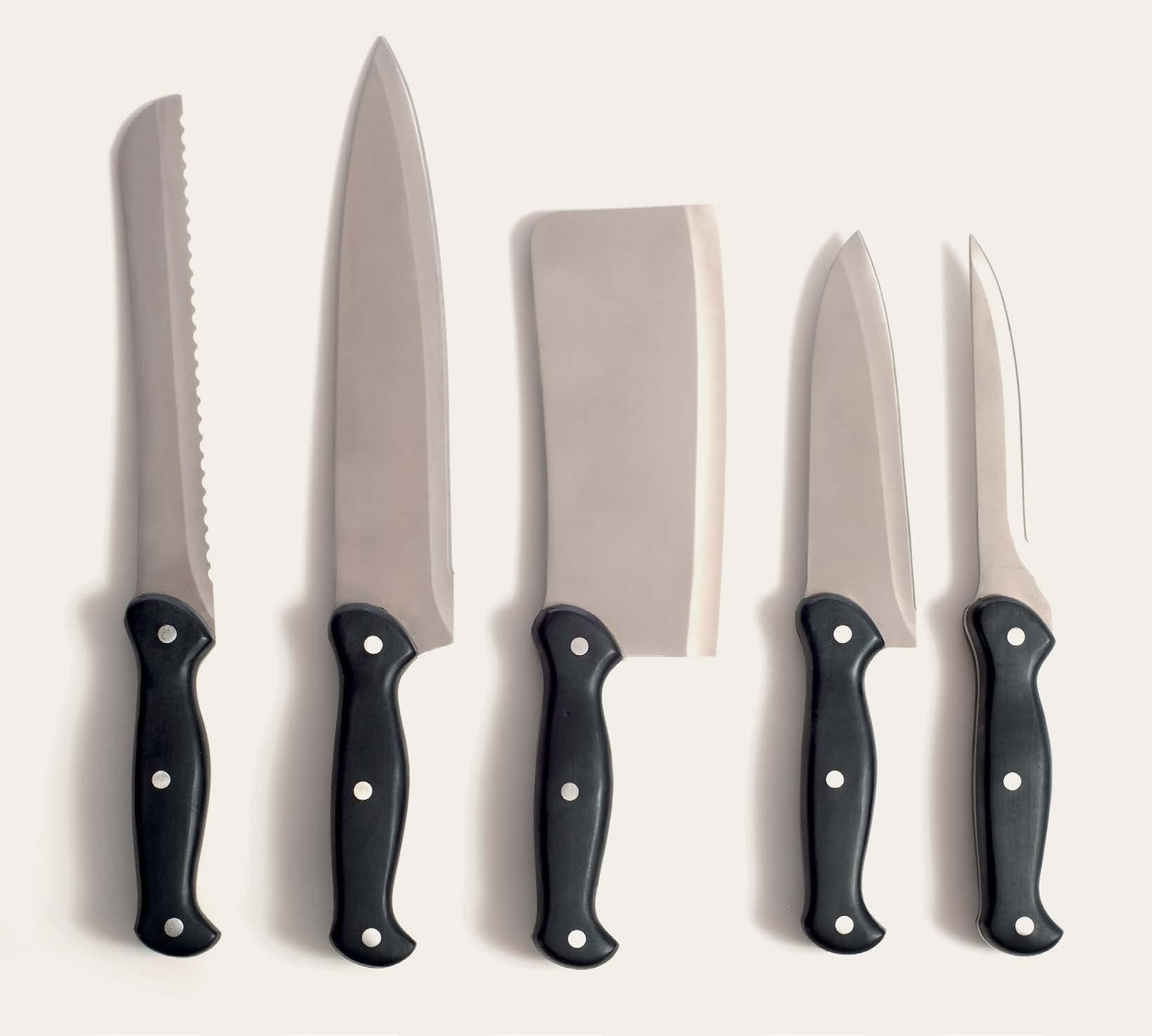














It is a pleasure to present you to the South Australian Food & Beverage Users’ Guide, a go to resource to assist you in sourcing some of the very best quality food and beverages that our great State has to offer.

This guide is your gateway to explore a diverse range of fresh produce from wine and cured meats to citrus and grains. Let this guide expand your knowledge of the premium products that South Australia grows and produces.
From the home to the hospitality industry, this guide has been designed to assist home cooks, chefs, retailers, caterers, and venues to locate and access South Australia’s premium food.
By using this guide, you are selecting the very best that South Australia has to offer.
But what sets South Australian goods apart from others?
The answer is simple, and comes down to, two simple reasons: our idyllic environment and hardworking South Australians.
Everything in this guide has been grown and produced in South Australia and sourced from our clean and green environment.
Customers here, and globally, are increasingly conscious of the environment of where their food and beverages are produced, and our State’s natural advantage drives our reputation for premium fresh, sustainably sourced food and beverages.
But like any good business, it is hardworking people that make this happen.
The South Australian food and beverage industry is a key export sector for the South Australian economy. In 2021-22, South Australian food and beverage businesses exported $6.4 billion, up 17.3 per cent from 2020-21, representing almost 44 per cent of South Australia’s exports over the period. Strong exports are underpinned by strong domestic demand.

So, not only will you be enjoying some of the world’s best produce, but you will also be supporting one of South Australia’s most important industries.
The only thing to left to do is to taste South Australia (and enjoy)!
“OUR SUSTAINABLE PRACTICES ENSURE WE EFFECTIVELY MAKE THE MOST OUT OF OUR CLEAN WATER, AIR & LAND.”

Food South Australia is South Australia’s peak food industry association – growing value, opportunities and connections for members and whole of industry, by delivering key services and programs to grow markets, capacity and connections through our offices in Adelaide, Japan and China.
Reception: Plant Research Centre, Waite Campus, 2b Hartley Grove, Urrbrae SA 5064
Post: PO Box 124, Glenside SA 5065
Phone: +61 (0)8 8303 9435
Fax: +61 (0)8 8303 9424
Email: contact@foodsa.com.au
Web: foodsouthaustralia.com.au
Facebook: /foodsouthaus
Twitter: @foodsouthaus
Instagram: @foodsouthaus

Food South Australia is supported by Brand SA with $200,000 of funding for 2022-23, in an industry and Government collaboration managed through the Department for Trade and Investment, designed to raise the profile of South Australian businesses and guide consumer choices to buy South Australian products and services to assist industry growth.
Reception: Level 8, 250 Victoria Square/Tarntanyangga, Adelaide, South Australia 5000
Phone: +61 (0)8 8235 5400
Email: DTI.BrandSA@sa.gov.au
Web: dti.sa.gov.au/state-brand
Facebook: /brandsouthaus
Instagram: @brandsouthaus
South Australia’s 984,377 square kilometres incorporate diverse micro climates and regions, growing and producing an extraordinary range of food and wine.
Located centrally on the Australian continent, South Australia is the nation’s fourth largest state by size. The capital city, Adelaide, is home to most of the state’s 1.83 million population.
South Australia is surrounded by pristine land and sea, and enjoys a Mediterranean climate.
Food and beverage are the backbone of the South Australian economy - the economy, workforce, regions, health, environment, communities, as well as every individual, depends on a healthy industry.
The majority of South Australian food and beverage manufacturers and producers are small to medium companies, often owner operate
and family owned. This is the state that honours tradition - but mizes it with openness to innovation, a winning combination underpinning dozens of food and beverage business success stories.
South Australia produces food and beverage of exceptional quality, appreciated across Australia and around the world.
THE SOUTH AUSTRALIAN FOOD USERS’ GUIDE IS AN INITIATIVE OF THE PREMIUM FOOD AND WINE FROM OUR CLEAN ENVIRONMENT PRIORITY.






Using local and seasonal ingredients in your restaurant or cafe menu is of utmost importance.

It fosters a connection with the community, supports local farmers, and reduces the carbon footprint by minimising transportation. By sourcing fresh, in-season produce, you ensure the highest quality and flavour for your dishes.
It also encourages creativity, as you constantly adapt your menu to showcase the best ingredients available, providing a unique and authentic dining experience.
• Use the specials menu to promote premium examples of local and in season produce.
• Theme a selection of specials around local food that is in season and at its best.
• Co host a product launch or help celebrate a big producer event.
• Build relationships by helping producers share and celebrate their story with a wider audience - it adds to your menu’s integrity.
• Find a space in the restaurant to display or sell producer brands and products you use in your menu. This grows the connection between what is on the customer’s plate and where it comes from.
• Visit food regions, see where the produce comes from, increase your knowledge about where and how food is produced, and pass that knowledge on to your staff and customers.
• South Australian hospitality venues who identify South Australian food and beverages on their menu, are able to join the EatDrink Local SA. Visit eatdrinklocalsa.com.au to find out more.
Salopian Inn is a shining example of embracing the principles of eating local. They prioritise seasonality and support local producers, resulting in a constantly evolving menu. By showcasing the best of each season’s local offerings, they provide diners with fresh, flavourful dishes. This commitment to local ingredients not only supports the community but also ensures a unique dining experience that celebrates the richness of the region.

Olasagasti Anchovy + Gnoccho Fritto + Roasted Garlic Aioli + Pickled Peppers
Salopian Pie – Ellis Butcher Beef, Potato & Bechamel + Cheddar + Cauliflower Puree
Nomad Farm’s Roasted & Confit Chicken + Lentils + Pancetta + Pickled Jerusalem Artichoke
Paroo Kangaroo Tail + Sichuan Pepper + Chilli Caramel + Pickles + Coriander
Affogato with Vanilla Bean Ice Cream + Dawn Patrol Coffee
Basque Cheesecake + Boozy Winter Garden Plum + Sherry Caramel
Ice Cream Sandwich with Winter Almond Meringue + Chocolate Parfait + Honeycomb
Kangarilla T-Bone
Boston Bay Free Range Berkshire Pork + Ginger + Hoisin Steamed Buns
Wild Coorong Mullet + Vichy Carrots + Pickled Beetroot + Beurre Blanc Sauce + Garden Herbs
Salopian ‘Hopper’ – Coconut Pancake + Cauliflower Curry + Free Range Pickled Egg + Garden Pickles
4 Week Dry Aged 100% Grass Fed Steak + Charred Onions + XO Beef ‘Butter’ + Pepper & Brandy Jus

THE EATDRINK LOCAL SA PROGRAM HELPS PATRONS DISCOVER AND IDENTIFY THE PARTICIPANTS THAT CELEBRATE AND SUPPORT SOUTH AUSTRALIAN FOOD AND BEVERAGES.

Supporting South Australian food and beverages starts with knowing where to look and what to look out for. EDL SA points patrons in the right direction and offers a sense of confidence in knowing that when you see the EDL SA logo, you are supporting those who celebrate and champion the incredible food and beverages that are locally sourced and served here in SA.
The EDL SA program encourages both locals and visitors to get out and experience the tastes, aromas, freshness and seasonality of South Australia. The program also provides opportunities for both patrons and participants to connect with one another, share experiences, access information and be inspired by those that are serving the very best that SA has to offer.
South Australian produce?
Become a participant in the EatDrink Local SA Program. Not only will you be reaching a wider audience of patrons and local food and beverage lovers, you will have the opportunity to connect and collaborate with a community of like minded venues, local producers and EDL SA ambassadors.
• Listed in our online directory
• Featured on our social channels
• Featured in email communications to our database
• Activation and event opportunities
• Opportunities to share promotional offers with subscribers
• EDL SA window decals and table top signage
• Opportunities to feature in videos and photo shoots
• Use of EDL SA professionally produced content
To be included in the EatDrink Local SA Program, you must serve on your menu at least three of the following: Main course or smaller dish with a hero local ingredient, a platter with 3 or more local ingredients, or four or more local beverages. Visit the website for more information.
eatdrinklocalsa.com.au
TURNING THEIR HANDS TO READY MADE PASTRY, LAMINGTONS AND ARTISAN BREADS, SOUTH AUSTRALIA’S BAKERS ARE ON THE RISE.

Gone are the days of mundane choices between “white or brown” sliced bread. The South Australian bakery realm has undergone a contemporary revolution, offering an extraordinary array of products that cater to ever-evolving palates and dietary preferences. South Australian bakers are on a relentless quest for perfection, gathering a devoted following in their wake.
Collaborating hand in hand, local millers and bakers craft flours that cater to sophisticated tastes and specialised needs, utilising both new innovation and age-old techniques that enhance the taste, quality, and texture of every loaf. Beyond traditional bread, bakers tantalise food lovers with a vast selection of delectables, ranging from delicate tart shells and enticing panfortes to exquisite tarts and restaurantworthy handmade pastries, catering to the needs customers and foodservice across the nation.
The demand for gluten-free options has surged, prompting the creation of an expanding repertoire of cakes, breads, and pastries that meet the discerning standards of the public. With South Australia as its base, the state stands at the forefront of numerous initiatives, thanks to the presence of major grain breeding institutions.
Embarking on a quest for excellence is a journey within reach. Whether you indulge in a flaky croissant crafted with the finest quality butter, savour the robust flavours of a sourdough masterpiece made with organic flour and local olive oil, delight in award-winning lamingtons, macarons, and hot cross buns, or revel in the hearty embrace of a caraway-speckled rye loaf, the reasons to celebrate this rapidly expanding locally based industry are aplenty.
In this flourishing landscape, flour mills in the state collaborate with bakers, crafting tailored flours that redefine the boundaries of culinary creativity.

PREMIUM LOCAL INGREDIENTS ARE READILY AVAILABLE FOR SOUTH AUSTRALIAN BAKERS.
SOUTH AUSTRALIAN BAKERIES ARE CRAFTING TRADITIONAL AND REVOLUTIONARY MOUTH WATERING CREATIONS, PUSHING CULINARY BOUNDARIES EVERYDAY.The state’s flour mills are working closely with bakers to create tailored flours.
South Australian bakery traditions differ in the regions, for example German styles are common in the Barossa.
• Specialties include Angus beef pies, beestings, Cornish pasties, Easter hot cross buns, frog cakes, German cakes and pretzels, Italian cannoli, lamingtons, macarons, sourdough and rye breads.
Handling
• Avoid big temperature changes.
• Some fresh baked goods, especially pastries, become soggy if heated too quickly.

• Unpackaged light cakes (those made from flour, sugar and egg) have a shelf life of only a few days.
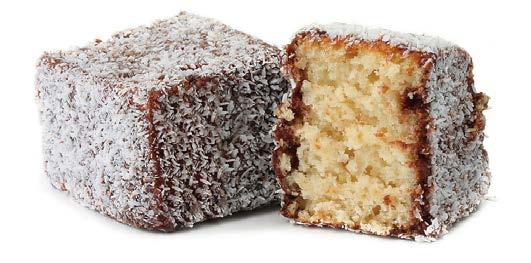
• Fruit cakes have a more dense structure and longer shelf life.
Storage
• Store bakery items, such as plain biscuits and fruit cakes, with no fresh dairy (cream, custard) in dry good storeroom, at 15-20°C for 1-2 months.
• Avoid refrigerating biscuits or plain cakes.
• Thaw most baked goods at ambient temperature.
• Store baked goods with fresh dairy at 0-4°C for 2-3 days.
• Store baked goods individually, to avoid taking on other flavours.
SOUTH AUSTRALIA’S BAKED GOODS ARE DISTRIBUTED NATIONWIDE, DELIGHTING TASTE BUDS ALL OVER THE COUNTRY.
STORE ALL YOUR BAKED GOODS INDIVIDUALLY, SO AS NOT TO TAKE ON FLAVOURS FROM OTHER PRODUCTS.
BREADS
Main categories of bread, according to base flour used, include:

• Multigrain
• Rye
• White
• Wholemeal.
• Variety of flour based breads produced daily:
• Artisan breads
• Flat breads
• Speciality dietary breads such as gluten free, spelt and high fibre

• Standard bread rolls, artisan, sweet and savoury rolls
• Traditional continental breads
• Traditional loaves
• Brioche
• Sourdough
Nutrition
• Most breads are low in fat and provide carbohydrates and protein.
• Good source of B vitamins including thiamin, niacin, and folate which are needed for energy release.
Multigrain
• Dark multigrain often uses wholemeal flour and added grains.
• Light multigrain often based on white flour with added grains.
Rye
• Rye breads are low GI and high in soluble fibre.
Soy & linseed
• Soy and linseed breads are high in fibre and offer additional source of omega-3 and folate.
• Often higher in fat due to added seeds.
Wholemeal & wholegrain
• Wholemeal and wholegrain considered higher source of these vitamins and fibre.
• Wholegrain is often low GI (grains slow carbohydrate absorption).
Handling
• Artisan breads and those made without preservatives are best consumed within 1-3 days of baking.
• Those with additional preservatives and additives will last a little longer.
Storage
• Store at ambient temperature, avoid refrigeration.
• Freeze for up to 2 months at -15ºC, and thaw at ambient temperature.
• Generally, best before date indicates the period the intact product is expected to perform to its stated potential, if stored correctly.
SOUTH AUSTRALIA BOASTS AN EVER GROWING OFFERING OF ARTISAN AND SPECIALITY DIETARY BREADS, DELIVERING A WIDE VARIETY OF CHOICES.
The largest volume of flour produced is used for bread baking.
• Most flour produced is made from medium protein hard wheats.
• Other flours, such as low protein flours, are made from soft wheats (used for products such as shortbread biscuits).
There are two main types of flour processes used in South Australia: Roller or steel milling
• The main milling process for all but specialty grains in South Australia.
• Produces a very fine flour by progressively grinding and sifting wheat into its component parts.
• Used for white flour, meals, semolinas, and by-products such as germ, pollard and bran.
• Wholemeal flour has all of the original components of the whole grain recombined. Stone milling
• Original form of milling.
• Uses large spinning stones to grind the wheat into flour.
• Stone milled flour contains a wide range of the components of the whole grain.

• Often chosen by artisan bakers for sourdoughs.
A significant portion of the flour produced in South Australia finds its way into both bread and pasta production, fueling a diverse culinary landscape.

Handling
• Flour matures with age.
• It reaches optimal performance several weeks after being milled.
• Remains stable for many months, depending on temperature and storage conditions (dry, colder storage conditions will extend shelf life).
Storage
• Protect from contaminants, such as insects and strong aromas.
• Keep away from extreme heat, excessive variation in humidity, and moisture and direct sunlight.
• In temperate regions, store in a dry goods storeroom or pantry for up to several months.
• Wheats, milled flours and pre-made bread mixes have a natural moisture content. Stabilises at 12-14% in original packaging.
• Beware of sealed plastic containers as natural moisture accumulates, leading to high moisture levels in the top layers of the flour. Use containers that enable it to breathe.
FLOUR MATURES WITH AGE AND REACHES OPTIMAL PERFORMANCE SEVERAL WEEKS AFTER MILLING.
In South Australia, understanding the origins and distinctive attributes of the ingredients you incorporate into your daily culinary repertoire adds depth to your food story. The realm of food processing and manufacturing, particularly in the bakery sector, thrives on an unwavering dedication to food safety and exceptional product outcomes, ultimately satiating the appetites of both a ravenous Australia and countless international enthusiasts.
To captivate and expand consumer interest, innovative growers, producers and bakers in South Australia are fearlessly delving into the realm of experimentation, crafting a vibrant array of new products. This entails harnessing the remarkable potential of ingredients such as lentil, chickpea, and hempseed to make flour, which together with more traditional flours, deliver unparalleled flavours and textures.
By embracing new ingredients, bakers not only push the boundaries of culinary artistry but also cater to the ever-evolving preferences and dietary needs of their discerning customers.
Bran is the hard, outer layer of the whole cereal grain. Fairly coarse bran is taken from specially selected wheats that confer a softness and flexibility that distinguishes it from normal bran.

Taste: Can have a sweet taste and soft texture.
Nutrition: High in dietary fibre, minerals and essential fatty acids that can cause it to spoil faster than whole wheat flours and grains.
Use: An attractive coating. Add to cereals, breads, cookies or muffins.
A granular flour that is taken from the endosperm of the wheat berry during the milling process. Available in fine, medium, dusting and coarse grades.
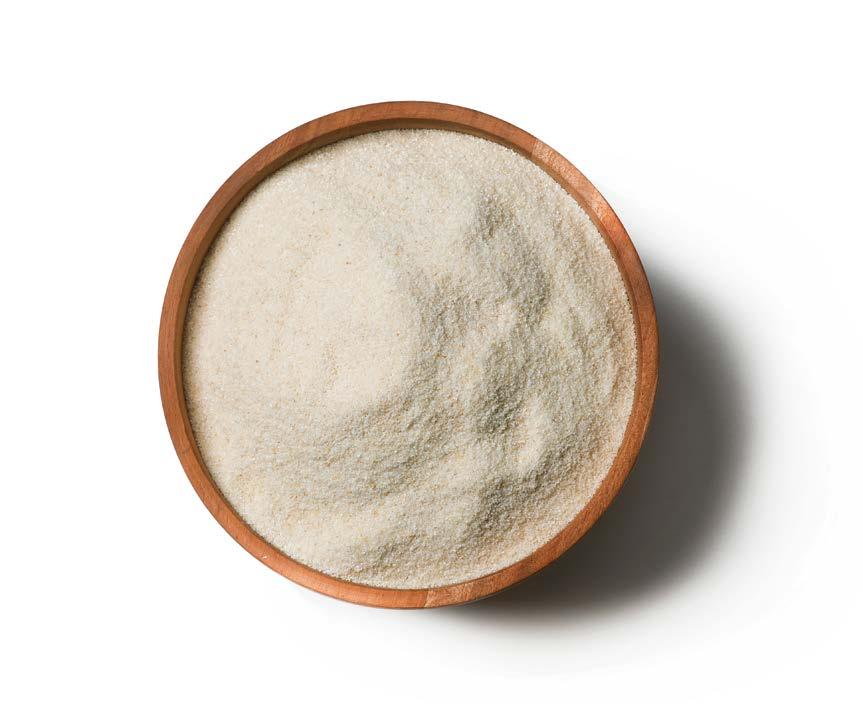
Taste: A neutral flavour but leaves a unique mouthfeel.
Nutrition: Very low in saturated fat, cholesterol and sodium. A good source of thiamin, folate and selenium.
Use: Medium semolina is often used in continental breads. Durum semolina is used in pasta making due to high gluten content. Medium semolina is ideal for fresh and dried pasta, and can be added to desserts and puddings.
Flattened, softened grains of malted wheat. Malting process sees selected grains steeped in water, germinated, spread out then dried by hot air. This converts the carbohydrates to sugars, which caramelise during drying, and provides malt flavours.

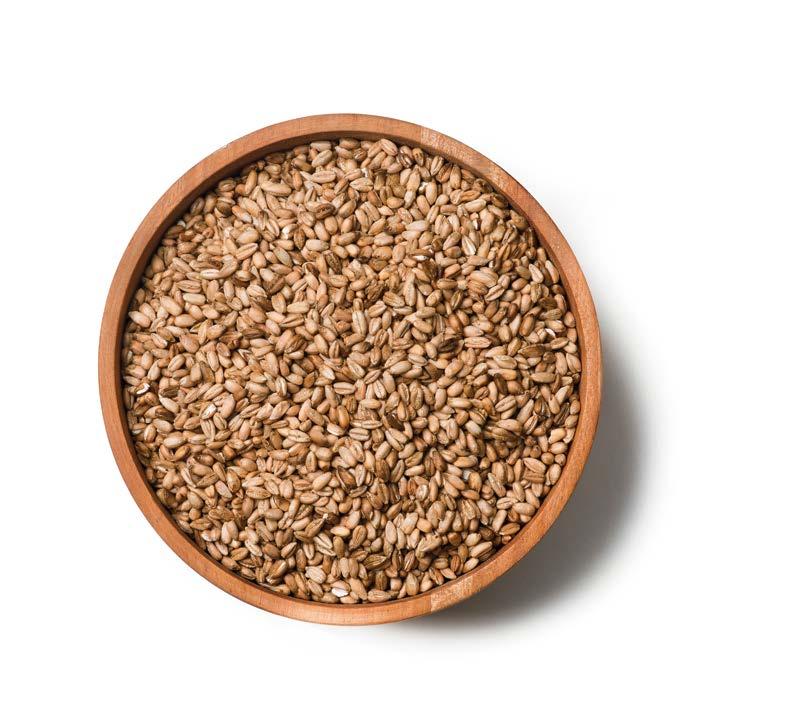
Taste: Subtle malty smell and flavour, with chewy texture.
Nutrition: Antioxidants, fibre, B vitamins, minerals.
Use: An attractive inclusion in breads, especially granary and artisan style breads. Can eat raw. Add to cereals, muffins or biscuits.
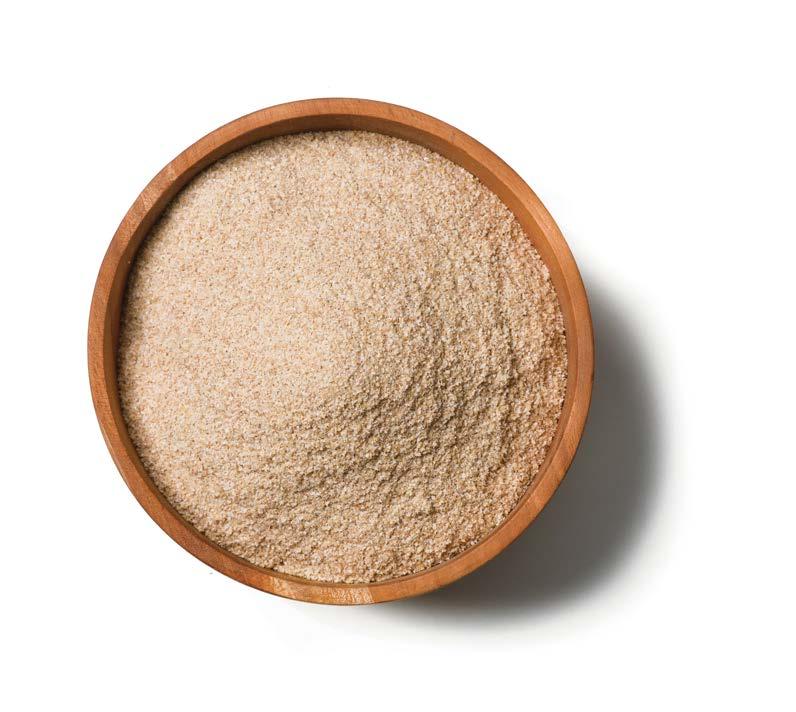

A cereal grain that looks like wheat but is longer and more slender. Available as whole, cracked grain form, flour or flakes that look similar to old fashioned oats.Wholemeal and white varities available.
Taste: Can have slightly sour flavour. Its gluten is less elastic than wheat, so rye holds less gas during leavening process. This makes breads made with rye flour more compact and dense.
Nutrition: More nutrients than refined wheat flour. Excellent source of fibre. Recommended for people with high blood pressure, cholesterol or diabetes.
Use: Sourdough starters, rye breads, coating for decorating doughs, substitute for wheat flour in pancake, muffin and bread recipes.
Finely milled heart of the wheat berry. Fresh wheatgerm can be unstable so best acquired as fresh as possible to prevent it going rancid.
Taste: Nutty flavour.
Nutrition: Considered the powerhouse of the wheat kernel. High in protein, contains 23 nutrients, including potassium, riboflavin, calcium and zinc.
Use: A health supplement in cereals and dietary products, a replacement for breadcrumbs, added to smoothies and breakfast cereals.
Rye grains are soaked then vacuum dried, causing grains to puff up and soften. Pre-softened whole rye can be used as a full grain inclusion. Is specially prepared to reduce risk of dental damage sometimes experienced with normal cracked or full grains.
Taste: Has a rich, hearty and slightly sour flavour.
Nutrition: Excellent source of dietary fibre, vitamin E, calcium, iron, thiamin, phosphorous, potassium. Lower gluten than wheat but still not suited to coeliac diets.
Use: Wholegrain breads, rolls, crackers, muffins, biscuits, granola type bars, snack mixtures, breakfast cereals or dried soup mixes.
IN SOUTH AUSTRALIA, BEVERAGES SPAN BEYOND THE REALM OF TRADITION, WITH OLD-FASHIONED CORDIALS, REAL MILKS, AND JUICES REIGNING SUPREME.

When it comes to flavoured drinks, South Australians can raise a glass to some iconic and much loved products, from traditional, authentic cordials to ultra creamy iced coffees and milks.
The state is home to well loved beverage companies that produce hundreds of beverages, including cordials, juices and carbonated soft drinks as well as spring and flavoured waters.

Thousands of tonnes of oranges from the state’s fertile Riverland orchards are used to produce fresh, frozen juices and drinks each year.
Small, specialised dairy farmers produce organic and biodynamic fresh and flavoured milks from happy Friesian and Jersey herds.
Old fashioned cordials, such as sarsaparilla, raspberry, lime and clove, are another specialty; great for both refreshing drinks and in jellies, flavourings and fermented beverages.
The state is also home to some of the most awarded and finest wine producers in the world, it has a burgeoning craft beer and cider sector as well as specialty distillers that are mixing age old traditions with contemporary style to meet growing consumer demand for distinctive regional flavours.
A common theme in the beverage industry is integrity of ingredients, whether it is milk from Jerseys that is creamy and rich, a cordial made
from a generations-old recipe, world leading research into grains that create tasty beer, or juice bursting with flavour from some of the country’s best citrus. Coupled with innovative production and premium ingredients, any thirst you may have for quality and creative beverages is sure to be suitably quenched.
ARTISAN CORDIALS ARE NOT ONLY REFRESHING BUT ALSO SERVE AS VERSATILE FLAVOURINGS.
Variety
• Alcoholic beverages (excluding wine) produced include:

• Beer
• Cider
• Spirits.
• Minlaton, on the Yorke Peninsula, is known as the ‘barley capital of the world’, helping create premium beer and cider.
• Premium apples and pears for cider mostly come from the Adelaide Hills, Riverland and Limestone Coast.
• Boutique distillers now produce brandy, whisky, gin, vodka and specialist liqueurs featuring local aromatics and flavourings.
Nutrition
• Beer contains more antioxidants, protein and Vitamin B than wine.
• Cider made with premium apples doesn’t require added sugar, and is gluten free and vegan friendly.
• Gin with tonic makes alkaloids in the tonic more available to the body, hence its effective use as a remedy for the fever associated with malaria.
Market
• Most beers are available through national and state based distributors.
• Ciders are available through national distributors.
• Boutique spirits are available through specialist distributors and online.
Handling
• Gently roll, rock or tip beer and cider bottles before serving to stir sediment.
• Most liqueurs can be stored in the freezer so they are chilled before service. Freezing also helps maintain consistency and colour.
Storage
• Use beer and ciders within 30 days to ensure freshness.
• Keep beer chilled around 0-4°C
• Always store bottled beer and cider upright on their bases to ensure sediment settles at the base.
• Most clear spirits can be stored at room temperature in a sealed bottle, and can last for years.
• Store beer, cider and spirits in a cool, dark and dry environment, with no bright light as this can impact taste.
SERVING SUGGESTION
• Use a craft brewed dark or black ale for a light, crunchy batter for seafood, producing a distinctive deep colour.
• Gin can make for a unique palate cleanser.
Beer contains more antioxidants, protein and Vitamin B than wine.
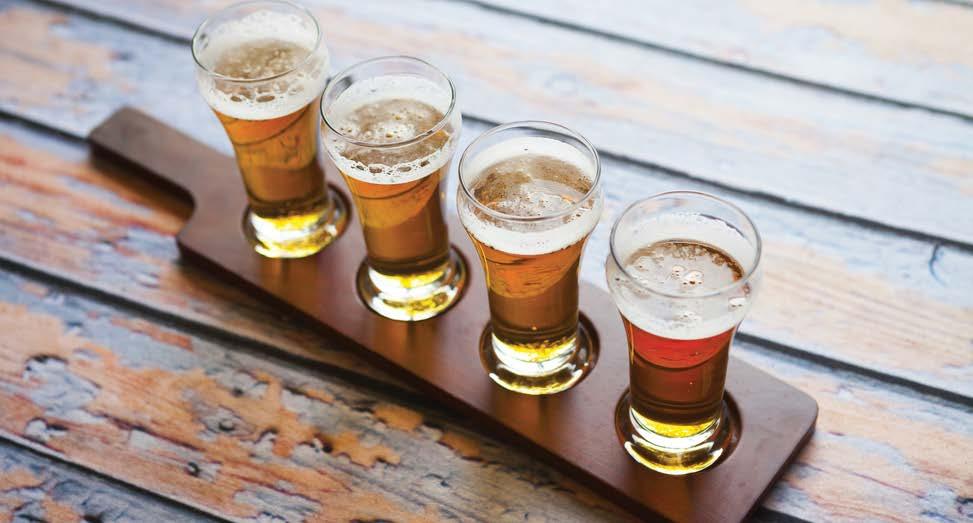
WINEMAKING, BREWING AND DISTILLING WERE AMONGST THE EARLIEST INDUSTRIES TO BE ESTABLISHED IN SOUTH AUSTRALIA.
COFFEE, CORDIALS, JUICE, MILK DRINKS, ALCOHOL ALTERNATIVES, SOFT DRINKS, COFFEE, TEA & WATER
Variety
• Beverages produced include:
• Coffee
• Cordials
• Fresh and long life fruit juices
• Milk and flavoured milks
• Soft drinks
• Tea
• Water.
• Several coffee retailers roast and sell, many based in Adelaide.

• Much of the citrus fruit used in juice, fruit syrup and concentrates is sourced from the Riverland.
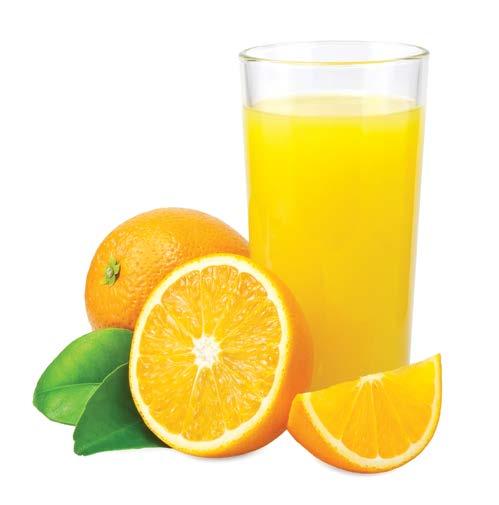
• Milk drink producers source milk mostly from Friesian and Jersey herds.
• Several tea retailers blend and sell their own products.
Nutrition
• Alcohol alternative drinks offer nutritional benefits without compromising on flavour or enjoyment.
• Milk is a good source of calcium as well as protein, Vitamins B, A and D.
• Black tea contains antioxidants.
• Some herbal teas have health benefits such as lowering cholesterol and boosting immune system.
Market
• Most beverages available via national or state based distributors.
• Several supply direct to restaurants and foodservice outlets.
• Most milk and juice providers supply daily or weekly orders.
Handling
• Refrigerate all beverages (except tea, coffee), including concentrates and mineral waters, after opening.
• Coffee grinds vary on type of appliance used. Generally a fine grind suits stovetop and espresso machines, medium for plungers and coarse for machines with mesh filters.
• Fresh milk drinks are at their prime when consumed nearest the manufacturing date.
• Keep flavoured milks away from direct sunlight.
Storage
• Ground coffee best consumed within two weeks of grinding. Whole beans best used within one month.
• Keep fresh fruit juices refrigerated at 0-4°C for up to one week.
• Unopened long life juice products, cordials and concentrates can be stored at ambient temperatures for 9-12 months.
• Keep flavoured milk refrigerated at 0-4°C in original packaging for up to 10 days, in accordance with best before dates.
• Temperature fluctuations shorten shelf life of milk products.
• Avoid freezing flavoured milk, as it can destabilise the main protein, casein, and will look slightly curdy when thawed.
• Store tea in airtight containers in a cool, dark pantry for up to 12 months.
THE SECTOR OF LOW AND NONALCOHOLIC BEVERAGES IS EXPERIENCING RAPID GROWTH.There are many coffee roasters and tea blenders based in Adelaide.
THANKS TO CUTTING-EDGE TECHNOLOGY, INNOVATIVE APPROACHES, AND THE EXPLORATION OF NEW REGIONS, THE GRAIN INDUSTRY HAS WITNESSED A SIGNIFICANT INCREASE IN OUTPUT AND CROP SIZE.


South Australia’s grain yields reach unprecedented heights as farmers push boundaries, introducing premium products like organic flours and stone-milled pasta, while exploring the potential of pulses and seeds.
South Australian pasta is exported to a range of countries, including Italy along with malt used for beer that is exported to Belgium.
South Australia produces about 12.5 million tonnes of grain and cereals each year, worth around $5.6 billion, of which 60% to 80% is exported.
The overall output has continued to increase, thanks to better technology, more land becoming available for growing and good rainfall.
South Australia’s largest pulse crops include field peas (113,550 tonnes), broad and faba beans (318,800t), lentils (527,250t), lupins (124,650t), chickpeas (81,650t) and pearl barley. Combined, they are worth around $191 million at the farmgate.
A handful of pioneers are driving value added industries, such as wholegrain stone milled pastas, non-GM canola and Kosher certified organic grains.
Whatever the grain, South Australian producers are making the most of our temperate climate and the latest innovations to create quality products to inspire menus and chefs all around the world.

SOUTH AUSTRALIAN PASTA IS EXPORTED TO A RANGE OF COUNTRIES, INCLUDING ITALY.Stone milled flour is used to produce a range of flours and wholegrain pastas.
Annual grain, malt and cereal crops grown in South Australia include:
• Bread and durum wheat (7.47 million tonnes)
• Malt barley (3 milliont)
• Oats (230,00t)
• Rye (16,250t)
Annual oilseed crops include:
• Canola (684,000 tonnes)
• Linseed
• Sunflower
Annual pulse crops include:
• Beans (faba and broad) (318,800t)
• Chickpeas (desi and kabuli) (81,650mmt)

• Field peas (137,550mmt)
• Lentils (527,250mmt)
• Lupins (124,650mmt)
Region
• Bread and durum wheat, and other cereal, pulse and oilseed crops are grown across Eyre and Yorke peninsulas.
• Wheat and barley grown across southern agricultural region.
• Quality high protein wheat grown in Clare Valley, Eyre Peninsula, Murray River, Lakes and Coorong.
• Malting barley, some wheat, pulse (notably broad, faba beans) and oilseeds, such as canola and linola (food grade linseed or flax) grown in Limestone Coast and Kangaroo Island.

• Some of Australia’s prime malt barley crops are grown in Eyre and Yorke peninsulas.
• A small amount of spelt is grown in the Limestone Coast.
Season
• Wheat crops harvested November to December.
• Canola and barley are first harvested October.
• Most late season crops, such as lupins, finish harvest mid January.
• Domestic market supplied year round.
market
• Most grains sold in wholegrain form to third-party processors for a range of products, including flours, oils and beer.
• Large proportion of South Australian grain production sold in export markets.
• A range of grain based processed products are exported, including beer, malt and pasta.
• Specialist raw produce, organic and health food stores stock a wide range of raw grains, seeds and pulses in pre-packaged and unpackaged containers.
Application
• Much of South Australia’s grain crops sold in domestic markets is used in confectionery, breakfast cereals, bread, biscuits, pasta, flour, margarine, beer and canola oil.
• Durum wheat is known for its high semolina yield when milled (ie, low semolina ash and low residual flour yield).
• Durum wheat also yields high levels of quality gluten.
• South Australia is the second largest producer in Australia of barley (about 30% is malting barley).
• Malt is used for local and interstate beer production and exported overseas.
• Some pulse crops are used to make gluten free flour, dhals, dips and other pulse products.
• Store grains, malts, seeds and pulses in raw form 6-12 months.
• Keep raw grains away from direct sunlight.
• Grains, seeds and cereals should be kept in airtight containers, in a cool, dark area of dry goods storeroom.
A LARGE PROPORTION OF SOUTH AUSTRALIAN GRAIN PRODUCTION IS SOLD TO EXPORT MARKETS.
PASTA &
Most pasta is manufactured with durum wheat, known for its hardness, protein, nutty flavour and excellent cooking qualities.
• Other grains used for pasta flour: spelt or gluten free grains such as corn, quinoa and rice.
• Noodles made from softer bread wheat variety as well as buckwheat, mung beans, soy beans, rice and even sweet potato flour.
types
Couscous
• Made by mixing semolina (coarsely ground durum wheat) with water, then shaped.
• Lower GI than traditional durum wheat pasta.
Egg pasta & noodles
• Ingredients include eggs and will often use a softer wheat variety than in traditional Italian style pasta.
• European style egg noodles and pasta are often shorter, thicker and smaller than Asian or traditional Italian styles.
• Egg noodle pasta and noodles will often have a yellow colour and firmer texture.
Gluten free pasta
• Primary ingredients in place of flour including brown rice, corn, a combination of corn and quinoa, potato and soy beans.
• Can have chewy texture.
• Care needed not to overcook.
• Thick, soft, dumpling shaped pasta made from semolina, wheat flour, or flour and egg.
• Can also be made from potato, ricotta and grated vegetables. Soy-based pasta
• A low carbohydrate alternative made with soy flour.
• Soy flour is high in protein and lecithin.
• Usually suitable for vegans.
Wholemeal pasta
• Made from durum wheat semolina with bran and germ intact.
• Can have coarser texture and more nutty, earthy flavours.
• Higher in fibre and protein than other pasta varieties.
Nutrition
• Pasta and noodles are a good source of protein, B vitamins (notably Vitamin B, needed to release energy from food) plus small amounts of iron and calcium.
• Also low in fat and high in starchy carbohydrates (great muscle fuel).
• When cooked al dente (firm to the bite), pasta has low GI. Most noodles have low or moderate GI.
Handling
Dried
• Cook thin dry durum wheat pasta (shells, rotini) for 6-9 minutes.
• Cook thick durum wheat pasta (penne, tortellini etc) 12-15 minutes.
FRESH PASTA MADE WITH EGGS CAN BE KEPT IN AN AIR TIGHT CONTAINER FOR UP TO FOUR DAYS. IT COOKS IN 3-5 MINS.

• As a guide, 100g of dry pasta yields about 240g of cooked pasta, depending on the cooking method and pasta thickness.
• Measurements change depending on pasta thickness, cooking texture considered al dente and amount of salt used.
Fresh
• Cooks quickly 3-5 minutes, especially egg pasta.
• Do not rinse, unless using for cold salads or setting aside.
• Fresh pasta made with eggs absorbs more water than dry pasta.
• 400g of fresh uncooked pasta yields about 680g cooked pasta.
Frozen
• Do not thaw, can cook frozen.
• Some styles such as tortellini and ravioli expand up to 50%, so leave room in pot.
• Cook for about 5-7 minutes.
DURUM WHEAT IS USED FOR MOST PASTAS CREATED IN SOUTH AUSTRALIA.
Storage
Cooked
• Can be frozen for 2-3 months at -15ºC.
Dried
• Stored in an airtight container in a cool, dry place, will keep almost indefinitely.
Fresh
• When made with eggs, is highly perishable. Refrigerate in airtight container up to four days at 0-4°C.
• Fresh uncooked pasta can be frozen for up to a month at 15ºC.

Serving
• More than 300 shapes of pasta, in five main categories:
• Flat or shell pasta: Macaroni, lasagne and cannelloni; great for baking.
• Long pasta: Fettuccine, spaghetti and linguini; goes well with light, creamy or pesto based sauces.
• Pouch or pocket style pasta: Ravioli, tortellini and agnolotti; suited to stuffing with meat or vegetable ingredients.
• Short pasta: Penne, fusilli and rigatoni; goes well with thick and chunky sauces.
• Small pasta: Ditalini and orecchiette; great added to soups.
• Some of the main noodle varieties:
• Buckwheat or soba noodles: Often a mix of buckwheat and wheat flours; great in stirfrys or salads.
• Egg noodles: Use similar to traditional pasta; great with thick or creamy sauces. Short egg noodles can also be added to salads.
• Mung bean noodles: Also known as cellophane or glass noodles; great in Asian style broths or stirfrys.
• Rice vermicelli and rice stick noodles: Only need to soak in boiling water before use; great used in spring rolls.
• Wheat flour noodles: Somen and udon noodles; great in miso soups or paired with steamed vegetables and fried tofu.
Renowned for its exceptional grains, South Australia boasts prime farming lands, notably across the Yorke Peninsula, acclaimed worldwide for their dependable cereal, lupin, and oilseed crops. As food processing and consumer interest expand, the markets for more diverse grains and their versatile applications thrive. This masterclass provides a small glimpse into our abundant harvest.
• South Australia grows predominantly faba beans.
• Small amount of broad beans grown in the Limestone Coast and on Kangaroo Island.
Nutrition
• Faba and broad beans are a good source of carbohydrate and protein and low in fat.
Use
• Faba beans have a chewy texture after cooking. Soak before cooking.
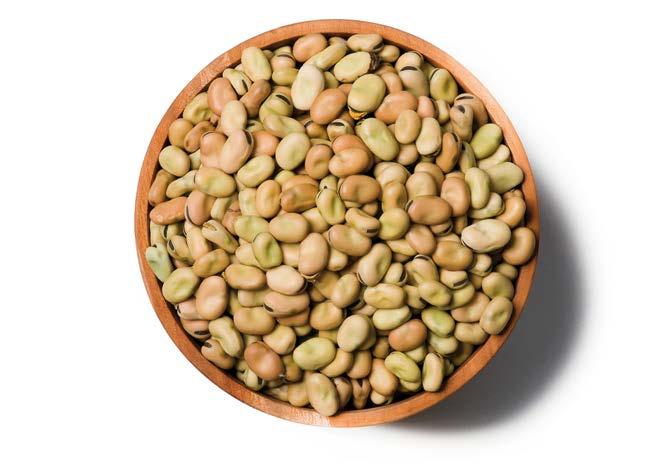
• Shell large broad bean seeds before eating.
• Purée, boil, mash, add to casseroles, use to thicken sauces, and in soups, dips and salads.
• Healthy alternative to thicken puréed soups.

• South Australia is the second largest malt barley producing state in Australia.
• Malted barley is produced when raw barley is steeped, germinated and kilned to change the raw barley seed into a friable biscuit-like texture.
• Further processing converts malt into fermentable sugars, and returns shape and look of original grain.
• Malt colour varies according to level of roasting.
Nutrition
• High in B vitamins, lots of minerals and some fibre and protein, although less protein than whole barley.
Use
• Majority used in brewing industry for beer production. Black malts used in dark beers (stout, dark ales) and light malts used in lagers and pilsner-style beers.
• Malt extract used as a sweetener and sticking agent in breakfast cereals and other foods.
• Seed coat ranges from light grey through brown to black.
• Distinctive orange/red kernel seen when seed is dehulled or split.
• Seed varieties range in diameter 2-6mm.
• Size and shape can affect ease and yield of splitting.
Nutrition
• Lower in fat than chickpeas and good source of iron.
Use
• In curries, Indian dhal and lentil soup.
• Lentil flour is used to make pappadams or added to cereal flour to make breads, cakes and baby foods.
• Immature pods and sprouted seeds eaten as a vegetable.
• Lentils have a shorter cooking time than other pulses.

• Field peas are the largest pulse crop in South Australia.

• Field peas vary by kernel, seed coat colour and shape.
• The major field pea varieties grown in South Australia can be divided into three groups:
• Blue Round: translucent seed coat and green kernels. Often used in canning.
• Dun Dimples: greenish-brown (dun) coloured variety with yellow kernel. Most common type grown in South Australia, used for split peas and flour products.
• White Round: cream coloured varieties with yellow kernel. Often used to split and in flour.
Nutrition
• Field peas are an excellent source of protein and energy.
Use
• Usually split (dhal) and packaged for use in soups and stews.

LUPIN
• The major crop in Sourh Australia is the narrow leafed or Australian Sweet Lupin.
• Small amount of white lupin also grown.
Nutrition
• High in protein and dietary fibre.
Use
• An alternative to dry and soya beans.
• Ground for flour, fermented to produce high quality tempeh or as a snack food.
• To make protein concentrates or fermented sauces.
• White lupin is often preferred variety for food.
• Lupins have low moisture content and hard seed coat, which makes them long lasting.
RYE
• Small crop in South Australia.
• Grown mostly in the Murray River, Lakes and Coorong, where the crop is grown to protect sandhills from wind erosion.
• Triticale grain is rye hybridised with wheat, sometimes added to wholegrain mixes for breads.

Nutrition
• Has a lower gluten content than wheat flour.
• Contains higher proportion of soluble fibre.
Use
• Grain used for flour, bread, beer, whiskey and vodka.
• Eat whole as boiled, either as rye berries (kernels) or rolled.
• To make crisp bread.
WHEATS
There are a variety of wheats grown in South Australia.
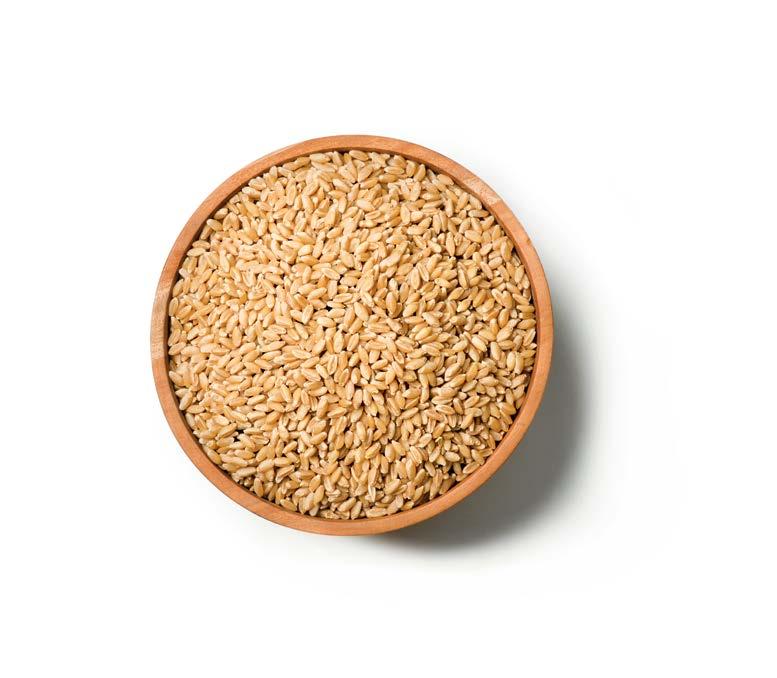
Australian Hard (Bread wheat)
• Relatively high in protein.
• Well suited for pan and flat breads, steamed food products.
Australian Premium White (Bread wheat)
• Lower in protein than Australian Hard.
• Often used in Middle Eastern and Indian flat breads.
• Also well suited to Asian baked products and noodles.
Australian Standard White (Bread wheat)
• Mainly produced in southern cropping areas.
• Medium to low protein.
• Ideal for Iranian, Middle Eastern and Indian breads.
Australian Soft (Biscuit wheat)
• Grown in high rainfall areas including Kangaroo Island.
• Low in protein.
• Used in a wide range of baked and processed products including sweet biscuits, cookies, pastries and steamed buns.
Australian Durum Wheat (Pasta wheat)
• High in protein.
• Suitable in wide range of pasta products, couscous and semolina.
SOUTH AUSTRALIA IS HOME TO A TREASURE TROVE OF READY MADE TREATS, FROM HONEY AND OLIVES TO CHOCOLATES AND DUKKAH.

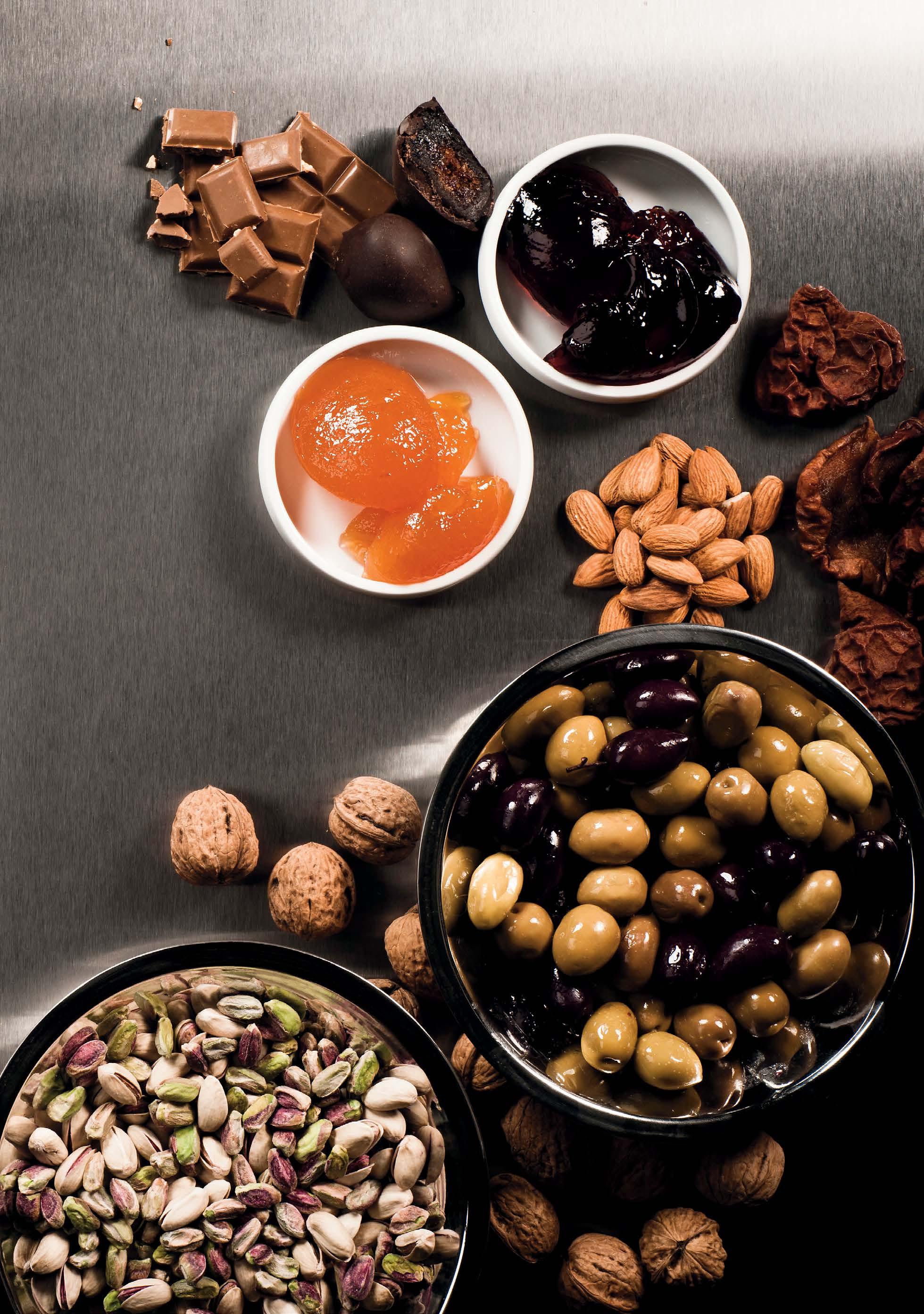
Within South Australia’s culinary landscape, iconic new and established brands have sparked a surge of new take-home products, enriching the market with their exceptional offerings. From delectable fresh pasta meals to jams, chutneys, and confectionery, the region’s premium, meticulously crafted food products have gained prominence.
With a focus on flavour and convenience, producers have introduced a range of readymade meals, spice mixes, sauces, vinegars, and other condiments, empowering busy kitchens to effortlessly infuse their menus while freeing up time for other priorities.
Meanwhile, boutique producers have emerged, showcasing their expertise in an array of processed foods, including pâtés, dips, oils, dressings, herbs, spices, olives, capers, meat products, honeys, marinades, snacks, and nuts. Additionally, gluten-free and fresh pasta products from various suppliers are catering to the discerning needs of hotels, cafes, and restaurants.
An exciting aspect of the state’s culinary scene lies in its indigenous producers, who cultivate ingredients to infuse native Australian flavours into dishes and offering a unique taste experience. These native ingredients bring a rightful and distinctive touch to the table, celebrating the rich cultural heritage.
South Australian exports are highly sought after, due to the region’s pristine environment, quality ingredients, and innovative production methods. The handcrafted nature of these high-quality ready-made products provides chefs with exceptional alternatives that grant greater flexibility and time within their kitchens, without compromising on quality.
AUSTRALIA’S FORWARD-THINKING CONVENIENCE PRODUCTS ELEVATE CONSUMER CONVENIENCE, RELIEVING THE BURDEN OF HARD WORK WHILE DELIVERING EXCEPTIONAL CULINARY EXPERIENCES.
South Australia is famous for:
• Capers
• Dips
• Fruit pastes
• Honey
• Jams
• Patés
• Preserves
• Sauces
• Vinegars.
• Most fruit and vegetables used in these products are sourced from South Australia.
region
• Producers are based across most regions.
Season
• Available all year.
• Many influenced by seasonal produce and conditions (eg, size of harvest).
• Capers handpicked every eight days during summer (December to February).
• Honey harvested October to March.
Market
• Several large brands available nationally and exported.
• Wide range of products sold via national or state based distributors.
• Some producers supply direct to restaurants and foodservice outlets.
Handling
• Capers should be firm and moist.
• Capers complement anchovies, basil, chervil, cream, garlic, fish, eggplant, eggs, lamb, parsley, pork, poultry, shellfish, tarragon and tomatoes.
• To reduce intensity, capers can be rinsed and soaked in warm water.
• Dips are best served at ambient temperature unless packaging suggests otherwise. Some yoghurt based dips can be served chilled.
• Honey can be used to add flavour, colour and sweetness to any food or drink where sugar is used.

• If honey crystallises, reliquify it by gently heating the jar in a pan of hot water, stirring while heating. Do not overheat as this may caramelise sugars, altering flavour and colour.

• Paté should be served chilled.
Storage
• Freezing is not recommended for most condiments.
• Capers, sauces, jams, honey and preserves will last several months kept in cool and dark conditions.
• Fresh dips and patés, especially those made without preservatives, should be stored in a refrigerator at 0-4°C and consumed within 2-3 days.
CONFECTIONERY
South Australia is home to large iconic brands and several well known artisan producers. Confectionery produced includes:
• Carob
• Chocolate
• Dried fruit
• Fruit bar segments
• Lollies
• Processed nuts.
region
• Two of Australia’s largest carob orchards and producers are based in Clare Valley and Fleurieu Peninsula.
• Processed fruit and nuts segment sources some raw product from the Adelaide Hills, Fleurieu Peninsula and Riverland.
Market
• Several brands provide bulk products direct to restaurants and foodservice outlets.
• Some confectionery available nationally and overseas.
Handling Chocolate
• Most chocolates should be served and stored at ambient temperature.

Dried fruit
• Most treated with the preservative sulfur dioxide, to protect from mould and retain full colour.
• Small amount of dried fruit is available as sulfur dioxide free product.
• Fruit that has been sulfured should not touch metal. Sulfur reacts with the metal and can cause colour changes in the fruit.
• Dried fruits best packed in amounts that will be used all at once. Exposure to air and moisture regularly can affect quality.
Storage
• Store most confectionery products in airtight containers in cool, dry, dark areas 4-12 months.
Chocolate
• Optimum holding temperature for chocolate and carob is 15-20ºC.
• Chocolate should be stored in cool dry cupboard, with low humidity. and away from direct heat or light, and products with strong odours.
• Only refrigerate chocolate in extreme weather conditions, and keep in an airtight container or double wrap to protect from odours.
Dried fruit
• Pack dried fruit in sealed containers, as tightly as possible without crushing.
• Most dried fruits can be frozen for up to a year at -15°C.

Processed nuts
• Store nuts in airtight container at 7°C.
• Keep nuts dry and away from products with strong odours.
BULKMost chocolates are best served at ambient temperature.
MICRO HERBS AND NATIVE VARIETIES ARE AMONG SOUTH AUSTRALIA’S HERB AND SPICE PRODUCE.
Nestled in South Australia is a treasure trove of native fruits, nuts, berries, herbs, spices, and vegetables, evoking a rich tapestry of flavours, scents, hues, and textures.
region
• Commercial production of herbs and spices found in the Adelaide Hills, Limestone Coast and Murray River, Lakes and Coorong.
• Small but growing native herb and spices industry in the Adelaide Hills, Flinders Ranges and Outback, and Riverland.
• Micro herbs (also known as micro greens) are grown in the Adelaide Plains.
Season
• Most fresh herbs available all year, including coriander, dill, lemongrass, marjoram, rosemary, and thyme.
• Basil, chives, oregano and tarragon can be in shorter supply in winter.
market
• Products available Australia wide.
• Most sold direct to wholesale distributors. Some producers supply direct to restaurants.
Handling
• Herbs bruise easily; handle gently as this affects flavour and longevity.
• Dried herbs have a more concentrated flavour than fresh.
Storage
• Dry herbs and spices are best kept in a dark, dry, cool area.
• Fresh herbs, including most native and woody varieties, are best wrapped in moist paper towel, then sealed in plastic bags and stored in refrigerator at 0-4°C for 4-5 days.
• Fresh bushy and woody herbs, such as coriander, mint parsley, rosemary and thyme, can be kept on bench or coolroom in a shallow glass of water for up to a week.
• Wrap basil in paper towel to absorb moisture. Store in a sealed plastic bag in refrigerator at 0-4°C.
Serving
• Basil: Strong, clove-like flavour. Suits tomato and salads.
• Chives: Mild onion flavour. Best used fresh. Chopped chives lift existing food flavours.
• Coriander: Faint overtone of anise and delicate peppery taste. Suits poultry and seafood.
• Lemon thyme: Mild citrus flavour.
Suits most meats, especially lamb and poultry.
• Marjoram: Mild, sweet flavour similar to oregano. Considered good meat herb.
• Micro herbs: There are nearly 30 types of micro herbs available including:
• Baby beetroot shoots
• Baby leaf coriander
• Chervil
• Radish
• Rocket
• Tatsoi
• Watercress.
• Oregano: Warm, aromatic scent and robust flavour. Suits most meats including seafood.

• Parsley: Mild and non-obtrusive flavour. Flat leaf (Italian) has more robust flavour.
• Rosemary: Highly aromatic, tea-like aroma and a pine-like flavour. Suits lamb and pork dishes.
• Tarragon: Delicate and almost liquorice or anise-like flavour. Suits fish or egg dishes.
• Thyme: Sweet, mildly pungent flavours and highly aromatic.
STORE HERBS, SUCH AS PARSLEY OR MINT, ON A BENCH OR COOLROOM IN A SHALLOW GLASS OF WATER.
South Australia’s Mediterranean climate is ideal for olive growing, with four main varities grown: kalamata, koronieki, manzanillo and verdale.
• A wide range of flavoured and infused olive oils, such as chilli, garlic and lemon, also widely available.
• Nut and seed oils also produced.
region
• Largest olive producing region is Limestone Coast, also Adelaide Plains, Fleurieu Peninsula and Riverland.
• Olives harvested late March to July, new vintage table olives released about six months after harvest.
• New season olive oil released about two months after harvest/ pressing from July to October.
South Australia has a wide range of flavoured and infused olive oils.
• Products available Australia wide.
• Most sold direct to wholesale distributors. Some producers supply direct to restaurants.
• Premium table olives are firm, have strong natural flavours, with hints of blackberry and blueberry.
• Olives develop flavours with short periods of oxidation.


• Best to remove olives from brine shortly before serving.
• Fresh olive oils should have a little bitterness in the mouth and pungency or pepperiness in the throat.
• New season olive oil has fresh, grassy aroma.
• Regular contact with oxygen deteriorates olive oil quality.
• Table olives best stored in an airtight container in a dark, cool area of storeroom for 2-3 months.
• Keep olive oil away from direct light. Store in a cool, dark storeroom, consume within three months.
• Four main olives types grown:
• Kalamata: Black, medium sized fruit with salty slightly bitter flavour. Suits salads, cooked dishes.
• Koronieki: Small Greek, black olive, with floral aftertaste. Suits salads, cooked dishes.
• Manzanillo: Large black and green olive with firm flesh and sweet flavour. Suits pasta, pizzas.
• Verdale: Medium size French, green olive, firm flesh, delightful mild olive flavour. Suits strong flavoured cheeses.
• New season oils team well with balsamic vinegars, sea salt and crusty breads.
THE LIMESTONE COAST IS THE STATE’S LARGEST OLIVE GROWING REGION.
The sector includes large national brands and well known small to medium specialist producers.
• South Australian ready meal products include:
• Cereals (processed)
• Couscous and quinoa packs
• Desserts
• Pastas and noodles (fresh and frozen)
• Quiches

• Salads
• Soups.
• Specialist ready meals and products cater to:
• Dairy intolerance
• Gluten intolerance
• Halal
• Kosher
• Vegan
• Vegetarian.
region
• Most businesses based in Adelaide.
Season
• Most products available all year.
• Some products depend on availability of seasonal produce.
• Several producers release new seasonal products.
market
• Several brands sell direct to restaurants and foodservice.
• Some products are sold throughout Australia.
Handling
• Most mince meat products best cooked at slow to medium heat for longer periods.
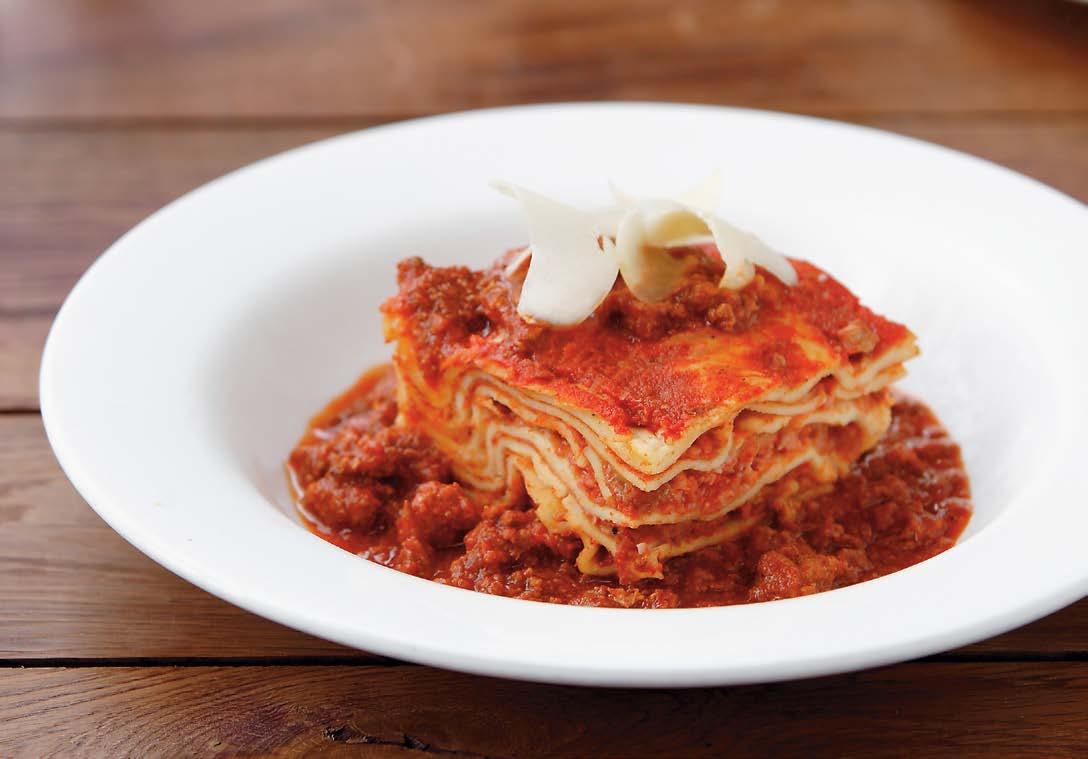
• Do not leave fresh egg products in open areas for more than two hours.
• Thaw overnight in refrigerator for best results.
Storage
• Refrigerate fresh products at 0-4°C for up to 3-4 days.
• Fresh egg products last 3-4 days refrigerated.
• Most dried/dehydrated products can be stored 1-2 yrs.
• Most mince meat products can be frozen 2-3 months at -15°C.
SOUTH AUSTRALIA’S READY MEALS CATER TO A WIDE RANGE OF DIETARY AND CULTURAL NEEDS.
READY MEALS CAN PROVIDE A QUICK AND EASY ALTERNATIVE TO MAKING FROM SCRATCH.Ready made fresh and frozen pastas are produced in South Australia.
FROM CREAMY YOGHURTS AND CHEESES TO FLAVOURED MILKS AND BEST QUALITY FRESH EGGS, CONSUMERS ARE SPOILT FOR CHOICE.


South Australia’s dairy and egg producers stand tall when it comes to quality.
DAIRY
The state’s dairy industry is a small but vital part of the national scene, accounting for about 471 million litres, or 5.5% of annual production.
Our artisan cheesemakers specialise in a wide range of innovative and traditional farmhouse styles, as well as yoghurt, quark, cream, ice cream and gelati, which regularly attract national acclaim.
Despite an exodus of dairy farmers in recent years, output has remained steady due to the expansion of remaining farms, better understanding of nutrition and animal husbandry, and improvements in technology.

South Australia is leading the way in environmental management and often trials new research in a quest to improve efficiency.
South Australia has diversified its milk production to encompass a range of herds, including cows, goats, sheep, and even buffalo. This expansion offers a diverse selection of milk options, each with its own unique characteristics and flavours.
EGGS
When it comes to quality egg production, there’s plenty to boast about in South Australia.
Following deregulation in 1992, there have been dramatic changes
in the industry. Egg producers can now sell eggs under their own brands, meaning they can create unique brands in the market.
South Australian producers are using mobile roosting sheds for their free range hens, while others use Mareema dogs to protect pasture raised hens from foxes at night, and many producers hand collect their eggs.
It’s good news for chefs seeking rich, flavoursome ingredients for their menus.
SOUTH AUSTRALIA’S DAIRY AND EGG PRODUCERS STAND TALL WHEN IT COMES TO QUALITY.Premium milk is produced into yoghurt, cheese and cream.
SOUTH AUSTRALIA’S MILK PRODUCERS OFTEN TRIAL NEW RESEARCH IN A QUEST TO IMPROVE EFFICIENCY.
EGGS
South Australia represents 5% of the Australian flock.
region
• Largest egg producers are based in Barossa, Clare Valley, Fleurieu Peninsula and Kangaroo Island
• There is a national egg labelling standard. It sets average egg sizes as follows:


• Medium: 43g
• Large: 52g
• X-large: 60g
• Jumbo: 68g
• King size: 73g.
nutrition
• High in protein and essential minerals, including iron and zinc for the immune system.
• Contains all vitamins, except Vitamin C. Good source of B12.
• Recommended serving size is based on large egg size (50-58.2g).
market
• Some producers have regular delivery contracts to restaurants in Adelaide and nearby towns.
• Most South Australian produced eggs are sold locally.
systems
• Barn: Free to roam in a shed which may have vertical levels. The floor may be based on litter and/or other material such as slats or wire mesh.
• Cage: Continuously housed in cages within a shed.
• Free range: Housed in sheds and have access to an outdoor range.
• Pasture-Raised: This production method prioritises lower stocking densities and rotational grazing, ensuring abundant ground cover and a variety of plant species the hens to consume.
Handling
• Older eggs are best used in baking or adding to recipes.

Storage
• Keep in carton to help reduce water loss and protect from absorbing other odours.
• Keep refigerated at 0-4°C.
• Keep for up to six weeks from date of packing. All eggs are given best before dates from the date they were laid.
• Eggs should not be frozen.
SOUTH AUSTRALIA’S EGGS ARE PRODUCED IN BARN, CAGE AND FREE RANGE SYSTEMS.Eggs are high in protein, minerals and vitamins. 5% OF THE AUSTRALIAN FLOCK.
CHEESE
South Australia produces a full range of hard and soft cheeses from cow, goat, sheep and buffalo milk.

region
• Most cheesemaking companies are based in Adelaide, Adelaide Hills, Barossa, Fleurieu Peninsula and Kangaroo Island.

market
• Some cheese products are available via national or state based distributors.
• Some producers supply direct.
Handling
• Fresh cheeses such as chèvre, cottage, feta and ricotta are high in moisture content and have a short shelf life. Best consumed soon after purchase.
• White mould cheeses, such as brie and camembert, age from outside to inside. Best consumed as close to or just after best before dates.
• White mould cheeses are at their best when soft to touch. Leave them to continue ageing if the core in the middle is still firm.
• Cheeses with a natural, hard or washed rind hold most of the flavour in or close to the rind. If the flavour is too strong, remove the rind.
• Soft cheeses are ideally served at 18-20°C; remove from refrigerator 2-3 hrs before serving. Ripe cheeses should have a soft, oozy texture and be easy to cut.
Storage
• Keep cheeses in the wrapping in which they are purchased for as long as possible, as these are designed to encourage ageing.
• Keep cheeses individually in separate containers, preferably in a crisper or separate part of the fridge that provides a little humidity.
• Keep away from strong smelling food as cheese can absorb other aromas.
THE MAIN CHEESEMAKING BRANDS ARE FOUND IN OR CLOSE TO THE STATE’S MAJOR DAIRY AND WINE REGIONS.
SOUTH AUSTRALIA’S CHEESES, NATURAL, HARD, OR WASHED RINDS, DERIVE A SIGNIFICANT PORTION OF THEIR FLAVOUR FROM THE RICH DEPTHS SURROUNDING OR NEAR THE RIND.Discover the art of cheese plating on page 44.
Blue cheeses have a distinct almost salty flavour
Serving
• Most cheeses are best served at ambient temperature for full flavour.
• The protein, fat and flavours of milk can change depending on the season, type of feed, and lactation stage of the animal, which can also influence cheese flavours.
Soft/fresh cheeses
• Cottage cheese, quark and similar fresh cheeses are mild, rich and creamy.
• Pair with: Sweet treats like honey and maple syrup.
Soft ripened cheeses
• Brie and cambert are earthy and creamy.
• Pair with: Fruits like melon and berries, as well as sundried tomatoes.
Blue veined cheeses
• Blue cheeses and Gorgonzola have a distinct, almost salty flavour.
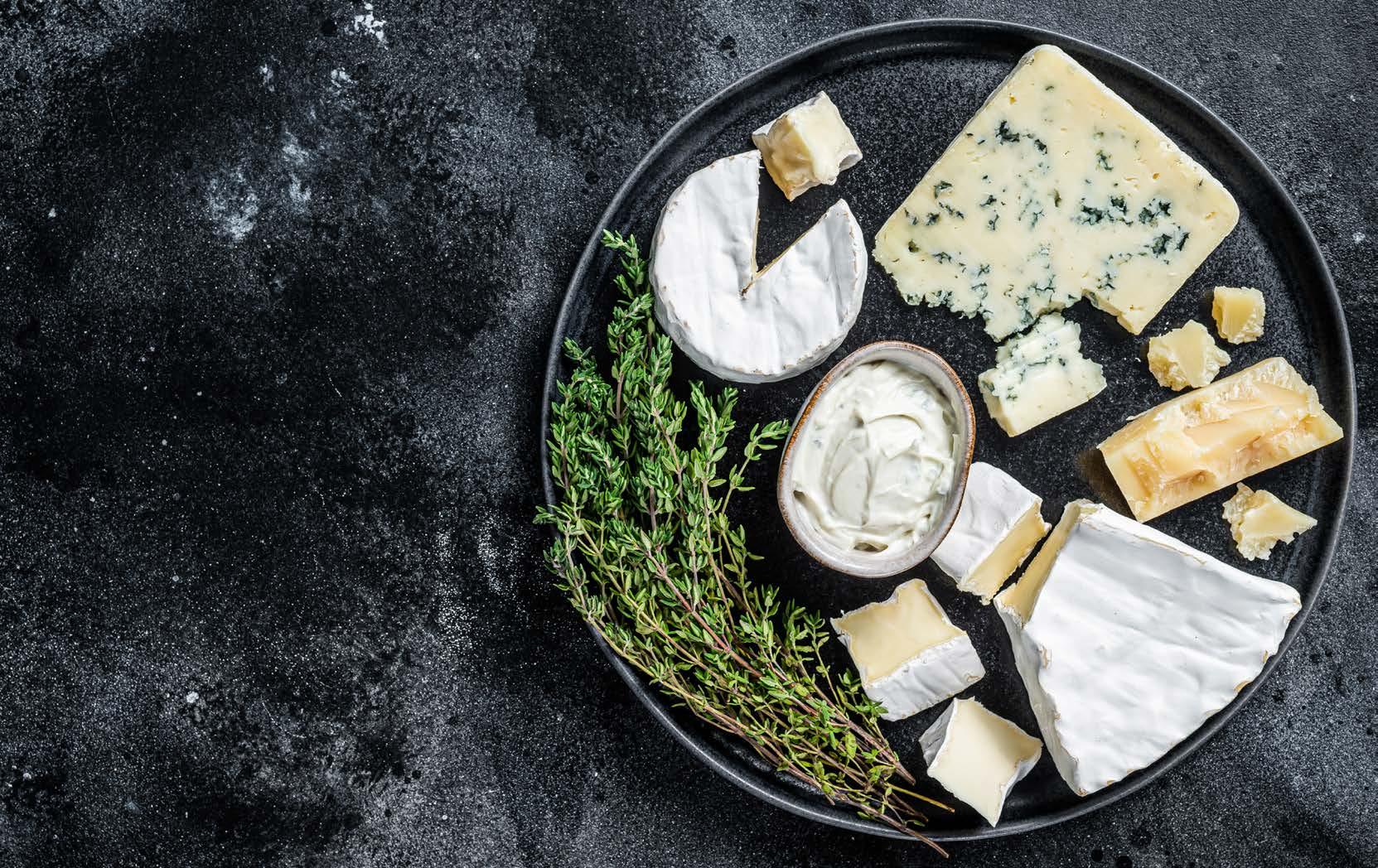
• Pair with: Sweet and nutty accompaniments, such as fruit and almonds, and spices such as ginger.
Semi soft cheeses
• Fontina and Harvati range from mild and buttery to earthy and pungent.
• Pair with: Roasted vegetables like asparagus and mushrooms, as well as with sweets, poached fruit and sugared hazelnuts.
Semi hard cheeses
• Cheddar, Gruyère, Swiss and similar hard cheeses range in flavour from rich and nutty to smooth and buttery.
• Pair with: Fruits, including apples and cranberries, are ideal for cheddars. Spicy pestos and rich chocolate are good partners for Gruyère and Swiss.
Hard cheeses
• Hard Italian style cheeses such as Parmesan and Romano are sweet, nutty and sometimes buttery.
• Pair with: Foods that pack an intense flavour punch such as spiced nuts, grilled vegetables, tangy vinegars and cured meats.
MOST CHEESES ARE BEST SERVED AT AN AMBIENT TEMPERATURE TO ALLOW THE FLAVOURS TO FULLY DEVELOP.

GELATO
The sector is made up of several large, medium and small South Australian producers.
• South Australia is also a base for several multinationals, all of whom source all or part of their dairy milk and cream requirements from South Australia’s dairy industry.
market
• Most restaurants and foodservice supplied through third party distributors.
• Some brands also offer unique or exclusive product development.
type
Gelato
• Made with mostly milk, undergoes slow churning process.
• Lower air content, making it denser and richer.
• Can be milk or fruit based.
Ice cream
• Generally whipped.
• Should feel heavy in container and have a dense and rich flavour.
handling
Gelato
• Optimum serving temperature for gelato is between -12°C and -15°C.
• Use high density freezer film to seal exposed gelato in tubs to stop ice crystals forming.
Ice cream
• For easy serving, ice cream can be pre-scooped before service. Place scoops on a parchment paper lined baking sheet and refreeze for about two hours or until firm.

• For longer storage, transfer scoops to an airtight container until ready to serve.
Storage
• Ice cream and gelato should be stored at -15°C.
A WIDE RANGE OF FROZEN YOGHURT AND SORBET PRODUCTS ARE ALSO AVAILABLE FROM LOCAL PRODUCERS.
There are around 40 accredited milk processing factories in South Australia, from major national brands to boutique cheese and yoghurt businesses who manufacture a full range of dairy products.
Region
• The four main dairying regions are Barossa, Clare Valley, Fleurieu Peninsula, Limestone Coast, and Murray River, Lakes and Coorong.
• The Limestone Coast produces more than 50% of South Australia’s milk output.
• There are five goat’s milk producers, most based on Fleurieu Peninsula and Limestone Coast plus a few sheep milk producers.
Regulation
• The Australian New Zealand Food Standards Code covers legislative requirements for dairy food production, transportation and processing in South Australia.
• The South Australia Dairy Authority monitors standards, provides guidance to industry, approves food safety arrangements and accredits dairy farmers, manufacturers and dairy produce carriers.
market
• Some milk is used interstate.
• Some producers supply and deliver to restaurants and foodservice outlets.
• Most milk businesses supply daily or weekly orders.
• Sheep and goat’s milk used mainly for yoghurt and cheese.
• Most sheep and goat’s milk sold directly from farm.
nutrition
• All milk is an excellent source of calcium, protein, Vitamins A, B, D.

• Homogenised: Cream is mixed into the milk.
• Unhomogenised: Cream is not mixed in and separates out naturally to the top of the milk.
• Permeate: A by-product of dairy manufacturing, sometimes added to establish consistency in mass produced milk.
• Goat’s milk: Similar to cow’s milk in nutrition but slightly lower in folic acid.
• Keep milk out of direct sunlight.
• Avoid freezing as it will destabilise the main protein, casein, and look slightly curdy when thawed.
Cream
• Can be frozen, thaw in refrigerator.
• Whip at 7°C or less. Chill bowl and beater in freezer first.
• Whipped cream should double in volume, particularly if it has a 35% milk fat content. Those with higher milk fat do not increase as much.
• Cream thickens with age.
Butter
• Butter softens at 30°C, melts at 35°C.
Storage
• Keep all dairy products away from direct sunlight.
Milk
• Refrigerate at 0-4°C in original package. Keep covered to avoid absorbing other flavours.
• Best before date is expected shelf life, usually 10 days at 0-4°C.
Cream
• Refrigerate at 0-4°C up to 10 days or up to three months frozen.
• If less than 35% milk fat, lightly whip cream before freezing it.
Butter
• Refrigerate at 0-4°C up to eight weeks.
• Freeze, properly sealed, up to a year.
Yoghurt
• Refrigerate at 0-4°C for 7-10 days.
• Freezing not recommended unless a manufactured frozen yoghurt product.
THERE ARE AROUND 40 ACCREDITED DAIRY PROCESSING FACTORIES, WHICH MANUFACTURE THE FULL RANGE OF DAIRY PRODUCTS.
Get ready to embark on a tantalising journey through South Australia’s thriving artisan cheese industry, where exceptional talent crafts a diverse array of hard and soft cheeses from locally sourced cow, goat, sheep and buffalo milk. Each cheese tells its own captivating story, reflecting the unique styles, flavours, and origins of the Adelaide Hills, Fleurieu Peninsula, Kangaroo Island, the Barossa Valley, and the city.
As consumer demands for food knowledge and authenticity grow, South Australian cheeses embrace regionality, satisfying the quest for authenticity. From bocconcini, mozzarella, cheddars, mascarpones, and ricottas to the thrilling innovations of native ingredient-topped fresh cheeses, washed rinds, alpine style and clothbound cheddars, fetas, and quarks, the offerings are as diverse as they are exceptional and globally awarded.
Whether you choose to build a dish around a single cheese or create an enticing platter with a selection of these stars, there has never been a more opportune moment to celebrate the brilliance of South Australia’s highly prized and globally renowned cheeses made by the some of the exceptional cheesemakers in the world.
You will never go wrong serving seasonal fruit on your cheese plate.
• Soft and hard cheeses work well with fruit.

• Apples, figs and pears are simple but ideal.
• Serve at ambient temperature.
Beetroot is the perfect accompaniment to goat‘s cheese.

• Try a simple salad of small greens, freshly cooked beetroot and crumbled plain chèvre, dressed with balsamic and olive oil.
• Beetroot relish is another great pairing. Present a small plate with a selection of goat cheeses for a magical combination of flavours.
• Serve at ambient temperature.
Honey and/or honeycomb and cheese is a discovery every cheese lover needs to make.

• Serve it with both cow and goat‘s milk cheese.
• Ricotta or quark with fresh honeycomb is superb.
Use bread and crackers that are not flavoured.
• A simple sourdough or an oatmeal cracker are best.
• Let the full flavour of the cheese be the hero of the plate.
Remember, best before is just a guide.
• Some soft cheeses will continue to improve right up to or just past their best before dates.

• Use your senses to decide, feel and smell, or ask your trusty cheesemonger.
• Some soft cheeses, like camembert, ripen from outside in.
• Hard centres indicate more time is needed to ripen.
• Serve at ambient temperature.
Think about how you display your cheese.
• Make sure your cheese plate is not overcrowded.

• Use a separate knife for each cheese.
• Serve at ambient temperature.
• Think about the shapes of the cheeses when buying. Buying different shapes of cheese adds interest to your cheese board.

THE STATES VARIED CLIMATE PROVIDES THE IDEAL GROWING CONDITIONS FOR A WIDE RANGE OF FRUIT, VEGETABLES AND NUTS.


The state’s varied climate provides the ideal growing conditions for a wide range of fruit, vegetables and nuts.
Growers are achieving success with new varieties, packaging and processing technology.
Key regions for the $2 billion industry (combined fruit and vegetable) include:
• Adelaide Hills (apples, cherries, pears, strawberries)
• Adelaide Plains, the state’s primary greenhouse area (Asian vegetables, capsicums, cucumbers, lettuces, tomatoes)
• Limestone Coast (potatoes, onions)
• Murray River, Lakes and Coorong (lettuces, onions, potatoes)
• Riverland, Australia’s fruit bowl (almonds, citrus, stonefruits).
Citrus is South Australia’s biggest fruit crop, and also biggest horticulture export. South Australia’s strict border control and fruit fly free status help to ensure the state’s citrus is highly regarded in the global marketplace.
The Adelaide Hills’ climate is particularly suited to apple and pear growing. South Australia is highly regarded within the Australian apple and pear industries, and leads the way in terms of adopting new technology, both for production efficiencies and increasing quality.
South Australia grows around 9,050 tonnes of fresh mushrooms (white and Swiss) each year. They account for 17% of Australia’s mushroom production
Successful innovation permeates every part of the industry.
Innovative packaging for some salad and bunch lines are adding extra shelf life, and glasshouse technology is helping to produce bumper yields.
Potato growers are producing varieties that taste better, last longer, use less water and have higher yields, plus innovations like the low GI potato.
These and many more innovations are making South Australian grown fruit and vegetables a must have for anyone looking to produce fresh, flavoursome meals.

SOUTH AUSTRALIA IS LEADING THE WAY IN ADOPTING NEW TECHNOLOGY FOR PRODUCTION EFFICIENCIES AND QUALITY.The Adelaide Plains is the state’s primary greenhouse region.

About 14 major apple varieties and six major pear varieties are grown.
Region
• Over 85% of apples and pears are grown in the Adelaide Hills.
• The remainder is grown on the Limestone Coast and Riverland.
Season
Major varieties of apples and harvesting:

• Fuji: March (best March to October).
• Golden Delicious: February to March (best March to December).
• Granny Smith: April (all year round).
• Jazz: April (best May to August).
• Pink Lady: April (best April to January).
• Red Delicious: February to March (best March to December).
• Royal Gala: February to March (best February to September).
• Sundowner: April to May (best August to January).
Major varieties of pears and harvesting:
• Beurre Bosc: March (best March to November).
• Corella: April (best April to October).
• Josephine de Malines: April (best April to November).
• Packham’s triumph: May (best May to January).
• Red Anjou: April (best April to November).
Appearance
• Apples should be fresh and fruity (not musty), and not give way to finger pressure.
• Pears give a little if pressed gently around stem.
• Natural russet and marks on pear skin doesn’t affect taste.
Nutrition
• A medium sized apple has a third of recommended daily Vitamin C requirements.
• Pears are a good source of dietary fibre and Vitamin C.
• Non-allergenic.
Market
• About 1% of both apples and pears are exported.
• About 10% of apples are sold as juice product.
• Most available through Adelaide Produce Market.
Handling
• Apples are harvested ripe.
• Pears are mostly harvested unripe.
Storage
• Pears ripen quickly when kept at ambient temperature.
• For both fruit, once ripe, store in refrigerator at 0-4°C for 1-2 weeks.
• Can be frozen (-15°C) for 4-6 months, pre-peeled and sliced, and stored in airtight container.
Serving
• Use in savoury and sweet dishes.
• Apple complements seafood, poultry and many Asian flavours.
• Pear complements lamb, pork and smoked or cured meats.
• Eat fresh, bake, stew, purée, preserve, grill or poach.
Strawberries make up 99% of total berry production and are the highest earning berry grown in South Australia.
• Berries include blackberries, blueberries, mountain pepper berries, mulberries, muntries (native berries), raspberries, red currants, riberries and strawberries
Region
• Most grown in Adelaide Hills.
• Small amount grown in Fleurieu Peninsula.
Season
• Blueberries and raspberries harvested December to March.
• Strawberries harvested October to May.
APPEARANCE
• Blueberries: Plump and blue, with no trace of pink or red.
• Raspberries: Plump, even in colour with a soft, hazy gloss and no dents.
• Strawberries: Brillant sheen, symmetrical shape, vibrant rich red colour and unwilted green leaves.
• Avoid strawberries with white shoulders or seedy tips.
Nutrition
• Fresh berries contain greatest levels of B vitamins and beta carotene.

• Blueberries highest in antioxidants and are considered a nutrition powerhouse or superfood.


• Strawberries highest in Vitamin C, potassium and folate.
Market
• Berries supply the fresh and frozen markets.
• Most sold locally.
• Most available through Adelaide Produce Market.
HANDLING
• Berries harvested when fully ripe.
• Fresh berries have short shelf life.
• Best consumed or frozen soon after purchase.
• Keep berries dry and only wash just before use.
• Allow to reach ambient temperature before serving for full flavour.
Storage
• Store unwashed and loosely packed. Remove damaged berries.
• Should be stored in refrigerator at 0-4°C for 1-2 days.
• Avoid exposing to sunlight.
• Freeze (-15°C) for up to 12 months.
Serving
• Can be used fresh or frozen.
• Complements savoury meats, such as kangaroo, turkey, pork and duck.
• Use in savoury recipes, sweet dishes and salads.
• Juice, preserve, candy or bake.
STRAWBERRIES MAKE UP THE BULK OF SOUTH AUSTRALIA’S BERRY PRODUCTION.
BERRIES ARE CONSIDERED A SUPERFOOD AND CAN BE USED FRESH OR FROZEN.Berries supply the fresh and frozen markets.
The largest commercially grown brassicas include:
• Broccoli
• Brussel sprouts
• Cabbage
• Cauliflower.
region
• Field crops for broccoli grown in Limestone Coast and Murray River, Lakes and Coorong.
• Field crops for cabbage, cauliflower and Brussel sprouts grown in the Adelaide Hills, Fleurieu Peninsula and Limestone Coast.

Season
• Most harvested February to November.
• Brussel sprouts harvested December to August.
appearance
• Healthy leaves and stems without blemishes or bruising.
Nutrition
• High in Vitamins A, C and E, folate and potassium.
• Broccoli believed to help lower risk of heart disease and some cancers.
• Red cabbage considered best of the variety as high in anthocyanins, which protect brain cells.
Market
• Brassicas predominantly sold on the domestic market.
• Remainder sold domestically, both locally and interstate.
• Most available through Adelaide Produce Market.
Handling
• Remove yellow or wilted outer leaves on Brussel sprouts.
• Do not wash or trim Brussel sprouts before storing.
• Do not cook cauliflower in an aluminium or iron pot. Cook cauliflower with florets head down in saucepan to prevent scum forming during cooking.
• An added 1tsp of white vinegar, lemon juice or a little milk will keep cauliflower florets a bright white colour.
Storage
• Brassicas should be stored in a perforated plastic bag in refrigerator at 0-4°C for up to a week.
• Store cauliflower, with leaves on, on its own or in perforated bags. If stored correctly in refrigerator, can be kept two weeks.
• Broccoli can be kept in refrigerator for up to five days.

Serving
• Sauté, roast, steam, purée, stirfry, pickle and raw.
• Care needed not to overcook.
• Complements smoked or cured meats, nuts such as almonds, walnuts and spices such as sage, nutmeg.
• Other brassicas suitable to eat raw include kale, kohlrabi and radish.
BROCCOLI, BRUSSEL SPROUTS, CABBAGE AND CAULIFLOWER ARE COMMERCIALLY GROWN IN SOUTH AUSTRALIA.Brassicas can be roasted, steamed, stir fried and pickled.
BUNCH
The largest commercially produced bunch varieties include:
• Spinach
• Spring onions. Smaller amount of following bunch vegetables also grown and sold:
• Beetroot

• Bok choy
• Leeks.
Region
• Spinach is grown mainly on Fleurieu Peninsula and Adelaide Plains.
• Spring onions grown in northern Adelaide Plains, and a small amount on Fleurieu Peninsula.
Season
Harvest occurs:
• Spinach: March to August.
• Spring onions: September to January.
appearance
Spinach
• Leaves are a healthy and deep green colour.
• Remove wilted or bruised leaves.
Spring onions
• New season produce should have dark green tips with tight, white ends.
Nutrition
Spinach
• Rich in antioxidants, known to help vision and memory.
• High in beta-carotene, which boosts immune system.
• Good source of zinc, iron, dietary fibre, potassium, magnesium and Vitamins A, C and K.
Spring onions
• Higher in dietary fibre than other onions.
• A rich source of Vitamin K, good for bone and brain health.
market
• Most available through Adelaide Produce Market.
Handling
• About 450g fresh spinach yields about one cup when cooked.


• The tops of spring onions can also be used in salads and for garnish.
Storage
• Cuts and bruises damage the cell walls of your vegetables and opens them up to spoilage by microbes.
• Remove all damaged vegetables to avoid rot spreading.
• Spinach is best stored in plastic bags or containers, to minimise moisture loss and wilting, in the refrigerator at 0-4°C for 4-5 days.
Serving Spinach
• Raw, steam, purée, sauté, stirfry.
• Complements fresh herbs such as marjoram, oregano, rosemary, sage and thyme, as well as spices such as chilli, cumin, ginger, paprika and turmeric.
Spring onions
• Raw, purée, sauté, roast or stirfry.
• Complements eggplant, fresh ginger oil, mushroom, soft-boiled eggs, tapenade, tomato, toasted seeds and nuts.
South Australia grows 32% of national citrus production (200,000 tonnes), with oranges accounting for 70% of the total crop. Our major citrus varieties grown are:
• Blood Oranges
• Limes
• Lemons
• Mandarins
• Navel oranges
• Tangelos
• Valencia oranges
• Navels and Valencia oranges are the main South Australia varieties.
• Mandarins are the next largest citrus crop at 18%.


• Smaller amounts of lemons, tangelos and grapefruit are commercially produced.
• Around 300 citrus growers.
Region
• The Riverland is South Australia’s largest citrus producing region, followed by Murray River, Lakes and Coorong.
Season Harvest occurs:
• Blood Oranges: August to October.
• Limes: All year.
• Lemons: All year.
• Mandarins: May to October.
• Navel oranges: May to November.
• Tangelos: June to October.
• Valencia oranges: September to April.
Appearance
• Citrus ripens from inside out.
• Fruit tinged with green peel does not mean fruit inside is unripe.
• Ripe fruit will give a little with gentle squeeze.
Nutrition
• An orange has twice the recommended daily intake of Vitamin C.
• Oranges contain 18% of recommended daily intake of folic acid and 8% fibre.
• Soluble fibre is in the fruit flesh.
• High in antioxidants.
Market
• About 30% of South Australian citrus is grown for premium export, especially to Japan.
• The remainder is sold nationally, and into juice processing.
• Most available through Adelaide Produce Market.
handling
• Citrus fruits do not ripen after being picked.
Storage
• Oranges, lemons and limes last about 2-3 weeks in the refrigerator at 0-4°C.
• Tangerines will last about a week in the refrigerator at 0-4°C.

• Can be frozen at -15°C for 4-6 months. Can be frozen whole or peeled and sliced.
Serving
• Use in savoury and sweet dishes and salads.
• Juice, preserve, candy, bake or grill.
• Rind of oranges, lemons and limes lift citrus flavour and aroma in desserts and savoury dishes.
The largest commercially produced vegetable crop varieties include:
• Capsicums
• Chillies
• Corn
• Cucumbers
• Marrows/squash
• Zucchinis.
• Cucumbers and capsicums are largest sector.
REGION
• Glasshouse grown crops in Adelaide Plains and Murray River, Lakes and Coorong:
• Capsicums
• Chillies
• Cucumbers (100%)
• Zucchinis.
• Field crops grown Riverland, Adelaide Hills, Fleurieu Peninsula, and Murray River, Lakes and Coorong:
• Corn
• Zucchinis (small amount).
Season
Glasshouse
• Cucumbers: Harvested all year (at best September to December).
• Chillies and capsicums: Harvested all year.
• Marrows, squash and zucchini: Harvested June to November.
Field crops
• Capsicums and chillies: Harvested November to February.
• Corn: Harvested December to May.
• Zucchinis, marrows and squash: Harvested December to May.
appearance
• Bright, well formed and firm.
• Avoid any with soft spots, black spots, wrinkles or that feel soft to touch.
Capsicums & chillies
• Good levels of carbohydrates, Vitamins A and C.
Corn
• Good source of B vitamins, folate, Vitamin C, beta-carotone, protein and fibre, but high in carbohydrates.
Zucchinis & squash
• Very low in calories but very rich in Vitamin A and health boosting flavonoids such as zeaxanthin, lutein and carotene.
Market
• South Australia’s crop vegetables are sold predominantly on the domestic market.
• Most available through Adelaide Produce Market.
• Wash most vegetables thoroughly in cold, running water before cooking, some may need a light scrub.
• Leave skin on for zucchini and squash. Skin can be charred or steamed off capsicums.
• Refrigerate for two weeks at most at 0-4°C.
• Do not store eggplants, capsicums or chillies with ethylene producing crops such as apples, bananas, rockmelons or tomatoes.
• Chillies can be frozen and kept for up to to months.
• Corn quality decreases rapidly at ambient temperature. Store in cool, moist conditions. Can store with cabbage, greens and potatoes.
Serving
Capsicums
• Eat raw, bake, stuff, stirfry or pickle.
• Red and yellow capsicums are sweeter due to higher sugar content. Green capsicum has a slightly bitter taste.


Chillies
• Eat raw, bake, add to sauces, salsa, dry and make into a paste.
• Chillies work well with a wide variety of dishes and flavours, particularly mild and contrasting flavours such as seafood, avocado and corn.
Corn
• Steam, grill, bake and purée.
• Corn works well with rich herb butters, as well as strong contrasting flavours such as savoury mushrooms, capers and chilli dishes.
Zucchinis
• Bake, stuff, fry, boil, steam, sauté, grate and pickle.
• Use in savoury and sweet dishes.
• Works well with chilli, spices such as nutmeg and paprika and herbs such as thyme.
SOUTH AUSTRALIA’S CROP VEGETABLES INCLUDE CAPSICUM, CUCUMBERS, CORN, SQUASH AND ZUCCHINIS.
Watermelon and rockmelon are the largest types grown commercially, with a small amount of honeydew also grown.

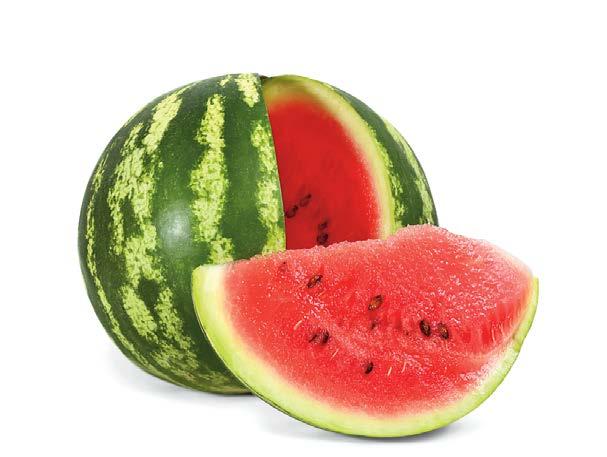

region
• Majority grown in the Riverland.
Season
• Harvest is November to March.
• Good supply and best quality late December to February.
• Honeydew harvested December to February (best in February).
Appearance
Honeydew
• Flesh has sweet smell.
• Clean, creamy or pale green rind.
• Whole melon should feel heavy.
Rockmelon
• Whole fruit should not have an aroma. Aroma can indicate a cut or being overripe.
• Firm seed cavity.
• Uniform orange/salmon toned flesh.
• Should have definite line between flesh and green of the skin.
Watermelon
• Whole fruit should have no aroma.
• Firm flesh when pressed.
• Uniform crimson/red colour.
• Whole ripe fruit has a sharp ringing sound when tapped with a finger.
• Tiny white or black seeds may be present in seedless watermelons.
Melons are an excellent source of Vitamins A and C, and potassium.
Nutrition
• Most melons are over 90% water.
• Melons are an excellent source of Vitamins A and C and potassium.
Market
• Mostly sold within South Australia.
• About 2% sold interstate.
• Most available through Adelaide Produce Market.
handling
• Watermelon and rockmelons do not ripen after harvest.
Storage
• Whole honeydew kept at ambient temperature may ripen and develop a little more flavour.
• Melons will keep 3-4 days when refrigerated at -4°C.
• Can be frozen st -15°C for 4-6 months, pre-peeled and sliced, and stored in airtight container.
Serving
• Use in savoury and sweet dishes.
• Juice, grill, stirfry, or add to soup.
• Some Asian dishes use melon rind.
• Complements smoked or cured meats.
MELONS ARE A GREAT FOOD MATCH WITH CURED MEATS.
Heavy vegetables include root vegetables and pumpkin.
Carrots are available in orange, red and purple varieties.
Region
• Grown in Fleurieu Peninsula, and Murray River, Lakes and Coorong.
Season
• Harvested March to August.
appearance
• Bright orange skin and firm feel.
• Other varieties are purple and red.
• Avoid any with shrivelled skins, sprouting eyes, soft spots, blemishes or green spots.
Nutrition
• Excellent source of carotene.
Market
• Sold mostly on domestic market.
• Most available through Adelaide Produce Market.
handling
• Do not wash until ready to use.
Storage
• Keep carrots in sealed plastic bag in the coolest part of the refrigerator, 0-4°C. Keep for 2-3 weeks.
Serving
• Use in savoury and sweet dishes. Bake, grill, roast, fry, purée, grate and eat raw.
• Complemented by citrus juice, honey, cumin, currants, capers, mint, cinnamon, fennel and cardamom.
The main varieties of onions grown in South Australia are:
Brown onion
• Cream Gold
• Murray Brown. Red onion
• Red Shine
• Red Wing. White onion
• Bianca
• Gladalan White
• White Spanish.
region
• Grown on Adelaide Plains, Limestone Coast, Murray River, Lakes and Coorong, and Riverland.
Season
• Brown: Harvested January to March.
• Red Shine: Harvested December to January.
• Red Wing: Harvested February to March.
• Bianca: Harvested December to February.
• Gladalan White: Harvested November to January.


• White Spanish: Harvested February.
appearance
• Well shaped, have no opening at the neck and crisp, dry outer skins.
• Avoid those that are sprouting or have soft spots, moisture at their neck, or dark patches, which are indications of decay.
Nutrition
• High in phytochemicals which help body’s immune system.
• A source of Vitamin C, potassium, dietary fibre and folic acid.
Market
• Most available through Adelaide Produce Market.
handling
• To help avoid crying when cutting, refrigerate your onion for an hour prior to chopping/peeling.
Storage
• Onion is best stored hanging in a storeroom with good air circulation.
• Sweet onions don’t store as well as their more pungent cousins.
serving
• All: Roast, grill, fry or sauté.
• Brown onions: Strongly flavoured and suitable for cooking.
• Red onions: Have a mild to sweet flavour. Can be eaten raw, grilled or lightly cooked with other foods.
• White onions: Vary in size, skin characteristics and flavour. Milder smaller varieties can be added to salads. Larger sizes have stronger flavours more suitable for cooking.
THE POTATO IS SOUTH AUSTRALIA’S LARGEST HORTICULTURE MARKET SEGMENT.
Potato production is South Australia’s largest horticulture sector. There are more than 36 varieties grown in South Australia.
region
Potato growers are found throughout the state. The major growing regions include: Murraylands/Riverland (41% of production), Limestone Coast (44%), Northern Adelaide Plains (14%) and Kangaroo Island (1% of production, seed only).
Season • Supplied all year.
appearance
• Avoid any potatoes with shrivelled skins, sprouting eyes, soft spots, blemishes or green spots.
nutrition
• Potatoes are a good source of fibre and Vitamin C.
• High in starchy carbohydrate.
Market
• Approximately 80% of Australia’s fresh washed and pre-packed potatoes are produced in South Australia.
handling
• Leave skin on where possible as most nutrients are close to the skin.
• Do not wash before storing.
Storage
• To avoid spreading rot, store in a dry, well ventilated place away from light.
• Will keep 2-3 weeks when kept at ambient temperature.
Serving
The three main types of potato are:
• Floury: Often used in French fry production. Mash, bake and roast.
• Waxy: Boil, roast, bake, fry, purée.
• All rounder: Can be used in most styles of cooking.
PUMPKINS
Main varieties grown are butternut, Jap and Queensland Blue.

Region
• Grown in Fleurieu Peninsula, Murray River, Lakes and Coorong, Riverland and small amount in Adelaide Plains.
Season
• Butternut harvested first, in May.
• Followed by Jap and Queensland blue varieties June to September.
appearance
• Avoid any with shrivelled skins, soft spots, blemishes or green spots.
• Cut pumpkin should have a bright orange colour and firm texture.
• Butternut: Buff-coloured and pear shaped.
• Jap: Bright orange flesh.
• Queensland Blue: Golden/orange fibrous flesh.
Nutrition
• Low in sodium, high in betacarotenoids, potassium and fibre.
• Pumpkin seeds are high in zinc and omega-3.
Market
• Most available through Adelaide Produce Market.
• Majority sold on domestic market.
handling
• Pumpkins with undamaged skins can last up to six months when stored correctly.
Storage
• Keep in a dry, well ventilated place away from direct light. To avoid spreading rot, store so they do not touch each other.
Serving
• Butternut: Dense, dry, sweet tasting flesh.
• Jap: Sweet flavour. Suits salads and quiches.
• Queensland Blue: Full flavoured, suits soups, curries, stews and scones.
• Cheeses, such as blue vein, ricotta, goat’s cheese or Parmesan, are a good match with pumpkin.
• Pumpkin can also be used in sweet dishes. Complements brown sugar, grated lemon or orange rind, cinnamon, nutmeg, vanilla and cloves.
While White and Swiss brown mushrooms dominate South Australia’s commercial cultivation, the exotic mushroom industry is experiencing a booming surge, witnessing an increase in commercial harvests of diverse varieties. Embrace the exciting growth of this sector as an array of extraordinary mushrooms finds its way onto our plates.
region
Commercial mushroom farms are located in Adelaide’s North and Murray River Region.
Season
• Available all year.
appearance
• The cap of the button mushroom is tightly closed around the stem.
• Cup mushrooms have the veils or caps beginning to open around the stems.
• Flat mushrooms have the caps opened out flat, exposing the rich, dark gills.
Nutrition
• High in protein (average 3g protein per 100g).
• A serve of mushrooms (3-4 mushrooms/100g) provides more than 20% of your daily needs for 6 essential nutrients: riboflavin, niacin, pantothenic acid, biotin, copper and selenium, while also providing folate and bioactive compounds.

Market
• Sold as buttons (youngest and smallest), cups (partially opened), flat or open types (largest variety).
• Most available through Adelaide Produce Market. Some producers sell direct to restaurants.
Handling
• To clean, wipe gently with a damp cloth.
• Do not peel, as they lose flavour.
• Do not wash, as they act like a sponge and soak up water.
Storage
• Refrigerate at 0-4°C in a paper bag or wrapped in a paper towel to absorb moisture.
• Will keep for up to a week.
Serving
• A button mushroom is milder in flavour.
• A matured open mushroom has more flavour than a closed mushroom.
• A closed button mushroom is more suitable in a salad or eaten raw.

• A brown mushroom has a strong, earthy flavour.
• White variety suits salads, stirfries, risottos, pizza toppings, pasta dishes, barbecue skewers or serve simply with dips.
• Add Swiss browns to antipasto plates or add slices to pasta, pilafs, risottos, casseroles, pie fillings or curries.
WHITE AND SWISS BROWN MUSHROOM ARE THE LARGEST COMMERCIALLY GROWN VARIETIES.
MUSHROOMS HAVE LONG BEEN CELEBRATED AS A SUPERFOOD WITH A POWERFUL SOURCE OF NUTRIENTS.Open mushrooms are more intensely flavoured than closed varieties.
About 20% of Australia’s almond production are grown in South Australia.

• Other nut crops grown on a commercial scale include chestnuts, pistachios and walnuts.
REGION
• Primary production areas for almonds are Adelaide Plains and Riverland.
• Nut crops also based in Adelaide Hills, Murray River, Lakes and Coorong, and Riverland.
Season
Havesting takes place:
• Almonds: February to March.
• Chestnuts and walnuts: May to July.
• Green almonds (small amount): October to November.
• Pistachios: March to June.

appearance
• When buying nuts in the shell, look for clean, uncracked shells.
• Nuts in the shell should be heavy for their size, indicating a fresh, meaty kernel.
• When buying shelled nuts in bulk, check for a pleasant smell.
• Crisp, plump and meaty kernels indicate high quality.
nutrtition
• Nuts are a healthy source of monounsatured fats.
Market
• 75% of almonds grown in South Australia are sold on export market.
• All other nuts sold on domestic market only.
• Most sold direct to nut processors and available through Adelaide Produce Market.
handling
• Return nuts to ambient temperature before eating.
• Almond meal can be used as a replacement for flour.
Storage
• Store in an airtight container in the refrigerator at 0-4°C for up to four months.
• Freeze nuts, in an airtight container, for up to six months at -15°C.
• Shelled and cooked chestnuts should be covered, refrigerated and used within 3-4 days.
serving
• Most nuts can be used in savoury and sweet dishes.
• Roast, bake, stirfry or use ground, salted and pickled.
WALNUTS.
YOU CAN FREEZE NUTS IN AN AIRTIGHT CONTAINER FOR UP TO SIX MONTHS.South Australia produces about 15,000 tonnes of almonds each year.
South Australia produces a wide variety of stonefruits and avocados.

APRICOTS, NECTARINES, PEACHES & PLUMS
Commercial quantities of stonefruit grown in South Australia include:
• Apricots
• Nectarines
• Peaches
• Plums.
region
• Most grown in the Riverland.
• Small amount grown in the Adelaide Hills, Barossa, Limestone Coast, and Murray River, Lakes and Coorong.
Season
• Most stonefruit harvested October to March.
• Riverland stonefruit is first to be harvested.
• Apricots are harvested November to January.
Appearance
Apricots
• Deep yellow or yellow/orange, plump and well formed.
• Moderately firm, should yield a little when ripe.
• Sweetness develops on the tree. Nectarines & peaches
• Full bodied floral aroma from stem.
• Fruit loses brightness when ripe.
• White freckles on top half indicate high sweetness.
• White peaches and nectarines can be eaten sweet and when still crunchy. Plums
• Fruit loses brightness when ripe.
• Firm, yield a little to gentle squeeze.
Nutrition
• All stonefruit are rich in Vitamins A, C and E and are a good source of dietary fibre and potassium.
Market
• About 5% of stonefruit are sold on export market.
• Apricots are only available on the domestic market, with about 25% sold as dried fruit.
• Most available through Adelaide Produce Market.
handling
• Most stonefruit continue to ripen after harvest.
• Flavour at its best at ambient temperature.
• Use ripe fruit within a few days.
Storage
• Unripe fruit should be stored in dry room, in an airy place, at ambient temperature, for full flavour and aroma to develop.
• Once ripe, store in refrigerator crisper at 0-4°C for up to a week.
• Do not stack fruit more than two layers deep.
• Most stonefruit can be frozen whole or pre-pitted and sliced, for up to six months.
Serving
• Use in savoury and sweet dishes and salads.
• Eat fresh or bake, stew, purée, preserve, grill or poach.
• Peaches/nectarines complement chicken, pork or fish.
• Apricots/plums complement meats and poultry.
Main variety grown is Hass, with smaller amounts of Gwen, Lamb Hass and (smooth skin) Fuerte and Reed.
Region
• Most grown in Adelaide and Murray River, Lakes and Coorong.
Season
Harvesting takes place:
• Fuerte: June to August.
• Gwen: November to January.
• Hass: September to January.
• Reed: January.
• Lamb Hass: December to March.
Appearance
• Hass turns from green to rich purple to a black shade when ripe.
• Firm but yield to gentle pressure around stem.
• Standard weight range 140-340g.
nutrition
• Good source of Vitamins C and E, minerals, antioxidants and anti-inflammatory compounds.
APRICOTS, CHERRIES, NECTARINES, PEACHES AND PLUMS MAKE UP MOST OF SOUTH AUSTRALIA’S STONEFRUIT INDUSTRY.
• Half an avocado can give the average adult 5g of fibre, 36% of the RDI of folate, 31% of vitamin K, 24% vitamin E and 15% potassium.
Market
• South Australian avocados are sold nationally.
• Most available through Adelaide Produce Market.
handling
• Continue to ripen after picking.
• To ripen quickly, place fruit in brown paper bag, store at ambient temperature for 2-5 days.
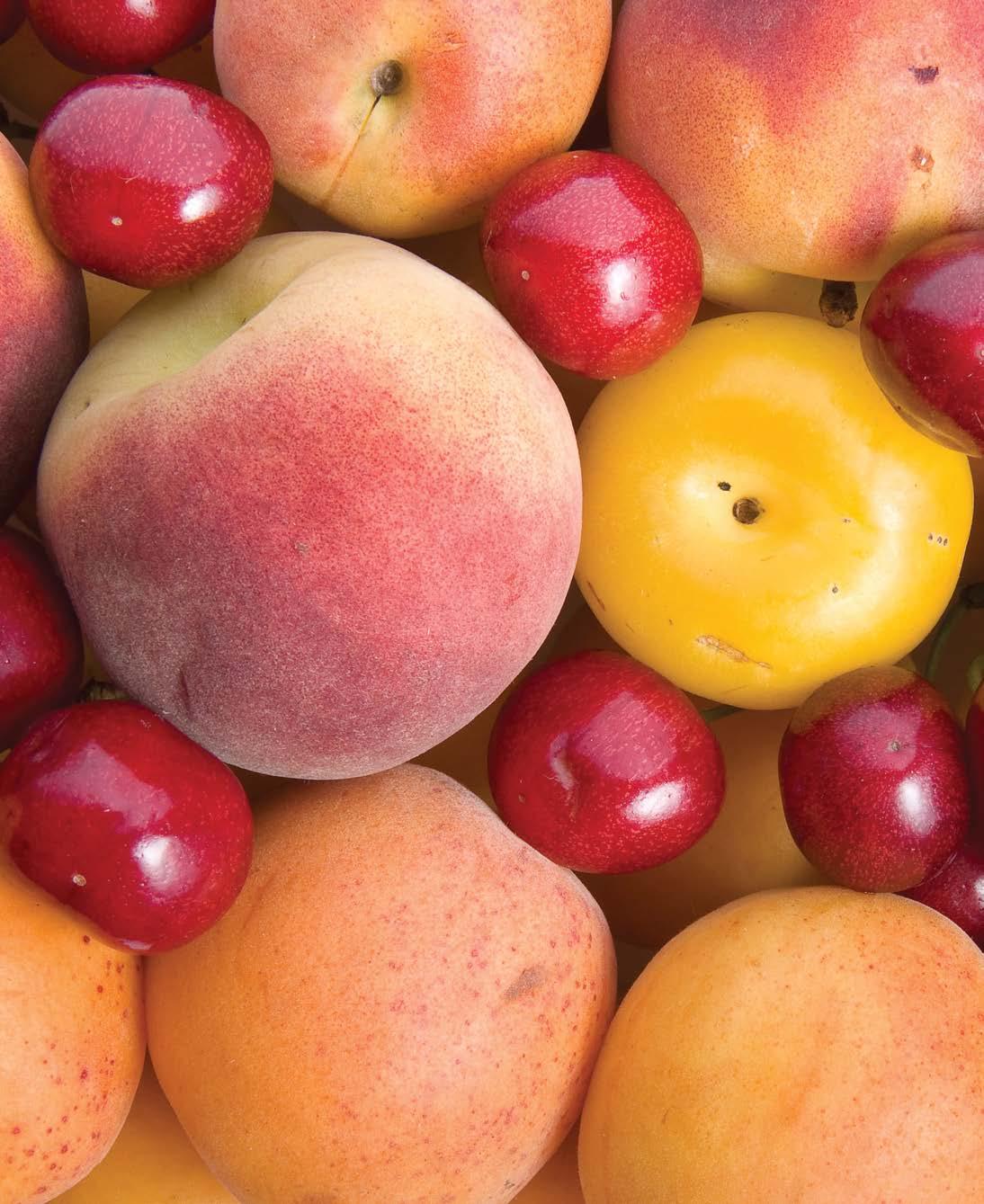
Storage
• Whole ripe avocado will keep in refrigerator for 2-3 days.
• Sprinkle cut avocado with lemon juice, lime juice or white vinegar and place in an airtight container in your refrigerator for 1-2 days. Try to store intact.
Serving
• Mash, eat fresh, grill, add to salads.
• Avocado complements citrus and chilli.
Around 50 varieties of cherries are grown in South Australia, the most common varieties being Stella and Lapin.
Region
• About 95% are grown in the Adelaide Hills.
• Remainder grown in Fleurieu Peninsula, Limestone Coast, Murray River, Lakes and Coorong, and Riverland.
Season
• Main harvest mid-November to mid-January; some early varieties starting mid-October in Riverland.
Appearance
• Firm, glossy skin.
• Strong, sweet and fruity aroma.
• Should yield to gentle squeeze.
Nutrition
• Good source of Vitamins C and E, minerals, antioxidants and anti-inflammatory compounds.
Market
• About 10% sold on the export market.
• Remainder sold nationally.
• Most available through Adelaide Produce Market.
handling
• Leave the stems on to help keep cherries fresh for longer.
• Rinse under cold water just before serving.
• Remove pips before using.
Storage
• Store in refrigerator at 0-4°C for 3-4 days.
• Store unwashed and loosely packed. Remove damaged berries.
• Freeze for up to 12 months.
• Avoid exposing to sunlight.
serving
• Use in savoury and sweet recipes.
• Works well with meats such as pork, duck and kangaroo.
ABOUT 95% OF CHERRIES ARE GROWN IN THE ADELAIDE HILLS.Stonefruits from the Riverland are the first to be harvested each year.
South Australia’s salad vegetables are grown in field production and glasshouses.
• Field production is mostly during summer.
• Main variety grown in South Australia is iceberg.
• Other varieties grown include:
• Butterhead
• Cos
• Curly endive (frisée)
• Escarole
• Mache (corn salad or lamb’s lettuce)
• Mizuna (Oriental greens).
• Raddicchio (red chicory).
• Red leaf
• Rocket (arugula)
• Witlof chicory (Belgian endive).
Region
• Most grown in Adelaide Plains and Murray River, Lakes and Coorong.
• Field production in Adelaide Hills, Fleurieu Peninsula, and Limestone Coast.
Season
• Available all year.
appearance
• Look for bright, rich coloured leaves – no browning or yellowing.
• Salad leaves should be crisp and retain their shape.

• Salad greens should smell sweet, and a little bit earthy. If they smell too bitter or dull, that is an indication of how they will taste in your salad.
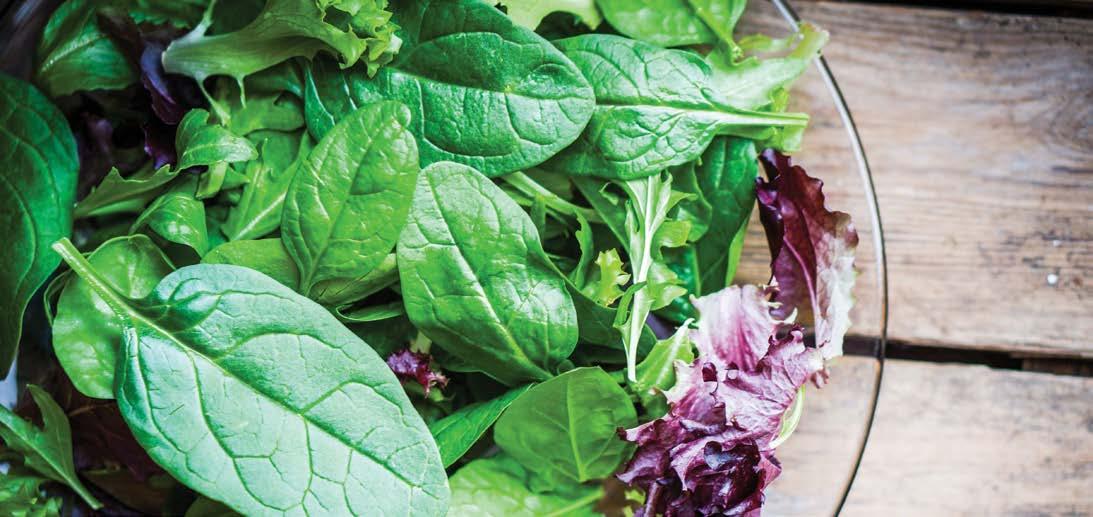
Nutrition
• High in fibre.
• Good source of potassium and magnesium.
• Dark green or red salad varieties are high in antioxidants.
market
• Some lettuce exported.
• Most available through Adelaide Produce Market.
handling
• Rinse and dry all salad leaves before serving.
Storage
• Refrigerate at 0-4°C for 3-5 days.
• Store away from other produce to prevent deterioration.
• Do not pack loose leaves tightly.
• Remove brown or wilted leaves where possible.
• Keep loose salad mixes in papertowel-lined airtight container.
• Keep whole salad vegetables in plastic bag or airtight containers.
serving
• Butterhead: Tender, rounded leaves. Mild, buttery flavour.
• Cos: Elongated, sturdy leaves, coarse texture, stores well.
• Curly endive (frisée): Yellowish/ green, frilly leaves. Strong, pleasantly bitter taste.
• Escarole: Broad leafed endive. Light colour leaves have mild flavour. Dark green leaves are bitter.
• Iceberg: Crisp leaf and sweet flavour. Longer shelf life.
• Mache (corn salad or lamb’s lettuce): Delicate leaves, nutty flavour.
• Mizuna (Oriental greens): Deeply cut fringed leaves, tangy flavour.
• Raddicchio (red chicory): Dark red leaves, white veins. Bittersweet.
• Red leaf: Believed to be higher in antioxidants. Short shelf life.
• Rocket (arugula): Has a distinctive peppery flavour.
• Witlof chicory (Belgian endive): Dense, cigar shaped head of crunchy leaves, pale yellow colour.
SALAD VEGETABLES ARE GENERALLY AVAILABLE YEAR ROUND.Store salad vegetables away from other produce to prevent deterioration.
Majority of South Australia’s tomato production is grown in glasshouses.
region
• Largest tomato glasshouse zones are Adelaide Plains and Murray River, Lakes and Coorong.
• Largest commercial producers of field tomatoes are based in Murray River, Lakes and Coorong, and Riverland.
Season
• Available year round.
• Field grown: harvested November to March.
appearance
• Free of blemishes with a deep bright red colour.
• Ripe tomatoes should be firm to the touch and feel heavy.
• Heirloom varieties include green, purple or lumpy and vary in size.
• Feel and touch are good indicators of ripeness for heirloom tomatoes.
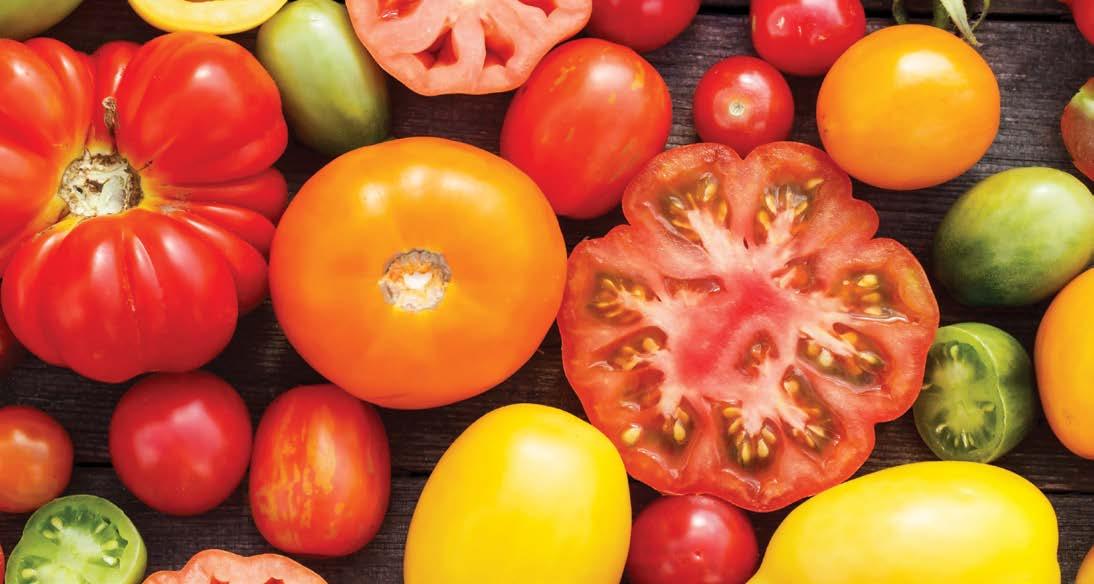
Nutrition
• Excellent source of Vitamins C, A and K.
• Very good source of potassium, dietary fibre, and Vitamin B1.
• Contains antioxidant lycopene (which causes red colouring and becomes more pronounced during cooking), known to protect cells in the body from oxygen damage.
Market
• About 95% of tomato production is sold as fresh produce.
• Most is sold on the domestic market.
• Most available through Adelaide Produce Market.
Handling
• Continue to ripen after picking.
• Best ripened in a dark, warm climate.
• Should not come in contact with aluminium, including cooking pots, knives and other kitchen utensils as acid does not react well and causes
loss of fruit colour and bitter taste.
• Bring chilled tomatoes to ambient temperature before preparing and serving.
• Flavour is best at ambient temperature.
Storage
• Store away from other fruit.
• Ripe whole tomatoes should be stored at ambient temperature and eaten within two days.

• Freeze unused ripe tomatoes whole (to maintain shape, and peel when defrosted), or puréed for later use. Use within six months.
Serving
• Eat raw, juice, roast, stew, purée, grill, poach, or fry.
• Subtle sweetness is complemented by slightly bitter and acidic flavours.
SOUTH AUSTRALIAN TOMATOES ARE MAINLY GROWN IN GLASSHOUSES.
FREEZE UNUSED RIPE TOMATOES WHOLE TO MAINTAIN SHAPE, AND PEEL WHEN DEFROSTED.Ripe tomatoes should be firm to the touch and feel heavy.
Elevate the offering with the vibrant presence of locally grown, fresh, and in-season vegetables that deserve to shine as the true heroes on the plate, as this masterclass wholeheartedly suggests.
South Australia’s bountiful selection of flavoursome vegetables effortlessly allows chefs and cooks to showcase their brilliance. Pairing these vegetables with the perfect flavours and cooking techniques becomes paramount, enabling the full potential of the abundant fresh produce to be harnessed with ease.
Understanding the art of utilising this produce extends beyond the kitchen and transcends the plate, creating a dining experience that celebrates the beauty of nature’s gifts.
• Get to know the local region, farmers and producers.
• Understand the local climate and its influence on food production.
• Read widely to help grow your own food philosophy.
• Observe fashion and design trends, and think of them in context with food texture and flavour presentation.
• Remember vegetable dishes can help balance the margins.
LOW GI POTATOES

Base flavour: Elegant, slightly sweet, starchy, soft texture. Hero matches: Carries rich flavours that encourage its earthy flavours.
Serve:
• No need to peel.
• Boil and crush with extra virgin olive oil, roast garlic, freshly ground white pepper, finish with nutmeg.
• Slice, steam, dress with toasted hazelnut slices, roasted spring onion, fresh thyme leaves and hazelnut oil.

Base flavour: Nutty, rich, slightly sweet green. Meaty round mouthfeel when inner beans are developed. Squeaky texture when super fresh. Young vibrant beans are best. Hero matches: Slightly acidic dressings (green beans), burnt butter sauces, caramelised onion, egg yolks, herbs, hollandaise, pesto, roasted nuts, savoury essences like mushroom and tomatoes.
Serve:
• Steam, dress with shaved summer fennel and walnut oil.
CELERIAC

Base flavour: Comforting savoury celery potato like flavour, starchy characteristics.


Hero matches: Butter, fennel, woody herbs, mayonnaise, mushrooms, spinach and walnuts.
Serve:
• Julienne with walnuts,walnut oil and lemon.
• Roast with mushroom and shallot jam.
• Sauté dressed with grapefruit gremolata.
CARROTS
Base flavour: Sweet, earthy, a touch of nutty custardiness. Heritage varietals are more earthy than regular Dutch orange.
Hero matches: Citrus, light acid, chilli, dried fruit, fragrant spices like cinnamon, cardamom and fennel.
Serve:
• Grate carrot add to olive oil with coriander and toasted sesame seeds.
• Roast with cumin seed and cinnamon.
• Steam tossed with capers, currants, mint and pine nuts.
• The hero should be in season in your local area.
• It should be the main flavour of the dish, as the predominant ingredient.
• Every other ingredient should lift and intensity of the hero’s flavour and texture.
• Taste your hero product raw, so you know the base flavour and determine which preparation method will highlight it.
• Select a cooking method to balance your menu.
• Season every component of your dish and taste the final dish.
FENNEL
Base flavour: Aniseed, slightly sweet.
Hero matches: Basil, citrus, saffron, raw with tapenade.
Serve:
• Shave fennel with green olive and thyme dressing and almonds.
• Roast with spinach and cardamom purée.
• Poach, dress with pistachio oil and lemon.
• Use as few ingredients as possible.
• Keep cooking to a minimum.
• Remember, you do not need starch, dairy and protein in every dish.
Base flavour: Sweet, slightly nutty, round juicy flavour. Can be starchy as it gets older. Hero matches: Rich butters, chillies, salty flavours, greens, herbs, mushrooms, olives, onions, end of season tomatoes.
Serve:
• Steam corn with candied shallot and rosemary dressing.
• Grill corn with walnut oil and lime.
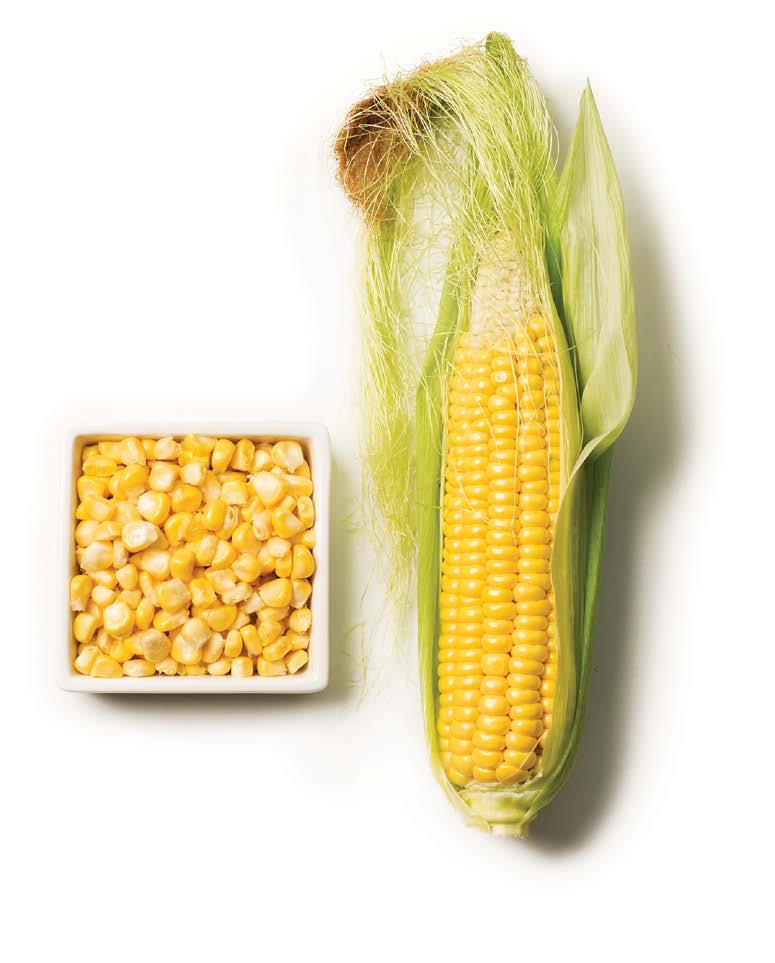
• Cream corn with thyme.

Base flavour: Savoury, milder salad onion, round mouthfeel. Can be hot when large. Buy new season small, tight stems with white ends and dark green tips. Hero matches: Partners that enhance rich onion flavour such as eggplants, fresh ginger oil, mushrooms, soft boiled eggs, tapenade, toasted seeds and nuts and tomatoes.
Serve:
• Steam, serve with extra virgin olive oil, porcini dust and citrus zest.
• Roast, serve with tomato basil salsa.
Base flavour: Sliverbeet and chard are rich greens with a touch of bitterness. Depending on season, can be more bitter and coarse in texture. Chard colour will bleed from stems. Kale is richer than silverbeet and nuttier in flavour. Hero matches: Rich moist partners like flavoured oils, egg dressings and runny egg yolks.

Serve:
• Steam, serve with mayonnaise, or citrus or mushroom flavoured oil, with a touch of aged sherry, or vinegar.
Base flavour: Slightly hot, fine delicate starchy acidic flavour, with watery mouthfeel, crisp texture.
Hero matches: Melon, summer fruits, soft greens like spinach, contrasting flavoured oils, herbs like basil and coriander.
Serve:
• Steam and toss in flavoured oil and summer herbs.
• Finely slice radish with orange oil, fresh coriander and crushed fresh coriander seed.


Base flavour: Meaty, rich, very savoury, earthy, slightly musty and sweet.
Hero matches: Acid such as lemon juice, quality aged sherry or wine vinegars, fragrant woody herbs such as thyme, sage and rosemary, soft herbs such as tarragon, basil and fennel seed.
Serve:
• Raw, sliced mushroom tossed in herb oil with lemon.

• Mushroom tapenade with olives, garlic, parsley and lemon zest.
• Duxelle (minced mushrooms, onions, shallots and herbs sautéed in butter) dressed with candied zest.
Base flavour: Deep, earthy, sweet, some varietals sweeter than others. Flat palate. Colour bleeds when cooked. Eat young leaves only.
Hero matches: A touch of acid either from citrus or good vinegar, cinnamon, cumin, all herbs, especially fennel, dill and capers, fresh horseradish, nutmeg and spicy, peppery rocket.
Serve:
• Grate three varietals and dress with apple cider vinegar, orange zest and nut oil.
• Roast and serve with in season citrus, capers, parsley and olive oil.
Australia’s edible native plant foods have been a part of our national landscape and Aboriginal diet for thousands of years.

Today’s native food industry in South Australia consists of a committed group of growers, producers and scientists who are extremely passionate about what they do.
Many of them have been the pioneers of this industry – and it’s easy to share their excitement as more people embrace the
unique sensory journey of our native herbs, spices, fruits, nuts and seeds.
The benefits are plentiful. Native fruits such as quandongs and desert limes are high in Vitamin C, while saltbush is being used by innovative South Australian lamb producers as feed, giving their meat a unique flavour and marketing edge.

Discover a new world of flavours to thrill your tastebuds and enhance your menu.
• Native, thorny, evergreen citrus shrub with petite, oval shaped fruit
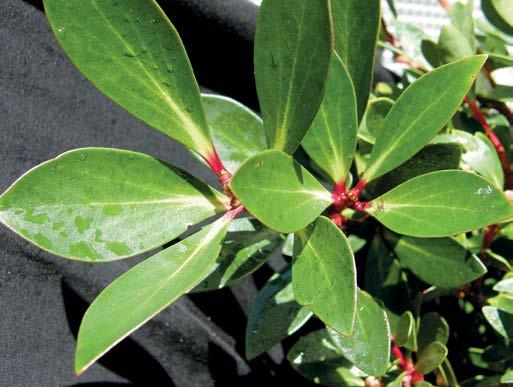
• Flavour: Fruit contains tart, citrus flavoured cavier-like pearls
• Use: In a cocktail or to enliven any dish including seafood.
MUNTRIE
• Fresh or dried fruit.
• Harvest: February to April.
• Flavour: Varies from dry apple to more cinnamon and blackcurrant flavours.
• Use: In chutneys, desserts, jams, baked in muffins and breads, salads and sauces.
• Leaves (dried and milled into a fine powder) and fruit (dried or ground).
• Harvest: All year.
• Flavour: Peppery flavour, the fruit has a hotter taste profile than leaves.

• Use: As a replacement to common pepper.
SAMPHIRE
• Small, fleshy leaves and stems.

• Harvest: December to February when leaves bright green, aromatic.
• Flavour: Strong, salty taste.
• Use: Sauté, stirfry, steam, pickle and eat fresh. Reduce salty taste by blanching for 30-45 secs or soak shoots in cold water for 1-2 hrs.
BUSH TOMATO
• Fresh or dried fruit.
• Harvest: April.
• Flavour: Dried fruit has a strong sun dried tomato, caramel and tamarillo flavour and aroma.
• Use: With cheese, eggs, salmon, tomato, strong flavoured white or game meats.
DESERT LIME
• Small fruit with no peel/rind.
• Harvest: January to February.
• Flavour: Similar to standard limes but more intense and piquant.

• Use: Extremely versatile, replaces standard limes.
LEMON MYRTLE

• Fresh or ground leaves.
• Harvest: All year.
• Flavour: Strong fresh fragrance of creamy lemon and lime.
• Use: With fish, chicken, in ice cream and sorbet.

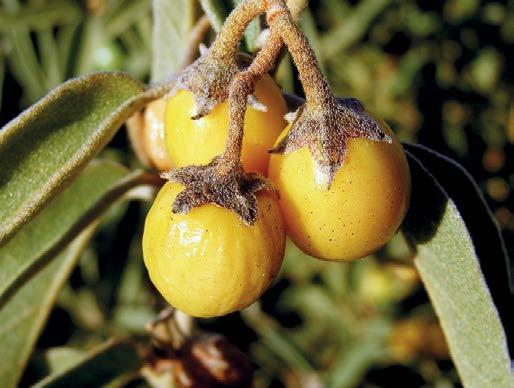
• Fresh or dried fruit.
• Harvest: September to October.
• Flavour: Tart.
• Use: In pies, tarts, jams, sauces, chutneys, glazes for roasting meat.
RIVER MINT
• Fresh or dried leaves.
• Harvest: All year.
• Flavour: Strong scented herb similar to spearmint.


• Use: Replaces any exotic common mints, in cool drinks, salads and sauces for meat dishes.
SALTBUSH

• Leaf, seeds, dried flakes.
• Harvest: All year.
• Flavour: Salty spinach flavour.
• Use: Wrap leaves (fresh or blanched) around meat or fish, add dried flakes to breads, grills and pasta.
SANDALWOOD
• Nut kernel.
• Harvest: September to October.
• Flavour: Similar to macadamia but with a more subtle, nutty flavour.

• Use: In similar fashion to macadamias and other nuts, and with native herbs and fruits.
WARRIGAL
• Fleshy, slightly textured leaf.
• Harvest: All year. Grows wild along sandy coasts.
• Flavour: Similar to traditional spinach and silverbeet, lemony.
• Use: Sauté, stirfry, steam or blanch. Must be blanched before eating by steaming or boiling for 1-2 mins.
WATTLESEED
• Seeds, roasted then crushed.

• Harvest: January to February.
• Flavour: Coffee, chocolate, hazelnut.
• Use: In baking, to thicken sauces and casseroles, to flavour ice cream, or to replace coffee.
ETHICAL FARMING, SPECIALITY BREEDS AND NEW GRAZING METHODS
GIVE SOUTH AUSTRALIAN PRODUCERS A MARKETING EDGE.

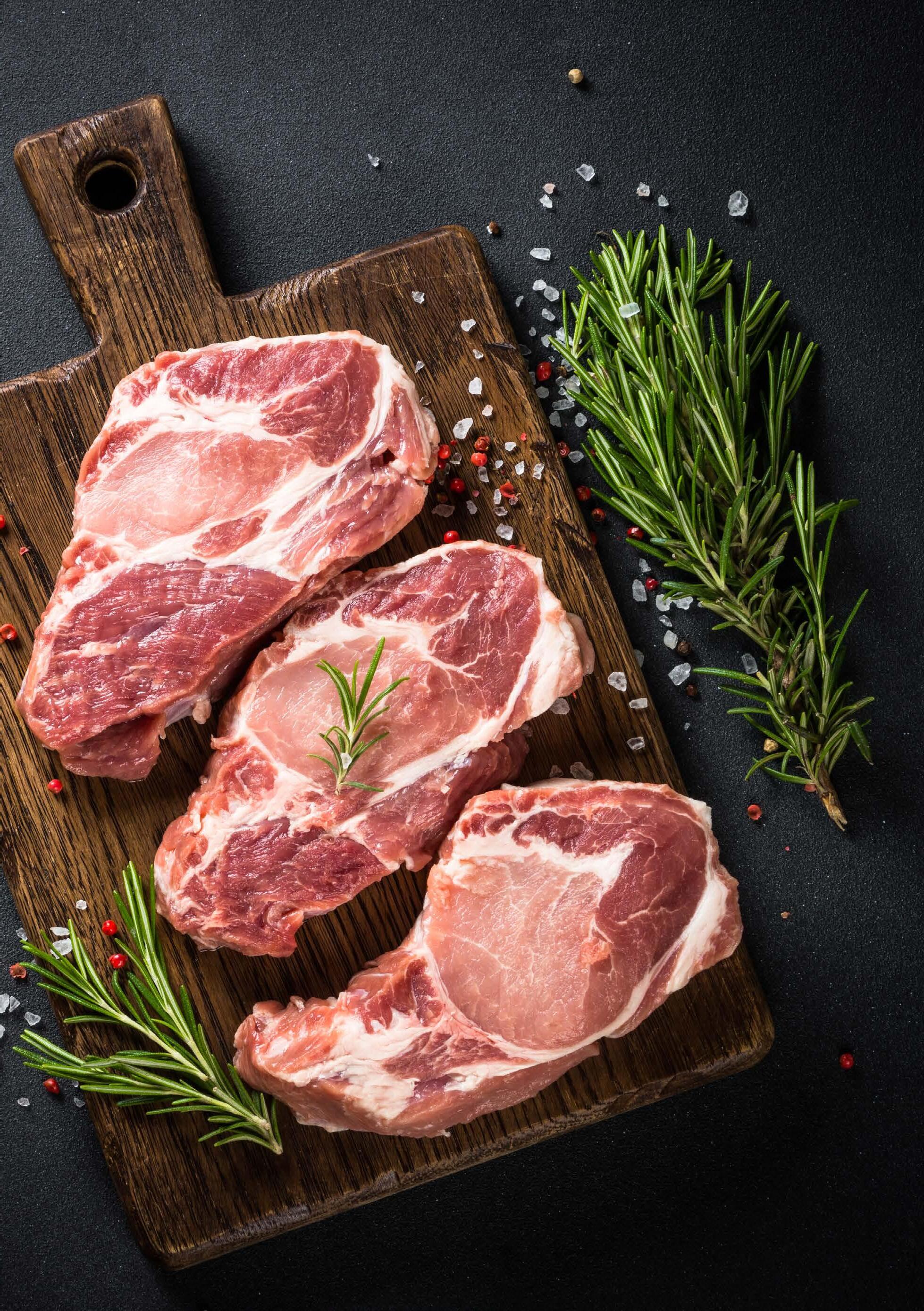
Quality is front and centre for our beef, sheep and lamb farmers, with many specialty breeds, using stress-free stock management and new grazing methods for optimum results.
Their efforts are paying dividends. South Australia’s premium meat is sought by high end restaurants across the world.
Major beef breeds from South Australia include Angus, Wagyu and Poll Herefords and are raised primarily on large and prime grazing properties in the Limestone Coast, Murray River, Lakes and Coorong, and Flinders Ranges and Outback.
Other premium beef breeds becoming popular include the smaller heritage breeds Red Pole, South Devon and Belted Galloway.
Free range lamb grown in coastal grazing country, fed on saltbush and native grasses and using stress free stock management and strict ethical principles, creates a tender meat with a distinctive, fresh flavour.

Easy care Dorper lambs are grown naturally in some areas of the state. This shedding breed is suited to the Australian climate and there’s no need for mulesing, crutching or shearing or chemicals to treat fly strike or lice.
A number of small pork producers are also specialising in heritage breeds such as Berkshires, Tamworths, Wessex, Saddlebacks and Large Blacks, and working
towards free range certification. South Australia is one of the largest pork processing states in Australia. Pigs are farmed across the state; most are in the Eyre Peninsula, Murray River, Lakes and Coorong.
South Australia boasts a number of small to medium sized smallgoods producers, selling the likes of chevapchichis, chorizo, metwurst, pancetta, and smoked and cured meats.
The options for serving ethically produced and premium quality meat have never been greater. More and more producers are emphasising their ethical and sustainable feeding and farming methods to differentiate themselves and their product and, as a result, encouraging consumers and foodservice customers to acknowledge the path their product has taken, from paddock to plate.
SOUTH AUSTRALIA’S BEEF, LAMB AND PORK PRODUCERS ARE FOCUSED ON FLAVOUR, QUALITY AND A SUSTAINABLE FUTURE.
LAMB GROWN ON SALTBUSH AND NATIVE GRASSES IS TENDER AND HAS A FRESH, DISTINCTIVE FLAVOUR PROFILE.South Australias’s premium meats appear in high end restaurants across the world.
Most beef producing businesses in South Australia are family owned. In fact, South Australia is home to one of Australia’s largest Full-blood Wagyu herds.
region
• South Australia’s main beef production regions are the Flinders Ranges and Outback, Limestone Coast, Murray River, Lakes and Coorong, Riverland, South East and Fleurieu.
• Mixed cattle and/or sheep producers are found across South Australia.
varieties
• Most beef is sold for meat production at about 12-15 months.
• Vealers, aged 7-8 months and ox, aged over two years, also produced.
• Major breeds produced for beef are Angus, Wagyu and Poll Herefords.
• Shorthorns and Simmentals also available.
• Smaller amounts of high eating quality breeds include Murray Grey, South Devon, Red Poll and Limousin.
First (or premium) cuts of beef include:
• Cube roll: Fillet steak, rib eye or scotch fillet steak/roast, cutlet.
• Rump: Roast, steak, medallion.
• Silverside/topside: Roast, steak.
• Striploin: Porterhouse, T-bone, roast.
• Premium pasture-fed beef is at its best October to January (after the spring flush).
• Beef is an important source of iron, zinc, omega-3, B vitamins, protein.
• A 150g serve of red meat provides more than 50% of the recommended dietary requirements for iron, zinc and protein.
There are two industry accepted beef grading systems: Ausmeat and Meat Standards Australia (MSA).
• Ausmeat grades are based on the age of an animal, definition and compliance.
• MSA grades its product on tenderness and labels according to recommended cooking method.
• Most producers of red meat sell through third party distributors or butchers.
• Small number of specialist butchers sell direct to restaurants.
• South Australian beef is sold nationally and overseas.
• Look for moist, well shaped cuts that are firm to touch, not slimy.
• A deep to medium red colour, with no discolouration or dry spots.
• Tenderness improves with ageing, however most benefit is in the first 28 days, based on optimum handling.
• Never wash beef under water.
• Slowly thaw beef in refrigerator at 0-4°C for 24-48 hrs prior to cooking.
• Keep beef at 0-4°C in the refrigerator.
• Keep fresh beef cuts sealed in original plastic in refrigerator, or on a plate loosely covered with foil or plastic for three days at most.

• Large cuts of beef, such as shoulder, brisket or legs, can be kept uncooked for 3-5 days.
• Store fat side up in cryovac bags.
• Meat packaged in cryovac bags can produce a confinement odour when opened. Odour should dissipate after 10-20 mins. If product smells after 20 mins, do not use it.
• If ageing out of cryovac, it is critical meat has good air flow around the product in a cool room with low humidity.
• Beef should be frozen at -15°C and kept for no longer than six months.
• Minced beef products should be used within 24 hours and only be kept frozen for three months.
• Do not refreeze thawed products.
• Roast, slow cook, grill, braise, stew, stirfry, sauté, or mince.
• Herbs and spices that go well with beef are allspice, basil, bay, chilli powder, curry, garlic, ginger, marjoram, oregano and thyme.
• The delicate flavour of veal is complemented by apples, figs, lemons, limes, and oranges.
PREMIUM PASTURE FED BEEF IS AT ITS BEST BETWEEN OCTOBER AND JANUARY.
LAMB
Some South Australian lamb is grown and fed on saltbush and native grasses, which give the meat a unique flavour.
region
• Main sheep meat production in Flinders Ranges and Outback, Limestone Coast, Murray River, Lakes and Coorong, and Yorke Peninsula.
varieties
• Most lamb sold is a meat breed crossed with merino.
• Most popular meat breeds are Poll Dorset, White Suffolk and Dorper.
• Other breeds are Black Suffolk, Hampshire, Southdowns, South African mutton merinos, romney and texels.
First (or premium) cuts include:
• Forequarter: Chop, rack, roast.
• Leg: Roast and steak.
• Loin: French cutlet, rack of lamb.
• Shank: Shank, drumstick.
• Shortloin: Backstrap, chop, roast.
season
• Very young and pink spring lamb available August to November.
• Flavour and meat colour develop throughout year.
• More well flavoured and deeper red product available May to July.
nutrition
• Valuable source of protein, minerals and B group vitamins,
including niacin, thiamin and riboflavin.
• 85g serving of grilled lamb leg steak provides 26% of iron, 33% of zinc and more than 100% niacin of the recommended daily intake.
• Lean and low in cholesterol compared with other animal proteins.
The two industry accepted lamb grading systems are Ausmeat and Meat Standards Australia (MSA).
• Ausmeat grades are based on the age of an animal.
• MSA grades product on tenderness and often labelled according to recommended cooking method.
• Most producers sell through third party distributors or butchers.
• A small number of specialist butchers sell direct to resturants.
• South Australian lamb is sold nationally and overseas.
• Lamb flavour improves immensely if it is hung, ideally for about a week.
• Lamb bones should be pink.
• Bones become whiter with age.
• Colour of fresh lamb meat varies according to age and pasture.
• Colour should be bright, moist (not overly wet) and brown/pink (not too red or bloody). Fat should be firm, dry and slightly crumbly (never yellow).
• Look for joints that are plump and nicely rounded with almost dry skin.
• Slowly thaw lamb in refrigerator, at 0-4°C for 24-48 hours prior to cooking.
• Refrigerate lamb at 0-4°C.
• Keep fresh lamb cuts sealed in original plastic in refrigerator, or on a plate loosely covered with foil or plastic, for three days at most.
• Large cuts of lamb such as shoulders or legs can be kept for 3-5 days.

• Store fat side up in cryovac bags.
• Meat packaged in cryovac bags can produce a confinement odour when opened. Odour should dissipate after 10-20 minutes. If product still smells, do not use it.
• If ageing out of cryovac, it is critical there is good airflow around the meat in a coolroom with low humidity.
• Freeze at -15°C. Keep up to six months.
• Minced lamb products should only be kept frozen for three months.
• Do not refreeze thawed meat.
• Roast, slow cook, grill, braise, stew, stirfry, sauté, or mince.
• Lamb flavours complemented by fresh and dried fruits, apricots, cranberries, dates, figs, and prunes.
TENDER, MOIST AND DELICATELY FLAVOURED, SPRING LAMB IS A HIGHLIGHT OF THE WARMER MONTHS.
South Australian piggeries range in size from a handful of sows in free range operations to several thousand in large commercial piggeries.
region
• The majority of South Australia’s pigs are bred in the Murray River, Lakes and Coorong.
• Some small to medium size piggeries in Limestone Coast, Riverland and Eyre Peninsula.
varieties
• Most pigs raised for meat have crossbred mothers Large White cross Landrace) and the sires are generally Large White, Landrace or Duroc.
• Other breeds include Berkshires and Hampshires, mostly in boutique or free range production.
• Berkshire meat, with extra flavour due to intramuscular fat, is popular among smallgoods makers, specialised butchers and chefs.
First Cuts
First (or premium) cuts include:
• Belly: Belly, rolled, spare ribs.
• Forequarter: Chop, roast, scotch fillet, shoulder.
• Leg: Mini roast, roast, steak.
• Loin: Chop, cutlet, rack, rolled, steak.
season
• Available all year.
• Lean trimmed pork is a good source of protein, thiamin, niacin, B6, B12, selenium, riboflavin, zinc, and omega 3.
market
• Most producers sell through third party distributors or butchers.
• A small number of specialist butchers sell directly to restaurants.
• South Australian pork is sold across Australia and overseas.
handling
• Meat should be pale pink in colour and have a subtle, sweet aroma.
• Best cooked on medium heat.
• Meat will continue to cook after it’s removed from the heat. Stop cooking just before fully cooked and rest to get right texture and juiciness.
• Slowly thaw pork in refrigerator at 0-4°C for 24-48 hours prior to cooking.
• Do not leave pork exposed at ambient temperature, as bacteria can multiply rapidly.
• To bring meat to ambient temperature, remove from refrigerator and cover immediately.
• Leave for a maximum 1-2 hours before cooking.
• Keep pork in the refrigerator at 0-4°C.
• For best quality, keep fresh pork cuts sealed in original plastic in refrigerator, or on a plate loosely covered with foil or plastic, for three days at most.
• Large cuts such as legs or shoulder can be kept in refrigerator at 0-4°C for 3-5 days.
• Cured pork meats can be refrigerated at 0-4°C in a plastic container for 2-3 weeks.
• Pork cuts should be frozen at –15°C and kept for six months.

• Whole hams should be frozen at -15°C and kept for 1-2 months.
• Frozen minced products should only be kept for three months.
• Do not refreeze thawed meat.
• Roast, slow cook, grill, braise, stew, stirfry, sauté, or mince.
• Pork and fruits work well. Try matching with apples, apricots, cranberries, currants, dried or fresh cherries or figs, mangoes, pears, peaches, pineapples, plums, quinces and strawberries.
LEAN, TRIMMED PORK IS A POWERHOUSE OF NUTRITION, CONTAINING NIACIN, PROTEIN, B6, B12 AND OMEGA-3.
SMALLGOODS MAKERS LOVE BERKSHIRE PORK, A BREED THAT PRODUCES INTENSE FLAVOUR DUE TO ITS UNIQUE MUSCLE-FAT RATIO.
South Australia’s smallgoods industry is influenced by German and Italian heritage.
• A number of butchers produce their own smallgoods.
• Famous smallgood products include:
• Bacon
• Black and white puddings
• Bung fritz (devon)
• Dry cured smoked hams
• Sausages
• Proscuitto
• Chorizo
• Speck
• Salami
• Red gum and Mallee stumps create unique smoked products, synonymous with South Australia.
Season
• Most products available all year.
• Some seasonal products such as cured hams at Christmas.
• Many producers accept orders for special seasonal produce or specialty products all year.
Market
• Many products available via national or state distributors.
• Some producers supply direct to restaurants and foodservice.
• Several producers have direct to consumer or online stores.
Handling
• Consume most packaged smallgoods within 2-3 days of opening.
• Once opened, store in airtight container. It is recommended to avoid plastic wrapping.
• Air dried and cured meats harden and increase in flavour intensity.
• If salt builds on outside of cured or air dried meats, wash with vinegar water.
Storage
• Refrigerate most cooked ready to eat products 0-4°C up to 3-4 days.
• Keep smallgoods separate from raw meats to prevent contamination.
• Keep age-fermented salami in cool, dry place (it will quickly pass its best in warm, moist weather).

• Can freeze most for 2-3 months, cured hams, dry or salted sausage products for 1-2 months, (it may alter flavours).
Serving
• Cured meats bring out the sweet, nutty and buttery flavours of hard cheeses like Parmesan and Romano.
• Cured meat is complemented by sweet and subtle fruits such as figs, pear or peach.
• Local cured meats shine well on their own or as a part of any wellcurated charcuterie board.
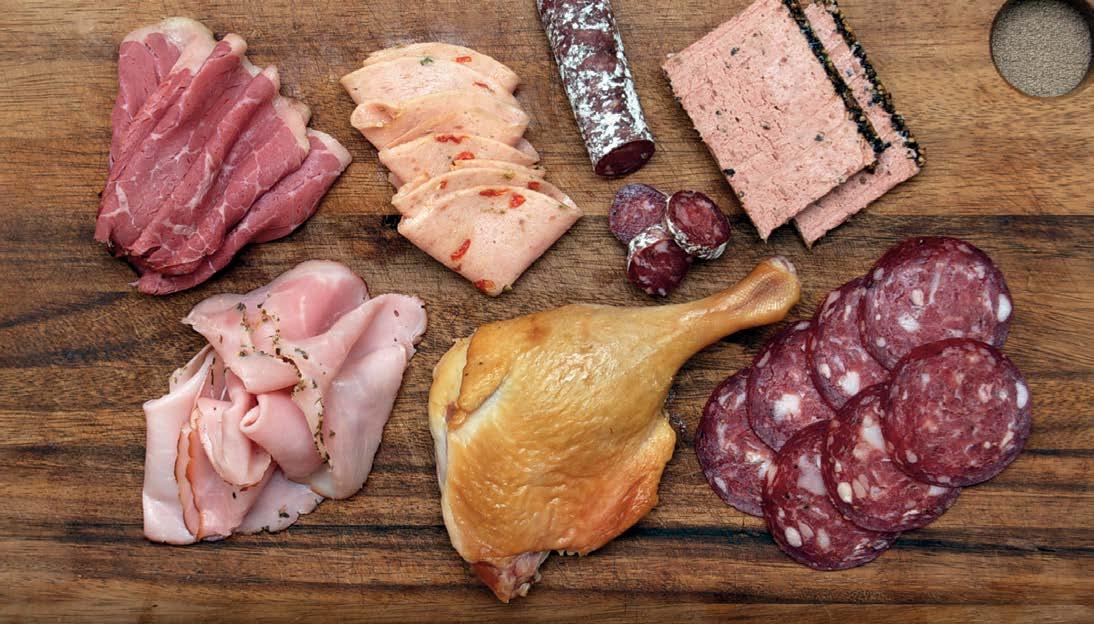
SOUTH AUSTRALIA’S SMALLGOODS INDUSTRY IS RENOWNED FOR ITS EUROPEAN CONNECTIONS.
RED GUM & MALLEE STUMPS GIVE MANY SOUTH AUSTRALIAN SMOKED PRODUCTS A DISTINCTIVE FLAVOUR.Several butchers specialise in their own smallgoods.
Unlocking the potential of secondary cuts of meat requires a touch of extra effort, but the rewards are truly remarkable. By embracing the whole beef or lamb product, from nose to tail, we not only honour the animal but also reap benefits that extend to the producer, business, and customer alike.
These once under-utilised, often overlooked cuts, as explored in this masterclass, are now highly sought after as they hold a hidden treasure trove of flavours. To extract their essence, the cooking process demands a little more time and attention, allowing the flavours to infuse and the meat to tenderise. With a discerning eye for quality and a knowledge of suitable cuts and cooking methods, you can achieve outstanding results without breaking the bank, unlocking an affordable world of culinary excellence.
There are two briskets per carcass. Whole brisket can be split into point end or navel end. Point end can be prepared with deckle (fat and intercostal meat) removed.
• Flavour: A classic slow braised beef flavour. Point muscle that sits on top of the fat is quite marbled and very juicy.
• Look for: Some marbling, deep red meat. Average weight 4-6kg up to 8kg. Bigger is better.


• Cook: Remove thin red muscle on outer surface (on navel end cut). Leave some fat on. Cut thin slices and cook slowly.
SHIN
Beef shin delivers all that the lamb shank does.
• Flavour: Stronger flavour punch than lamb shank.
• Look for: Trimmed ends of the shin. Excessively thick tendons are a sign of beef that may not break down in cooking.
• Cook: Braise whole, then peel off bone or cut into slices of shin to reveal bone marrow. Pair with a full-bodied South Australian shiraz in winter.
FLANK
One of four distinct cuts that is also referred to as skirt in Australia. Known as bavette in France.
• Flavour: Clean, beefy taste.
• Look for: Coarse grain, flat and lean cuts.
• Cook: Carving across the grain is critical to get this cut to perform at its best.
Prepared by removing silverskin and gristle from whole oyster blade. Also known as a feather steak. Economical.
• Flavour: Strong beefy flavour with faint hints of iron (liver), that handles a marinade well.

• Look for: Premium weight 0.8 to 1.2kg for grilling.
• Cook: An equal second for most tender cuts for grilling in a beef carcass (behind the scotch fillet).


In some beef loving countries, such as Argentina and Korea, this cut commands higher prices than porterhouse. Reasonably priced.
• Flavour: As gelatinous connective tissue melts, you get a rich mouthfeel in braised dishes.
• Look for: A good butcher to get the most from the cut, as only small section of rib is especially good.

• Cook: Serve braised, twice cooked or chargrilled slowly to medium for those who don’t mind a little chew.
The hanger holds the diaphragm and just one cut on carcass. Also referred to as the butcher’s steak and, in France, the onglet.
• Flavour: Very tender with strong iron/liver flavour.
• Look for: Some marbling adds to flavour and tenderness.
• Cook: Not suited to wet styles of cooking. Needs careful attention to ensure outside crust is dry.
Same portion of meat as pork belly, beef short ribs and brisket come from. An affordable lamb cut in good supply.
• Flavour: Has unique lamb softness and flavour.
• Look for: Can be a fatty cut, however if lean, the meat needs to be pale red or pink, otherwise it will be tough.

• Cook: Slowly while weighed down (by air pressure in pressure cooker when braising in a masterstock, or under a heavy ceramic dish when dry roasting) so fat renders off.
Cuts from forequarter include square cut shoulder. Contains a lot of soft collagen that breaks down when heated above 80°C.


• Flavour: Meat on the bone has strong, full flavour.
• Look for: The loin eye where the shoulder is cut should have a reasonable amount of fine marbling.
• Cook: Slow roast square cut shoulder in a wood fired oven until it is falling off the bone. Slow cook and pull as per America’s famous pulled pork.
Not to be confused with the boneless neck fillet of lamb, which is essentially chuck.
• Flavour: Sweet full flavoured meat.
• Look for: Trim excess surface fat for best results.
• Cook: Best on the bone at high temperature, then peeled off bone to serve.
Lamb topside from high quality lamb performs better than cheaper end backstraps. One of the muscles in the leg.

• Flavour: Highly trimmed, avoiding sheep flavour that comes through lamb fat. This cut preferred by those with no history of eating sheep meat.
• Look for: Make sure that the meat has a lighter red colour.
• Cook: Separate out of leg and slow roast to medium or medium rare for a juicy, flavoursome alternative to more expensive, low grade backstraps.
SOUTH AUSTRALIA’S FREE RANGE AND WILD CAUGHT MEATS BOAST FLAVOUR, HEALTH BENEFITS AND GREEN CREDENTIALS.


CHEFS ARE MAKING THE MOST OF GROWING CONSUMER APPETITES FOR WILD MEATS, FREE RANGE POULTRY AND DUCK.
Chefs are making the most of growing consumer appetites for wild meats, free range poultry and duck.
Food-educated consumers are driving the expansion of new markets, as their growing knowledge and appreciation create opportunities for exploration and innovation. Popular cooking shows are opening up new markets for the state’s game meats such as goat, kangaroo, venison and wild rabbit.
Chefs in South Australia have access to a variety of wild kangaroo meat, offered as selected cuts, controlled portion sizes and long life packaging, as well as customised products.
Game offers many benefits – not only is it rich in flavour, low in fat and high in protein, it is a perfect fit with the state’s clean, green environment and leaves a small environmental footprint.
From a robust goat curry or lightly seared roo steaks to tender, slow braised rabbit, there are plenty of ways to make the most of South Australia’s great game products.
Consumer demand for free range and pasture raised poultry is behind a thriving industry that has doubled since 2004.
The state has a mix of large and small companies producing high end specialty products such as free range muscovy ducks and geese. There is a range of chickens, pheasants, turkeys and geese, including free range and corn fed, specially produced for foodservice, wholesale and retail clients.
New and inspired value added poultry meat products continue to grow, and include such options as boneless rolls, boned whole chickens, smoked, crumbed and maryland. The options for serving premium quality poultry have never been greater. Whether you’re after pre-prepared meal options or the premium raw product, the state’s poultry producers ensure you’re spoilt for choice.

GAME’S BENEFITS ARE VARIED: LOW IN FAT, HIGH IN PROTEIN, IT LEAVES A SMALL ENVIRONMENTAL FOOTPRINT.
Australia includes:
• Deer (venison)
• Game birds – pheasant, quail
• Goat – chevon, capretto
• Guinea fowl
• Kangaroo
• Rabbit
• Wild boar.
• Kangaroo is South Australia’s most readily available game meat.
• Deer and goat are wild caught and farmed.
• Federal Government authorities manage the killing and processing of kangaroo and wild game meat via licences, quotas and processing regulations.
Region
• Kangaroo is sourced mainly from the state’s Eyre Peninsula, and Flinders Ranges and Outback.
• Most wild deer meat is sourced from the Limestone Coast.
• Wild goat is mainly sourced from the eastern pastoral zone and Flinders Ranges.
• Small number of deer and goat farms are found across the state’s agricultural regions.
• Several small to medium sized growers of game birds are based in the Barossa Valley and Fleurieu Peninsula.
season
• Most wild game available all year.
• Seasonal influences, such as drought and floods, can affect numbers and availability.
• Controlled wild harvest means there can be wide ranging size, age, gender and local environmental influences on carcass quality.
• Most game birds grown to 16-18 weeks of age.
nutrition
• Kangaroo is a source of omega-3 and is high in protein, iron and zinc, as well as a good source of the B group vitamins and has less than 2% fat.
• Most game meats, including goat and rabbit, contain a lower fat content than beef, lamb or pork.

market
• Small number of producers sell direct to restaurants and/or have online sales.
• Most game is sold nationally.
• Kangaroo and goat are exported.
Handling
• Serve game very hot or very cold. Lukewarm game fat has a very greasy taste.
• Game should look moist, be well shaped and firm to the touch, not slimy, with no dry spots or discolouration.
• Kangaroo should be cooked rare to medium rare, except for sausages and mince, which must be cooked thoroughly.
• The skin on game birds should be smooth and supple, the wing tips moist and pliable.
Storage
• Meat, packaged using the modified atmosphere and vacuum packaging, can be refrigerated at 0-4°C for 1-2 weeks.
• Fresh game can be frozen for up to six months at -15°C.
• Fresh game can be frozen up to 6 months (fresh) or four months (seasoned/cured) at -15°C in original packaging or tightly sealed, foil, plastic wrap or freezer bags
• Slowly thaw frozen game overnight in the refrigerator at 0-4°C.
• Do not refreeze thawed game meats.
SOUTH AUSTRALIA’S GAME PRODUCTS ARE SOLD NATIONALLY, KANGAROO AND GOAT ARE EXPORTED.
GAME HAS A UNIQUE DEPTH OF FLAVOUR AND ADDS A POINT OF INTEREST TO A MENU. TEAM WITH NATIVE FRUIT OR BERRIES FOR A DISH THAT STANDS OUT FROM THE CROWD.
South Australia’s poultry industry includes chicken, duck, turkey and goose.
region
• Major chicken meat producers are located in the Adelaide Hills, and Murray River, Lakes and Coorong.
• A small number of producers of free range chicken, duck and turkey in Barossa, Fleurieu Peninsula, Kangaroo Island, and Murray River, Lakes and Coorong.
Varieties
Chicken
• Breeds used for chicken meat are commercial hybrids.
• Most chickens harvested at 5-8 weeks of age.
• Average weight of whole chicken is 1.5kg. Sizes available:
• Number 8: 0.8kg
• Number 9: 0.9kg
• Number 10: 1kg
• Number 11: 1.1kg
• Number 12: 1.2kg
• Number 13: 1.3kg
• Number 14: 1.4kg
• Number 15: 1.5kg
• Number 16: 1.6kg
• Number 17: 1.7kg
• Number 18: 1.8kg
• Number 19: 1.9kg
• Number 20: 2kg
Duck
• Most popular meat ducks bred are Pekin and Muscovy.
• Most ducks harvested at about six weeks, weighing about 2.85kg.
Turkey
• Most popular breed is the modern white hybrid.
• Most turkeys harvested at 6-10 weeks, weighing about 2.5-5kg.
season
• Chicken, duck and processed turkey meat available all year.
• Whole turkey and a small amount of goose more readily available prior to Christmas.
nutrition
• Chicken and turkey meat is low in fat and provides essential vitamins and minerals, particularly niacin, Vitamins A and E and magnesium.
• Skinless duck is lower in fat than chicken and is a good source of protein, Vitamins A and B3, iron, selenium and calcium.
market
• Most producers sell via third party distributors and specialist butchers.
• Some sell direct to restaurants or online.
Handling
All poultry
• Slowly thaw frozen poultry meat in the refrigerator at 0-4°C overnight and ensure it’s completely thawed prior to cooking.
• Before cooking, check there are no ice crystals in body cavity, and legs and thighs are soft and move easily.
• Pat dry with a cloth or absorbent paper towel prior to cooking.
Chicken
• The standard guide for cooking chicken is to allow 20 minutes per 500g plus 20 minutes extra.
• Always leave to rest for about 10 minutes to allow juices to settle and prevent meat from drying out.
Duck & goose
• Duck is dark, tender, mild flavoured.
• Duck breast is lighter and has a milder flavour than the leg.
• Duck and goose have a thick layer of fat under the skin. Prick skin all over to allow fat to render and escape when cooking.
Turkey
• Turkey is the leanest poultry and will dry out if overcooked.
• Darker meat, mild gamey flavour.
Storage
• Store uncooked poultry meat sealed in the refrigerator at 0-4°C.

• Sealed, pre-packed fresh poultry products keep for up to three days.
• Freeze poultry at -15°C for up to six months.
• Do not refreeze thawed poultry meats.
CHICKEN AND TURKEY MEATS ARE LOW IN FAT, SKINLESS DUCK IS LOWER IN FAT THAN CHICKEN.
Goat
• Citrus fruits
• Currants
• Garlic
• Middle Eastern spices
• Rosemary
Guinea fowl
• Apples
• Bacon
• Bay leaves
• Chestnuts
• Cider
• Garlic
• Thyme
Pheasant
• Apples
• Bacon
• Cured meats
• Lemons
• Mushrooms
• Oranges
• Raisins.
Chicken
• Apples
• Apricots
• Citrus fruits
• Cranberries
• Cured meats
• Currants
• Garlic
• Ginger
• Grapes
• Honey
• Mangoes
• Peaches
• Pears
• Pomegranates
• Prunes
• Thyme
Rabbit
• Citrus fruits
• Cured meats
• Currants
• Fennel
• Plums
• Prunes
• Sage
• Thyme
Kangaroo
• Garlic
• Juniper berries
• Oranges
• Plums
• Quandongs
• Red currants
• Rosemary
Venison
• Cherries
• Citrus fruits
• Cranberries
• Dark chocolate
• Raspberries
• Sherry
• Vinegar
Duck
• Apricots
• Asian style flavours such as:
• Ginger
• Soy sauce
• Star anise
• Blueberries
• Cherries
• Citrus fruits
• Cranberries
• Currants
• Dates
• Figs
• Mangoes
Turkey
• Apricots
• Chestnuts
• Garlic
• Marjoram
• Pistachios
• Plums
• Raspberries
• Rosemary
• Saffron
• Sage
• Walnuts
Game meats boast unparalleled flavour profiles, often with lower fat and cholesterol content compared to readily available meats. Although their unique flavours and leaner cuts require careful cooking, once you master this art, a whole new realm of meat flavours and inspiration awaits.
Among the most beloved game meats in Australia, kangaroo meat takes the spotlight. It is a quick and versatile option with exceptional nutritional properties. Packed with high-quality protein, iron, and zinc, it boasts minimal fat content (less than 2%) and is a rich source of heart-friendly omega-3s. It’s no wonder why it has captured the hearts of so many!
Unleash your senses and embark on a tantalizing journey through South Australia’s game meats with this invigorating masterclass. Discover the unique and captivating flavours that await, opening your palate to a world of food wonders.
• Farmed. Mostly sold at about 16-18 weeks.
• Hens are better eating than male birds.
• Available whole, breast and leg.
• Taste: White meat with a sweet, earthy, relatively mild flavour.
• Flavour matches: Cured meats, bacon, mushrooms, oranges, juniper berries, plums, prunes.
• Cooking: Roasts, braises, casseroles, confits. Take care not to overcook.
• Wild harvested.
• Mostly sold whole, available in loin (also known as saddle), back legs, front legs (or shoulders) and neck cuts.
• Taste: Wild rabbit is a darker, lean and tight meat with rich, earthy flavours. Not suited to roasting or grilling.
Farmed rabbit is a white meat with more fat, softer texture and delicate, subtle game flavours.


• Flavour matches: Most Asian flavours, fennel, smoked or cured meats, rosemary, sage, thyme.
• Cooking: Slow, wet style cooking, roasts (farmed only), braises, casseroles, confits.
• Farmed. Mostly sold at about 16-18 weeks.
• Taste: A lighter tasting game bird, described as a cross between chicken and pheasant.

• Flavour matches: Apples, bacon, bay leaves, brandy, chestnuts, cider, garlic, parsley and thyme.
• Cooking: Roasts, braises, casseroles, confits, substitute for chicken in most recipes.
• Wild harvested. Loin fillet is prepared from a loin set.
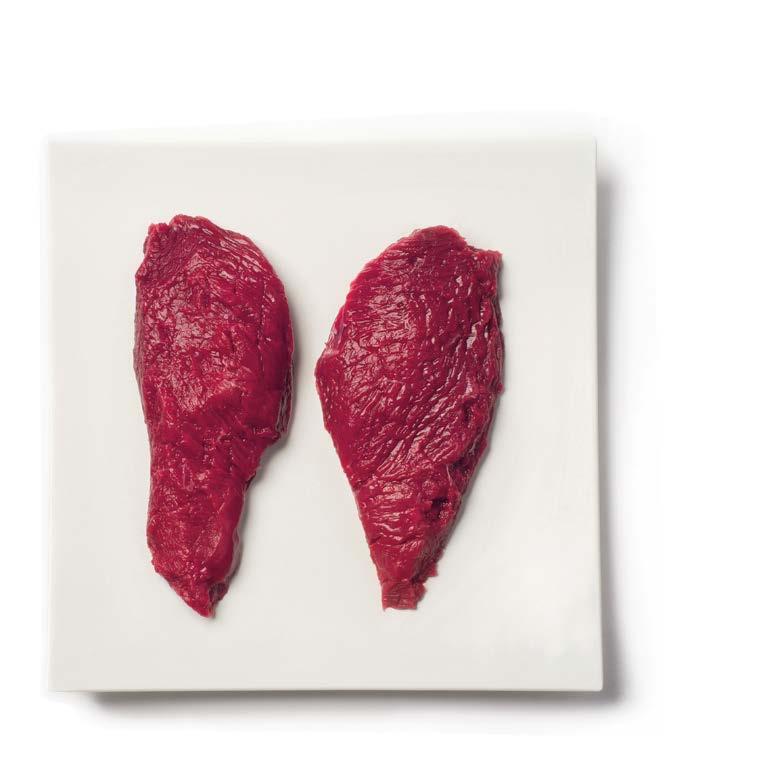


• Taste: Mild gamey taste, similar to venison.
• Flavour matches: Fruity flavours (such as plum, red currant, quandong, orange), garlic, juniper, mountain pepper/pepper and rosemary.
• Cooking: Best cooked quickly, rare to medium rare, pan fry, grill, stirfry. Rest before serving.
• Farmed and wild harvested (a small proportion). Young or kid goat often referred to as capretto, older goat (6–18 months) is known as chevon.
• Prepared and sold in similar cuts to lamb.
• Wild goat is often leaner and tougher than farmed goat.
• Taste: Capretto has similar flavour to lamb but a bit sweeter. Chevon has firmer muscle texture and a milder, gamey flavour.
• Flavour matches: Garlic, lemon, Middle Eastern spices, oregano, rosemary.
• Cooking: Baking and slow cooking, such as casseroles, curries, tagines. Marinate before cooking to tenderise.
• Wild harvested. Topside is prepared from a leg.
• Taste: Mild game taste, similar to venison.
• Flavour matches: Fruity flavours (such as plum, red currant, quandong, orange), garlic, juniper, pepper, rosemary.
• Cooking: Longer cooking times over low heat, casseroles, curries, pies. Rest before serving.
SOUTH AUSTRALIAN SEAFOOD IS HIGHLY PRIZED BY SOME OF THE WORLD’S MOST DISCERNING MARKETS, AND IT’S EASY TO SEE WHY.


SOUTH AUSTRALIA IS RENOWNED FOR ITS WORLD LEADING AQUACULTURE AND WILD FISHERIES.

Pristine waters, the industry’s careful environmental management, innovative marketing, convenient packaging and inroads into traceability are driving this success.
Four main regions – Eyre Peninsula, Yorke Peninsula, Kangaroo Island and Limestone Coast – are home to the state’s multimillion dollar southern bluefin tuna, oyster, abalone, southern rock lobster, Spencer Gulf king prawn, scallop, and blue swimmer crab industries.
Southern bluefin tuna, lobster and abalone dominate the state’s exports, which attract premium prices in high end markets including Japan, Hong Kong and China.
The industry works closely with the State Government to ensure fish stocks and the marine environment are managed sustainably.
Several seafood sectors, including the Lakes and Coorong Pipi Fishery and the Spencer Gulf Prawn Fishers, have achieved independent certification for their world class management and sustainability efforts.
In keeping with the paddock to plate movement, traceability of product is high; customers can now find out the date and place each tuna was caught.
There is an increased focus on underutilised species which is opening up more market opportunities.
WHEN IT COMES TO COOKING, YOU WON’T FIND A BETTER QUALITY PRODUCT, SO THINK SOUTH AUSTRALIAN AND EMBRACE OUR BRILLIANT SEAFOOD FOR A SHOW STOPPING MENU.
ABALONE
Wild catch of blacklip accounts for 10%, and greenlip accounts for 90% of industry.
• 493 tonnes harvested annually.
region
• Wild catch is harvested from Great Australian Bight.
• Commercial farms of abalone are based in Port Lincoln, Streaky Bay and Kangaroo Island.

Season
Wild harvested
• Peak season February to May.
• Subject to strict quotas.
Farmed
• Available all year.
• Most sold frozen, whole in shell.
• Small amount available as live abalone.
appearance
• Slightly acidic cream aroma (fresh).
• Mild to strong meaty flavour with subtle sweetness.
• Raw: crisp bite, subtle mouthfeel.
Handling
Canned
• Drain and rinse well before use.
Frozen
• Should show no signs of freezer burn, cuts or tears to the flesh.
• Thaw slowly, preferably overnight, in a coolroom in airtight container.
Storage Fresh
• Keep refrigerated at all times at 0-4°C. Can be kept for up to 24 hours.
Frozen
• Store -15°C up to three months.
Serving
• Farmed has shorter cooking time.
• Braise, poach, stirfry, sashimi, grill or roast (both varieties).
• Complements sweet and sour flavours such as honey or citrus fruits, as well as the full range of Asian flavours especially ginger, chilli and lemongrass.
• Take care to ensure no loss of flavour or that flesh becomes tough.
BLACKLIP appearance
• Blacklip is only wild harvested.
• Weighs 100-400g (fresh meat), shell up to 20cm (fully grown).
• Clear white or cream meat (when cleaned of gut, roe and frill).
• Slight black tinge to meat edge.
GREENLIP appearance
• Both have pearl white meat.
Wild harvested
• Weighs 150–500g (fresh meat), shell up to 20cm (fully grown).
• Intense, full round flavour, with lingering sweetness.
Farmed
• Considered the number one sashimi grade in Japan.
• Harvested around three years, weighs 110-120g and shell 7-11cm.
• Slightly sweeter taste than wild.
• Price per piece is often less than wild, depending on grade.
• Mainly sold as frozen whole in shell.
HYBRID appearance
• Known as tiger abalone.
• Specially bred combination of greenlip and blacklip, more suited to canned or live product.

• Harvested around three years, weighs 110g-120g, shell 7-11cm.
• Slight green tinge to meat edge.
• Slightly sweeter aroma than wild.
THERE ARE THREE TYPES OF ABALONE IN SOUTH AUSTRALIA, GREENLIP, BLACKLIP AND HYBRID.

SOUTHERN CALAMARI
Each year, 350 tonnes of calamari are harvested.
Region
• Found mostly at the base of the Eyre Peninsula.
Season
• Available all year.
• At best May to August (and readily available).
appearance
• Mottled purple/brown skin with long, rounded side fins.
• Average size: about 15-20cm long and up to 2kg in weight.
Handling
• Avoid washing with fresh water as can affect flavour and texture.
• Defrost frozen calamari slowly, overnight in a coolroom.
Storage
• Refrigerate in sealed airtight container at 0-4°C. Use within 24 hours.
• Once cleaned, wrap hood, wings, and tentacles tightly in freezer wrap.
• Freeze at -15°C up to three months.
• Do not refreeze thawed calamari.
Avoid washing calamari with fresh water as this can affect texture and flavour.
Serving
• Southern calamari has mild, subtle flavour, with low to medium oiliness.
• Highly versatile, easy to cook, goes well with herbs and spices.
• Best cooked fast over high heat or slowly over low heat with plenty of moisture.

• Ink sac easier to remove from frozen whole calamari.
• Ink is viscous; intensely flavoured.
SOUTHERN CALAMARI IS FOUND THROUGHOUT THE SOUTH AUSTRALIAN COAST.
MOST CALAMARI IS RETAINED FRESH OR ON ICE BY COMMERCIAL FISHERS IMMEDIATELY UPON CAPTURE AND ARE TYPICALLY SOLD ON THE SAME DAY.
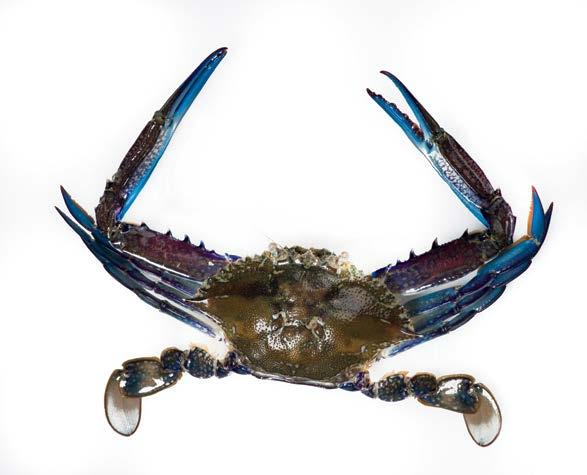
Commercial fishers use baited pot method, harvesting 592 tonnes annually.
Region
• Found throughout Gulf St Vincent and Spencer Gulf.
Season
• Spencer Gulf commercial season: February to December.
• Gulf St Vincent commercial season: January to October.
appearance
• Average weight: 300g-400g.
• Average meat yield 35% (from claws and body).
Fresh
• Look for brightly coloured, firm, intact, lustrous blue shells.
• No discolouration, particularly at joints.
• A pleasant fresh sea smell.
• If possible, give gentle shake. If you hear sloshing water, do not buy.
Cooked
• Shell colour turns bright orange.
• Mild, sweet, nutty flavour.
• Low oiliness.
• Flesh is moist, evenly textured and firm.
handling
• Most of the meat is found in back swimming legs.
• Claw meat is firmer than that found in body and legs.
• Do not recook cooked crabs.
Storage
• Best stored trussed and still alive.
• Wrap crab (in shell) in plastic wrap or foil, store in an airtight container in refrigerator at 0-4°C.
• Refrigerate cooked (in shell) up to three days at 0-4°C.
• Freeze whole crab (in shell) or crab meat up to three months at -15ºC.
• Do not refreeze thawed crab meat.
Serving
• Steam, poach, deep fry, pan fry or stirfry.
• To cook whole crab, place chilled whole crabs in a large pot of rapidly boiling salted water (½ cup table salt to 2.5 litres water), for eight minutes per 500g-1kg (timed from when the water returns to the boil). Refresh in iced water.
• Chilli crab, coconut crab and crab bisque are favoured recipes.
• Complemented by anchovies, butter, chervil, chilli, coconut, coriander, garlic, ginger, lemon, lemongrass and lime.

CLAW MEAT IS FIRMER THAN THAT FOUND IN THE BODY AND OTHER LEGS.Blue swimmer crabs are found across South Australian waters.

FIN FISH
There is a wide range of fin fish harvested and farmed in South Australia’s clean, green and unique marine waters and inland lakes, such as:
• Barramundi
• Bony bream
• Flathead
• Flounder
• Garfish
• Golden perch
• Spencer Gulf Kingfish
• King George whiting
• Leather jacket
• Mullet
• Mulloway
• Snapper
• Yellow eye mullet
Underutilised species:
• Ocean Jacket
• Tommy Ruff (Australian Herring)
• Australian Salmon
• Knifejaw
BARRAMUNDI
All barramundi grown in South Australia is farmed in closed tank systems.
Region
• Farmed on the Limestone Coast.
Season
• Available year round.
• Second most eaten fish in Australia.
• Whole fish weight can be as much as 4-5kg.
Appearance
• Look for firm flesh, clear eyes and shiny skin.
• White flesh.
• Flavour is fresh, clean and sweet.
• Fresh fish aroma is clean rather than salty.
• Texture is firm and moist when cooked.
• Low fat content.
Handling
• Store whole as gilled, gutted and scaled.
• Wipe cavity clean, wrap tightly in freezer wrap.
• Avoid rinsing in fresh water as can damage delicate flavours and texture of flesh.
Storage
• Refrigerate at 0-4C for up to 24 hours.
• Wrap whole fish or fillets individually and keep in an airtight container for up to three months at -15ºC.
• Do not refreeze thawed product.
Serving
• Whole fish suits Asian pan frying techniques, with excellent skin crisping, or charcoal grill.
• Fillets and portions are best grilled, pan fried or crumbed.
Coorong Mullet is wild caught in salt water coastal lagoons.
Region
• Wild caught along Coorong coastal region near the mouth of the Murray River.
Season
• Available most of the year.
• Most readily available in winter and at its best between April and December.
• Whole fish weight around 200g.
Appearance
• Fresh caught fish fillets are usually bronze/green colour but can vary to almost white at certain times of year.
• Flavour is sweet and more delicate than other species of mullet.
• Texture is very delicate.
• High in omega-3.
Handling
• Store whole as gilled, gutted and scaled.
• Wipe cavity clean, wrap tightly in freezer wrap.
• Avoid rinsing in fresh water as can damage delicate flavours and texture of flesh.
Storage
• Refrigerate at 0-4C for up to 24 hours.
• Wrap whole fish or fillets individually and keep in an airtight container for up to three months at -15ºC.
• Do not refreeze thawed product.
Serving
• Ideal for pan frying and grilling.
• Can be served crumbed.
Flathead is predominantly wild caught in deep water.
Region
• Wild caught in the Great Australian Bight on the state’s west coast.
Season
• Available year round.
• Biggest catches in the winter.
• Whole fish weight averages 400g but can vary from 200g to 3kg.
Appearance
• Whole fish has a dull brown appearance.
• Look for pale pink to off white colour in fresh fillets.
• Fresh fish has a fresh sea aroma.
• Cooked fillets are a clean white colour.
• Firm texture that flakes easily when cooked.
Handling
• Store whole as gilled, gutted and scaled.
• Wipe cavity clean, wrap tightly in freezer wrap.
• Avoid rinsing in fresh water as it can damage delicate flavours and texture of flesh.
Storage
• Refrigerate at 0-4C for up to 24 hours.
• Wrap whole fish or fillets individually and keep in an airtight container for up to three months at -15ºC.
• Do not refreeze thawed product.
Serving
• Suits cooking methods such as poaching, baking, steaming.
• Most often served crumbed and pan fried.
• Firm but flaking texture also suits deep frying for fish and chips
Farmed from wild brood stock in open sea cage sites.
Region
• Farmed around Spencer Gulf.
Season
• Available year round.
• Largest grade harvested June to October.
• Winter: Average whole fish weight 4.45-5.5kg, 16-19% flesh fat content.
• Summer: Average whole fish weight 3.5-4.5kg,14-17% flesh fat content.
Appearance
• Look for lustrous skin, firm flesh (whole).
• White to pale pink flesh.
• Flavour is sweet, rich, clean.
• Light, suggestions of chicken broth aroma (fresh).
• Faint savoury hints with clean acidic notes (cooked).
• Tightly textured, broad scalloping, large flakes (cooked).
Handling
• Store whole as gilled, gutted and scaled.
• Wipe cavity clean, wrap tightly in freezer wrap.
• Avoid rinsing in fresh water as can damage delicate flavours and texture of flesh.
Storage
• Keep whole gutted at 0-4°C. Keep for 24 hours.
• Wrap fillets individually on absorbent paper, then cling wrap, and keep in airtight container.
• Remove from storage close to service to prevent oxidising.
• Whole, cutlets or fillets should be wrapped tightly in freezer wrap and frozen for up to three months at -15°C.
• Do not refreeze thawed product.
Serving
• Roast, poach, steam, smoke and sashimi. Collar meat is also great as a fish curry.
• Also use the lips, wings and cutlets for any application.
Predominantly caught via hook and line or small net operations.
Region
• Wild caught throughout Eyre Peninsula, Gulf St Vincent and Spencer Gulf.
Season
• Caught year round.
• Most readily available June to September.
• Larger size caught November to February.
• Whole fish weight in winter 145g-1.5kg (31-60cm).
• Whole fish weight in summer 145g-2kg (31cm-70cm).
Appearance
• Bronze spots, dusky yellow markings, elongated shape.
• Largest of Australia’s 11 varieties of whiting.
• Pleasant fresh sea smell (fresh).
• Translucent grey/white flesh (fresh).
• Low flesh fat content.
• Flavour is delicate, sweet, unique burst on back palate (cooked).
Handling
• Store whole fresh fish as gilled, gutted and scaled.
• Wipe cavity clean, wrap tightly in freezer liner to prevent flesh drying out.
• Avoid rinsing in fresh water as it can damage delicate flavours and texture of flesh.
Storage
• Wrap whole fish or fillets individually and keep in an airtight container for up to three months at -15ºC.
• Refrigerate at 0-4°C. Keep for 24 hours.
• Thaw overnight in coolroom in sealed container over drip tray.
• Can be frozen -15°C whole for six months or as fillets for three months.
• Do not refreeze thawed product.
Serving
• Best cooked on the bone.
• Fillets best cooked with plenty of moisture and medium heat.
• Pan fry, poach, steam, deep fry, or roast.
Predominantly caught via handline or longline methods. Due to the decline of Snapper stocks in recent years it is noted that this fishery is closed until 30 June 2026
region
• Wild caught off Eyre Peninsula, Spencer Gulf and Gulf St Vincent except 1 November to 15 December, when snapper fishing is prohibited.
Season
• Available year round.
• Most abundant July to August, early December.
• Winter: 2-3kg whole weight, low to medium flesh fat content.
• Summer: 10-12kg whole weight, medium fat content.
appearance
• Cooked has pearl white flesh.
• Raw flesh has variable colouring from white to pink/grey.
• Shiny, translucent, cherry red blood line.
• Carries a layer of fat just under skin.
Handling
• Recommended to buy whole, unscaled and ungutted for sashimi.
• Store whole fresh fish as gilled, gutted and scaled.
• Wipe cavity clean, wrap tightly in freezer wrap to prevent drying out.
• Avoid rinsing in fresh water as can damage delicate flavours and texture of flesh.
Storage
• For longer shelf life, keep whole (gutted and scaled) before filleting.
• Fillets are best dry cut.
• Wipe gently with a cloth dampened in salt water.
• Refrigerate at 0-4°C for up to 24 hours.
• If frozen, thaw in coolroom overnight over a drip tray in sealed container.
• Do not refreeze thawed product.
serving
• Skin crisps up with pork crackling like qualities.
• Sashimi, poach, pan fry, grill, steam, roast or fry.
Predominantly caught via net operations and hook and line.
Region
• Found in sheltered bays off Kangaroo Island, West and South East coasts in Gulf St Vincent and Spencer Gulf waters.
Season
• Fished year round except May (Spencer Gulf) and June (Gulf St Vincent) when restrictions are in place for commercial fishers to protect stocks.
Appearance
• Pale green/blue on back and upper sides, broad, blue edged silver along middle side with distinct beak on lower jaw.
• Measure 21.5cm fully grown.
• Low flesh fat content.
• Flavour is sweet and mild.
• Flesh is soft, fine and white.
Handling
• A delicate fish; fillets are best butterflied.
Storage
• Wrap fillets tightly and store in a sealed container.
• Refrigerate at 0-4°C. Keep for 24 hours.
• Can be frozen -15°C whole for six months or as fillets for three months.
• Thaw overnight in coolroom over a drip tray in sealed container.
• Do not refreeze thawed product.
Serving
• Shallow pan fry (gently), poach, roast, sashimi or steam.
MUSSELS & PIPIS
Mussels and pipis are available through direct sales to restaurants.

MUSSELS
South Australia harvests 1,845 tonnes of mussels annually.
region
• Mostly farmed in the lower Spencer Gulf, near Port Lincoln.
Season
• Harvested year round.
• Petit bouchet mussel available June to September.
appearance
• Plump, full gonad, strong orange/ peach (female) or creamy white (male) colour.
• Shell to meat ratio, more than 38%.
• Clean, sweet, seaweed aroma (fresh), savoury, hints of spiced saffron (cooked).
• Soft and buttery texture (cooked).
• Petit bouchet: Small French style mussel.
Handling
• Live, pot ready mussels have 10 day shelf life.
• Rinse with fresh water before use.
storage
• Keep in pack until use. Store in refrigerator at 0–4°C.
• Store live, loose mussels at 5°C (optimum refrigeration temperature) for up to 24 hours.
• Do not freeze live mussels (either loose or pot ready).
Serving
• Mussels absorb flavour readily.
• Steam, poach, roast, bake, strifry.
• Complemented by white wine, garlic, chilli, saffron, anchovy, tomato and many fresh herbs.
• Steamed meat extracted from shell can be coated.
PIPIS
Also known as cockles, 500 tonnes of pipis are harvested annually.
region
• Harvested from Coorong beach region.
Season
• September to June.
appearance
• Size: 35-55mm shell.
• Average meat/weight ratio 30%.
• Brightly coloured, intact, lustrous shells. Closed or should close when
tapped/gently squeezed.
• Pleasant sea smell aroma (fresh).
Handling
• Allow around 600g of whole shells per person as a main course.
storage
• Keep in pack until use. Store in refrigerator at 0-4°C.
• Store live, loose pipis at 0-4°C (warmest part of refrigerator) for up to 24 hours.
• Pipis, in shell or as meat, can be frozen at -15°C in an airtight container for up to three months.
• Do not refreeze thawed product.
Serving
• Complemented by anchovies, chilli, coriander, garlic, ginger, parsley, soy sauce, tomato, white wine and Worcestershire sauce.
• Steam, poach, or stirfry.
MUSSELS ARE HARVESTED YEAR ROUND, PIPIS ARE HARVESTED NOVEMBER TO JUNE.
PIPIS CAN BE STEAMED, POACHED OR WOK-FRIED; ALOW 600G OF WHOLE-SHELL PIPIS PER MAIN COURSE.
Pacific and angasi oysters are available March to December, with spawnless Pacific available year round.


Handling
• Thaw frozen oysters overnight in refrigerator at 0-4°C.
• Once thawed, consume on same day.
• Front opened oysters are typically placed back in shell after washing, with belly facing up.
Storage Live
• Discard any gaping oysters.
• Angasi are best kept closed. Place a weight or individual tie around each oyster to keep closed.
• Cover with damp cloth in airtight container at 4-10°C (8°C optimum refrigeration temperature), up to eight days.
• Shelf life may be reduced if kept at 4°C.
Pre-opened
• Consume on day of purchase, store at 0-4°C.
Opened
• Store at 0-4°C for less than 24 hours.
Freezing
• Freeze opened and unopened oysters up to three months. Cover with freezer wrap to prevent freezer burn.
• Do not refreeze thawed product.
Serving
• Natural, steam, poach, roast, fry, grill or bake.
• Larger oysters best eaten cooked.
• Care needed not to overcook –stop once edges start to curl.
• Best within 20 minutes of opening.
• Natural: Complemented by lemon, chilli and cracked pepper and (angasi) Asian flavours.
• Cooked: Complemented by bacon, breadcrumbs, fresh herbs, ginger, lime; (Pacific) chilli, lemon, pepper; (angasi) balsamic vinegar, horseradish or roasted capsicum.
ANGASI
Region
• Native to and farmed in Eyre Peninsula.
Season
• Available March to December.
• Best May to August.
• Texture varies depending on season:
• April to August: Soft, ripe, creamy.
• September to December: Lean, firm.
NEW SPAWNLESS OYSTER FARMING HAS HELPED MEET DEMAND.Cooked oyster complements include bacon, fresh herbs, ginger and horseradish.
Appearance
• Flat, fan-shaped shell.
• Khaki to cream with black external frill.
• Average size 70–75mm.
• Full, richer flavour than Pacific, long aftertaste.
PACIFIC
This specially bred oyster does not spawn in summer.

Region
Pacific & Spawnless
• Farmed: Eyre Peninsula, Yorke Peninsula and Kangaroo Island.
Season
• Available March to early December.
• Spawnless available all year.
• Texture varies depending on season:
• March: Light/tight texture.
• August to December: Full milk creaminess.
Appearance
Pacific
• Meat colour and flavours can vary from region/sub-region.
• Meat typically steely grey/white to full cream colour.
• Full flavoured, typically fresh, clean and salty.
Cowell Pacific
Salty with clean zing, light finish.
Coffin Bay Pacific
Full flavour, sweet light palate, salty.
Streaky Bay Pacific
Full sweet, round flavour with light salty finish.
Smoky Bay Pacific
Balanced ocean sweetness, salty zing, long aftertaste.
Ceduna Pacific
Big oceanic burst, upfront flavour, clean fresh finish.
Coffin Bay Angasi Complex, full umami flavour of seaweed and citrus, long, rich aftertaste and mouthfeel.
Spawnless
• Similar taste and appearance to Pacific:
• Jumbo: 100–120mm
• Large: 85–100mm
• Standard: 70–85mm
• Buffet: 60–70mm
• Bistro: 50–60mm
• Can grow to 150+mm.
Packaging
• Sold opened, half shell and closed.
• Direct sales to restaurants, domestically and overseas (fresh, frozen).
• Most cleaned and processed prior to delivery.
• Mostly sold by dozen.
ANGASI OYSTERS HAVE A FULL, RICH FLAVOUR AND ARE AT THEIR BEST FROM MAY TO AUGUST.Oysters are at their best within 20 minutes of opening.
WESTERN KING PRAWNS
Western king prawns are the only commercial prawn species fished in South Australia, with around 2000 tonnes harvested annually.

region
• Three main ports, Port Lincoln, Wallaroo and Venus Bay, all in Spencer Gulf and Gulf St Vincent.
• Spencer Gulf King Prawn
Fishery is Marine Stewardship
Certified, independent certification recognising its world-class sustainability operations.
Season
• Prawns (snap frozen at sea) are available all year round.
• Prawns are caught and frozen in less than 30 minutes.
appearance
• Body, a light peach, with translucent sheen (fresh). Legs and tailfin, a distinctive bright blue.
• Good quality prawns will have all legs, feelers and eyes intact.
• Tail should have firm spring when curled.
• Light peach/orange skin, bright white flesh when cooked.
• Deep, rich, savoury flavour, underpinned by subtle vanilla sweetness.
• Prawn meat yields 50-55% from gross weight.
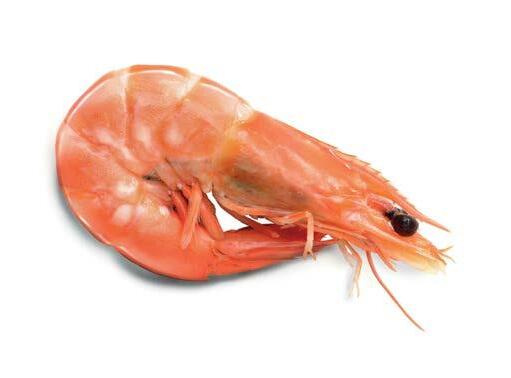
Handling
Frozen
• Thaw quickly at ambient temperature.
• Remove from carton and immerse in iced, salty water.
Fresh
• Green prawns begin to oxidise and blacken within several hours.
storage
• If thawed, place prawns on a draining tray on top of ice and keep in sealed container, refrigerate 0-4°C. Use within 24 hours.
• Best frozen at -15°C unpeeled with head intact. Place in a plastic container. Cover with water, seal and freeze. Keep for up to three months.
• Do not refreeze thawed product.
Serving
• If using for a hot dish, buy green and cook once.
• If using for cold dishes, buy pre-cooked.
• Suitable for a wide range of flavours and cooking styles.
• Heads add concentrated prawn flavour to bisques, soups or curries.
SOUTH AUSTRALIA HAS THE WORLD’S LARGEST POPULATION OF WESTERN KING PRAWNS.Western king prawns are fished sustainably in South Australia.
Most southern rock lobster is caught by pots set with bait, with 1,550 tonnes harvested annually.
region
• Industry split into two zones:
• Northern Zone: West of mouth of Murray River to Western Australia border. Lobster size can vary 550g–4kg.

• Southern Zone: East of mouth of Murray River to Victorian border. The largest zone and produces smaller size lobsters 500g–3kg, with an average meat to shell ratio 45-50%.
Season
• Northern Zone commercial season from November to May.
• Southern Zone commercial season from October to May.
appearance
Live
• Should be active.
• Have a hard red shell (to indicate no recent moulting).
• Limbs and antennae intact.
Cooked
• Brightly coloured, firm, with intact, lustrous red shell, no discolouration (particularly at joints).
• Pleasant fresh sea smell.
• Feels heavy for its size.
• Tails should be tightly curled.
• Flesh should be white/opaque with orange tinges.
Handling
• Most humane method of preparing live whole lobster is to put it to sleep in freezer for 30-45 minutess, before cooking.
• Approximately 30% of whole lobster considered grade one sashimi.
Storage
• Keep live lobsters in a secure container, covered with a damp cloth or paper, in warmest part of refrigerator (optimum 6°C) for up to two days.
• If keeping live lobsters in tanks, the recommended water temperature is 10-12°C.
• Wrap raw lobster in plastic wrap and place in an airtight container. Keep for up to 24 hours.
• Refrigerate cooked lobster, in shell, for up to three days at 0-4°C.
• Freeze whole (cooked or fresh) up to three months at below -15°C.
• Do not refreeze thawed product.
Serving
• Poach, bake, barbecue, grill, steam or sashimi.
• Complemented by chilli, herb butters, lemon or mayonnaise and most Asian flavours such as lemongrass, sesame oil, ginger or French flavours such as tarragon and thyme.
In shell
• Place cooked lobster on back, split length of shell from head to tail.
• Discard grey gills at top of the head.
• Remove digestive tract (grey thread) running down middle.
• Remove tomalley from cavity (green in raw lobsters and yellow/ orange in cooked). Can be used to enrich sauce or mayonnaise.
Meat only
• Twist tail away from head.
• In larger specimens, place cooked lobster on back and separate tail from head with sharp knife.
• Use kitchen scissors to cut down either side of the underside of the tail shell.
• Pull shell back and remove the meat in one piece.
• Shell can be used to create bisque and stock.
SOUTHERN ROCK LOBSTER IS SOLD WHOLE LIVE DIRECT TO RESTAURANTS HERE AND OVERSEAS.
SARDINES
South Australia has Australia’s largest sardine fishery by volume, producing 38,000 tonnes annually.


• Human grade sardine market is small but growing.
region
• Predominantly fished 30-50km off Port Lincoln.
Season
• Mostly completed Januarty to June.
• Winter: 8-10% flesh fat content.
• Summer: 10-12% flesh fat content.
appearance
• Size around 14-17cm.
• Meat yield is 40-45%.
Fresh
• Brilliant, deep red meat with translucent sheen.
• Clean, slightly metallic aroma.
• Soft and moist texture.
Cooked
• Rich and deep, meaty, sesame nutty flavour.
• Long lasting back palate with drying salty finish.
• Firm texture.
Handling
• Handle with extreme care as high fat content and fine bone structure makes them fragile.
Fresh
• Clean and gut if necessary.
Frozen
• Thaw quickly at ambient temperature.
Storage Fresh
• Place on dry kitchen towel, in airtight container.
• Refrigerate at 0-4°C for up to 24 hours. Frozen
• Freeze up to three months at -15°C.
• Do not refreeze thawed product.
Serving
• High oil content and robust flavour ideal to serve marinated and raw.
• Pan fry, grill, barbecue, smoke, or pickle.
• Care needed not to overcook.
• Complements bay leaves, breadcrumbs, chilli, cumin, currants, garlic, ginger, herbs, lemon juice and lime.
SOUTH AUSTRALIA HAS AUSTRALIA’S LARGEST SARDINE FISHERY BY VOLUME.
SARDINES HAVE A HIGH OIL CONTENT AND A ROBUST FLAVOUR AND CAN BE EATEN RAW.Sardines are a delicate fish best handled gently.
More than 95% of South Australia’s southern bluefin tuna is exported.
region
• Juvenile southern bluefin tuna are caught on the continental shelf in the Great Australian Bight then moved to open-sea ranches in Port Lincoln.
Season
• Wild juvenile bluefin caught December to March.
• Ranched December to September, farmed for around three months.
• Fresh: Available March to September.
• Peak season: June to July (when tuna has good winter fat).
• Available all year as frozen.
appearance
• Whole southern bluefin tuna average size is 35-40kg.
• Can grow up to 50kg.
• Colour and flavour depends on the cut:
• Otoro
• Found on the fatty belly section.
• Marbled pink colour.
• Sweet buttery flavour and long lasting umami finish.
• In peak season, 50% flesh fat content.
• Chutoro
• Found on the belly, behind otoro.
• Less fatty, pale pink/white colour.
• Slightly less sweet but clean and full flavour.
• Akami
• Top loin, shoulder or tail.
• Deep rich red.
• Lighter, more simple flavour.
• Can have slightly sweet taste on front palate.
• In peak season, 18% flesh fat content.
• Meaty umami, hints of pork crackling and underlying nutty flavour (cooked).
Handling Fresh
• Bloom into full colour soon after cutting.
• Bloom at ambient temperature to help colour develop and intermuscular fat to soften.
• Sashimi grade fish should be eaten within 24 hours of purchase or cooked.
• Maintains premium colour for about four hours if not refrigerated.
• If refrigerated at 0-4°C, full colour can last for 8-12 hours.
• Best kept in whole form with fillets removed as needed.
Frozen
• Defrost at ambient temperature overnight and use as soon as possible.
• Bloom at ambient temperature to help colour develop and to allow intermuscular fat to soften.
AN AVERAGE WHOLE SOUTHERN BLUEFIN TUNA WEIGHS 35–40KG AND IS AVAILABLE

FRESH OR FROZEN.
Storage
• If serving tuna in cooked form it can be refrigerated at 0-4°C for up to three days. Wrap tightly in plastic wrap or keep in airtight container.
• When freezing, wrap fillets tightly in freezer wrap, then plastic wrap and bury under ice in a leak proof container.
• Tuna can be frozen at -15°C for up to three months.
• Do not refreeze thawed product.
Serving
• Best enjoyed raw (as sashimi) or just warm.
• Some people like to remove the dark bloodline before cooking.
• Others enjoy bloodline for its stronger flavour.
SOUTHERN BLUEFIN TUNA IS KEPT IN OPEN SEA PENS OFF PORT LINCOLN.
South Australia’s diverse and abundant seafood industry offers a wonderful opportunity to present some of the finest quality seafood in the world on your menu.
With a little advice on preparing a few of South Australia’s unique seafood products and access to fresh product, you will be serving up an exceptional dish every time.
This masterclass provides expert advice on preparing calamari, Spencer Gulf Kinfish, King George whiting and blue swimmer crab, ready for use in your own recipes.




Don’t overlook the incredible potential of fish heads and frames. These parts are a hidden treasure for creating flavoursome stocks and broths. Extracting the essence from these components unlocks a world of rich and aromatic flavours, enhancing your culinary offering.
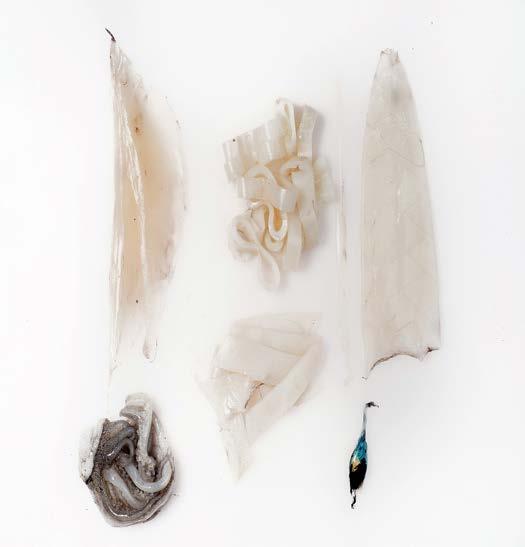
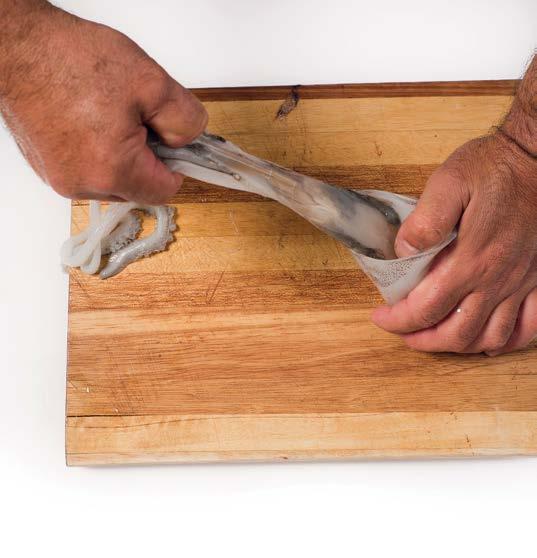
1. Cut under pectoral fin, just behind the head, slice on a diagonal on both sides. Pull head back sharply and snap off. (Head can be kept to make fish stock or to flavour miso soup.)



5. If you wish to remove skin (it can be eaten), hold tail firmly and pull skin against knife.


6. As boneless fillets, meat recovery is about 45%. However, in traditional Japanese style fillet (collar on, ribcage in), it is about 65%.

5. Again follow rib cage to fully remove fillet. Once both fillets are removed you should be able to see through backbone.
6. Remove central pin bones by making a small ‘v’ into each fillet. Also check all the rib bones have been removed. Most whiting offer 50% meat recovery.







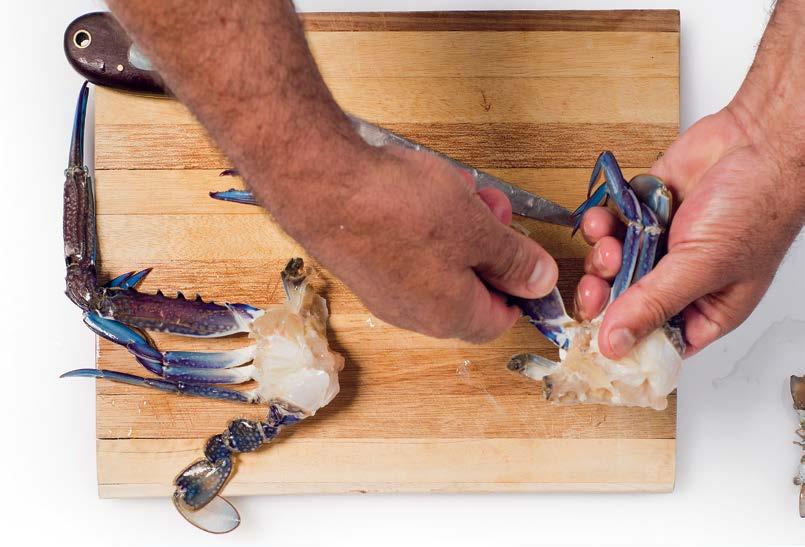




South Australia’s varied and distinctive food growing regions deliver a constant flow of premium produce throughout the year. The seasonality and harvest chart illustrates when South Australian grown produce is harvested and is most readily available in the market.
Apples – Fuji
Apples – Golden Delicious
Apples – Granny Smith
Apples – Jazz
Apples – Pink Lady
Apples – Red Delicious
Apples – Royal Gala
Apples – Sundowner
Apricots
Avocados – Hass
Avocados – Fuerte
Avocados – Gwen
Avocados – Lamb Hass
Avocados – Reed
Blueberries
Cherries
Figs
Grapes
Honeydew
Lemons
Mandarins
Nectarines
Oranges – Navels
Oranges – Valencias
Peaches
Pears – Buerre Bosc
Pears – Corella
Pears – Josephine de Malines
Pears – Packhams Triumph
Pears – Red Anjou
Plums
Raspberries
Rockmelon
Strawberries
Tangelos
Tomatoes – glasshouse
Tomatoes – field
Watermelon
Beans – Green
Beetroot
Bok Choy
Broccoli
Brussel sprouts
Cabbage
Capsicum – glasshouse
Capsicum – field
Carrots
Cauliflower
Celery
Chard
Chillies – glasshouse
Chillies – field
Corn
Cucumbers – glasshouse
Eggplants
Herbs – dried
Herbs – fresh
Leeks
Lettuces – whole, unwashed
Marrows
Mushrooms
Onions – brown, white
Onions – sweet
Parsnips
Potatoes
Pumpkin – Butternut
Pumpkins – Jap, Queensland Blue
Spinach
Squash – field
Squash – glasshouse
Turnips
Zucchini – field
Zucchini – glasshouse
Almonds
Chestnuts
Pistachios
Walnuts
Abalone – wild
Abalone – farmed
Calamari
Blue swimmer crab – Spencer Gulf
Blue swimmer crab
Kingfish
King George whiting – small
King George whiting – large
Mussels
Mussels – Petit bouchet
Oysters – Angasi
Oysters – Pacific
Oysters – spawnless
Pipis
Rock lobster – Northern zone
Rock lobster – Southern zone
Sardines
Southern bluefin tuna – fresh
Southern bluefin tuna – frozen
Western king prawns
Beef Game Lamb – spring lamb
Lamb – older lamb
Pork Poultry
Recommended storage information to help ensure your South Australian grown produce remains at its best. It is recommended you follow any specific industry standards or supplier instructions though.
As you’ve discovered by now, South Australia is home to an enormous variety of food, thanks to our pristine environment, quality practices, and passionate growers and producers.
Now it’s your turn to make the most of this this fabulous food too. To make it easy to source, we’ve included a link to the Food South Australia Directory.
In the Directory, you will find a description for each business plus contact details. Please note that only Food South Australia members have been included.
Find a food manufacturer, processor or producer here.

We would like to thank the industry representatives and food businesses who have assisted us with the revision and production of this guide, and particularly those who have assisted with updating information for this third edition, including:
Mandy Hall, Caroline Faulkiner, Mark Doecke, Michael Steer, SA Mushrooms and Citrus SA.
Third edition published in 2023 by:
Food South Australia Waite Campus
2b Hartley Grove, Urrbrae SA 5064 foodsouthaustralia.com.au
Publication date: June 2023
Second edition published in 2015 by:
Food South Australia Inc
Plant Research Centre, Waite Campus
2b Hartley Grove, Urrbrae SA 5064 foodsouthaustralia.com.au
Publication date: June 2015
First edition published in 2013 by:
Hardie Grant Media
Ground floor, Building 1, 658 Church Street, Richmond VIC 3121 hardiegrantmedia.com.au
in conjunction with:
Food South Australia Inc
Plant Research Centre, Waite Campus
2b Hartley Grove, Urrbrae SA 5064 foodsouthaustralia.com.au
This South Australian Food Users’ Guide has been prepared as a reference tool only. Whilst all reasonable care has been taken in the preparation of this Guide, users of this Guide should not act upon the information contained in this Guide and should in all instances, refer to relevant standards, instructions and recommendations contained in the Australia New Zealand Food Standards Code or provided by the supplier in relation to the proper storage, preparation and other handling of food items. Food South Australia assumes no responsibility for the information contained in this Guide and disclaims all liability in respect of such information. References to the Australia New Zealand Food Standards Code and other third party material contained in this Guide are current only as at the publication date and subject to change. Food South Australia reserves the right to amend, revise and/or republish this Guide at any time. Food South Australia assumes no responsibility for advising users of this Guide in respect of such amendments, revisions or republications and disclaims all liability in respect of any failure to notify users of this Guide of such amendments, revisions or republications.
Copyright
This Guide contains material copyright in which belongs to Food South Australia. No part of such material may be copied or reproduced without the consent of Food South Australia. This Guide may contain material copyright in which belongs to third parties. No consent given by Food South Australia constitutes consent to the copying or reproduction of such third party material by any person. Text copyright © Food South Australia.
Original photography:
Nick Clayton, except Laucke Flour Mills p10, San Remo p25, Haigh’s Chocolates p32, Enzo’s at Home p35, Neville Bonney p68, p69, Barossa Fine Foods p76, Hotdog Fisheries p91, Australia’s Seafood Frontier p92, p93, p102, Southern Exporters Australia p94, Aussea p100, Southern Rock Lobster Ltd p101. 2015 © Food South Australia. Other photography © Shutterstock.
Please refer all enquiries in respect of this Guide to Food South Australia.
Reception: Plant Research Centre, Waite Campus,
2b Hartley Grove, Urrbrae SA 5064
Post: PO Box 124, Glenside SA 5065
Phone: +61 (0)8 8303 9435
Fax: +61 (0)8 8303 9424
Email: contact@foodsa.com.au
Web: foodsouthaustralia.com.au
Facebook: /foodsouthaus
Twitter: @foodsouthaus
Instagram: @foodsouthaus
The South Australian Food & Beverage Users’ Guide is for chefs, cooks, purchasing managers and caterers, to use in your restaurants, cafés, pubs and all other food establishments.
The Guide covers bakery, beverage, cereals & grains, convenience, dairy & eggs, fruit & vegetables, meat, poultry & game, and seafood with detailed technical information on, storage & handling, appearance, serving ideas and more.
In addition, you’ll find unique masterclasses and charts on seasonality and harvest as well as storage. This Guide gives you everything you need to put South Australia’s fresh and innovative produce on your menu.
